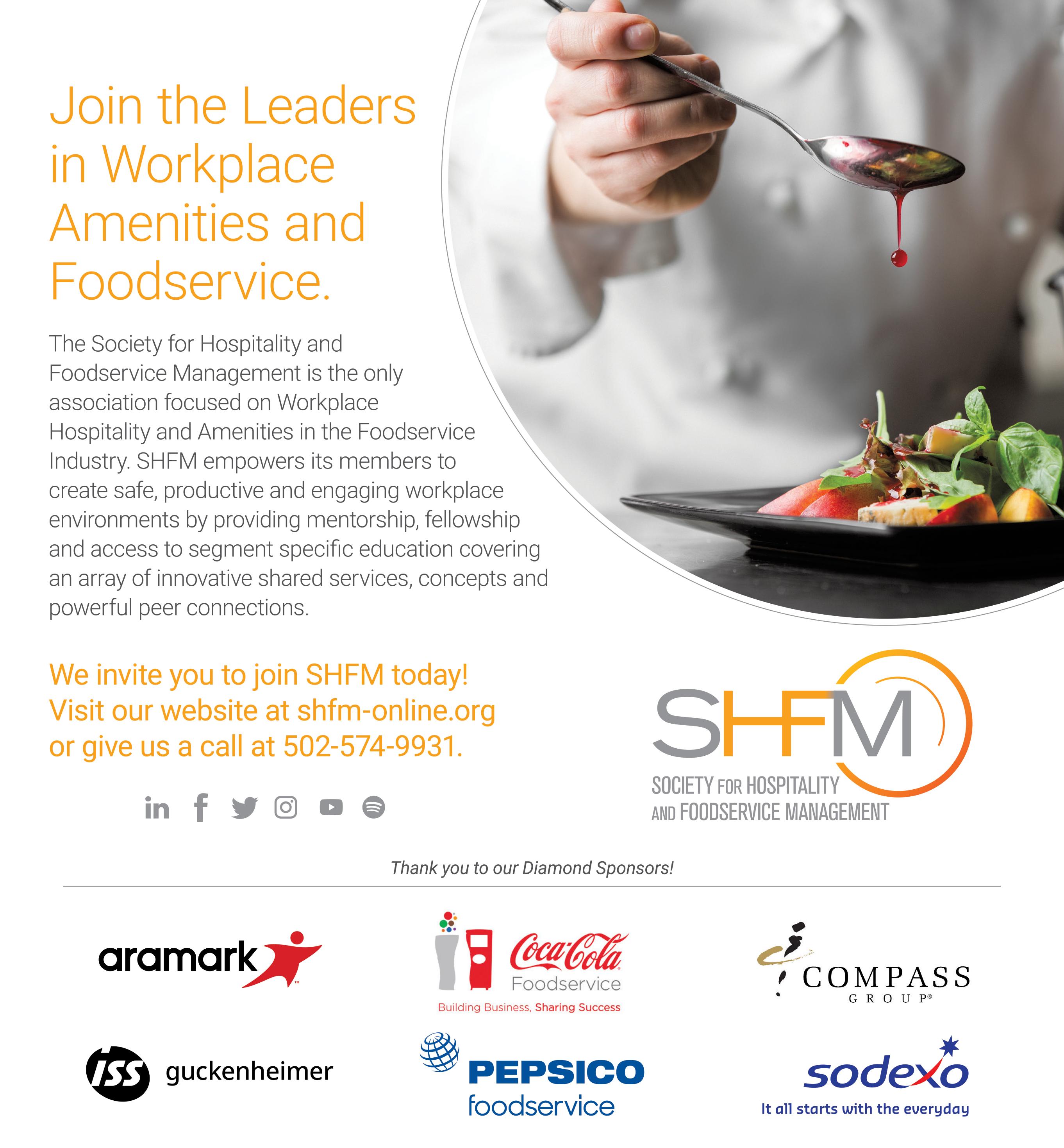




Senior dining is evolving beyond traditional assisted living meals, mirroring a transformation seen in college cafeterias. Just as universities realized that offering diverse, appealing food options could encourage students to dine on campus—and boost revenue—today’s seniors are demanding variety and flexibility. They no longer want to eat in the same dining area or follow a rigid schedule. This shift has created a need for a fresh approach to senior dining, where multiple venues, personalized menus, and restaurantquality experiences cater to their desire for choice, socialization, and culinary exploration.
As the landscape of senior living continues to evolve, the introduction of Restaura, a new dining service company co-founded by industry veterans Richard Schenkel and Joseph Cuticelli, promises to transform the way food is experienced in senior living communities. The duo, both seasoned leaders with decades of experience in the senior dining sector, bring a bold, innovative approach to meet the ever-changing expectations of today’s seniors.
Restaura’s launch couldn’t come at a more opportune time. Senior living communities are grappling with the challenge of serving a demographic that values not only nutrition but a dining experience that reflects their active and vibrant lifestyles. According to Schenkel, the firm’s President & COO, “The traditional model for senior dining has grown outdated, and
it’s clear that today’s seniors expect much more than institutionalized, one-size-fits-all meals.”
Schenkel and Cuticelli both recognized the significant gaps in the current senior dining model. Schenkel, who has led several successful ventures in the senior dining space, reflected on this shift. “When we first started discussing Restaura, it became apparent that seniors today want more control, choice, and transparency in their dining experience. They are more health-conscious, more connected to food trends, and they demand higher-quality ingredients.” Cuticelli, Restaura’s CEO added, “It’s not just about food anymore—it’s about creating an experience. Our seniors are discerning consumers who want fresh, local, and nutritionally balanced meals, delivered with the same quality they’d expect in any top restaurant.”
This shift has presented a unique challenge for senior dining operators. Traditionally, many communities have relied on fixed menus, limited choices, and a somewhat rigid approach to meal services. This formula no longer appeals to a generation of seniors who are healthier and more engaged in their wellness journeys than ever before. “The days of offering a few rotating dishes are over,” Cuticelli explained. “Today’s seniors want variety, and they want to be able to customize their meals based on their dietary needs and preferences.”
continued on page 108
“It’s not just about food anymore—it’s about creating an experience. Our seniors are discerning consumers who want fresh, local, and nutritionally balanced meals, delivered with the same quality they’d expect in any top restaurant.” - Joseph Cuticelli


BBianco Hospitality, a wellestablished leader in the management of high-end restaurants and hospitality services, is set to make a major mark on the New York dining scene with the opening of Santi, a much-anticipated Italian restaurant in the fall of 2024. As the latest addition to their growing portfolio, Santi represents both a bold new chapter for BBianco and a return to form for Chef Michael White, a celebrated name in Italian cuisine.
Founded in 2020 during the pandemic by Bruce Bronster and chef Michael White, BBianco Hospitality capitalized on its team’s extensive experience across both hospitality and
“The lighting will be soft, the staff welcoming, and the aroma of fresh basil will linger in the air. Every element has been designed to evoke the feeling of being in a cozy trattoria in Italy.” — Bruce Bronster
legal management. Bronster, who came from a legal background and had dabbled in restaurant ownership, saw an opportunity to build a company that combined a deep understanding of the legal challenges of the hospitality industry with a passion for fine dining.
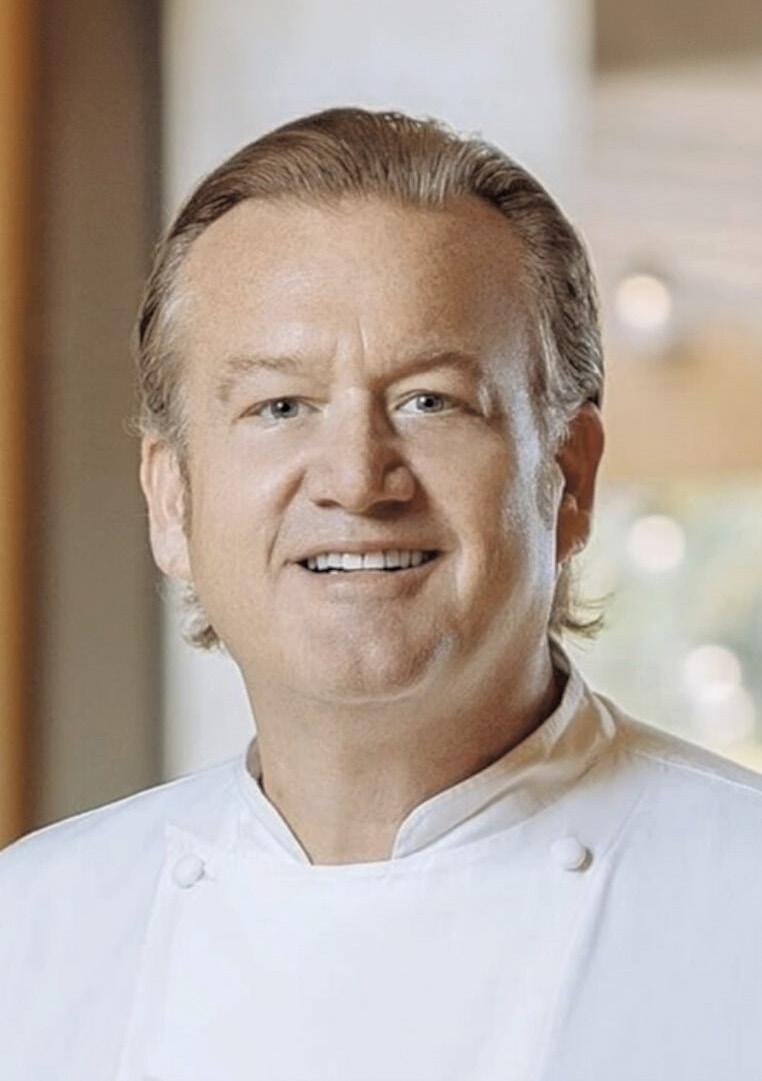
“We wanted to create something forward-looking,” Bronster explained. “We saw the challenges restaurateurs were facing, from staffing shortages to intense competition in markets like New York, and we wanted to provide a solution that would help restaurants not just survive but thrive.”

BBianco has since expanded rapidly, offering services that go beyond traditional restaurant management. With a roster of esteemed locations, such as Paranza in Atlantis Paradise Island and Mirabella in Fontainebleau Miami Beach, BBianco has established itself as a trusted partner for luxury dining experiences.
The upcoming opening of Santi in New York is poised to be a landmark event for both BBianco and the city’s culinary scene. Located in a historic space once home to Chef White’s previous ventures, Santi aims to reinvigorate Italian dining with a modern twist.
According to Bronster,
continued on page 107

continued on page 102





Last month nearly 5,000 restaurant, pizza, and foodservice industry professionals, representing a 51% increase in buyers, were at the Los Angeles Convention Center for The California Restaurant Show which for the first time included the Pizza Tomorrow Summit Pavilion. The sold-out trade show floor featured 220+ exhibiting companies, with 50% of them new to the show, offering new food, drinks, technology, equipment, tableware, and much more. The education program, developed in partnership with the California Restaurant Association and a brand-new Conference Advisory
Board featured 60+ speakers, dozens of culinary competitions, demonstrations, and a sold-out Food and Wine pairing. The tradeshow and conference was colocated with the Coffee Fest Los Angeles which attracted thousands of additional coffee shop owners and industry professionals.
“We renamed the event to the California Restaurant Show earlier this year and are thrilled with the industry response. We saw a 51% growth in attendees, 55% new to the event, and had 100 new exhibitors. All in all, a very successful event,” said Glenn Celentano, Partner & CEO of Restaurant Events LLC, produc-


ers of the event. “We thank all our exhibitors, especially our lead sponsor Sysco Los Angeles, and our long-standing partner, The California Restaurant Association. We were also thrilled to welcome the Pizza Tomorrow Summit exhibitors to a new Pavilion and the US Pizza Team who held three days of exciting competitions.”
The education program featured 40+ education sessions with new content and new culinary demonstrations and attracted standing room only crowds to all the sessions. There were many new sessions including a sold-out Food and Wine pairing event, featuring Mas-

ter Sommelier David Glancy of the San Franscico Wine School. Other sessions focused on Hottest Trends in Food and Beverage, Increasing Food Friendly Financials, Steps to Great Service, Digital Hospitality, Effective Leadership, Team Building, Food and Beverage Trends, Legal Advice, Workplace Violence, FDA’s Traceability Rule, Reducing Food Loss and Waste, AI’s Impact on Foodservice, Direct Mail, Negotiating Leases and much more. As part of the education program, The California Restaurant Association hosted two sessions - Legal
continued on page 118

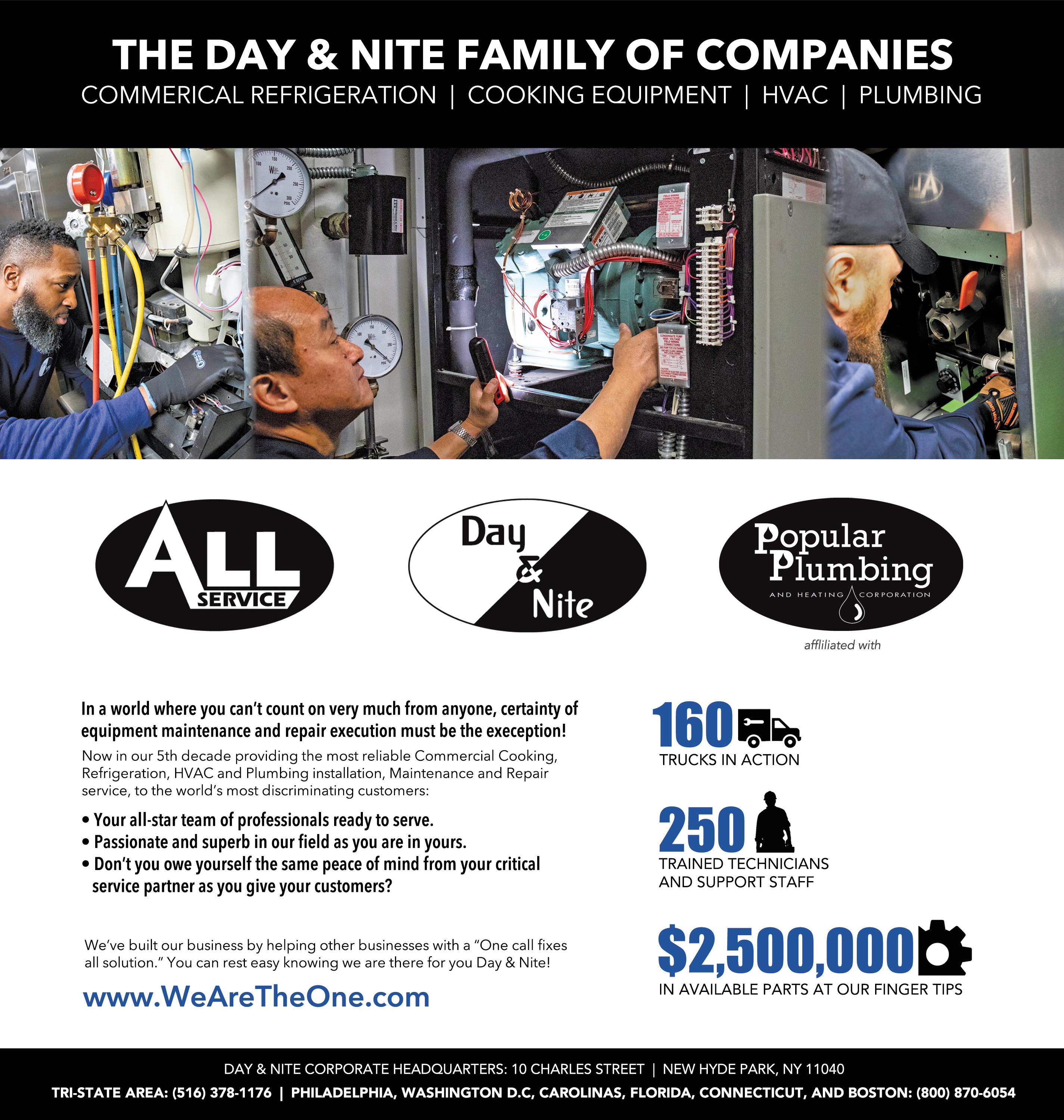

In July 2023, Kristen Kish was named the host of Top Chef with season 21, after Padma Lakshmi stepped away from the franchise to pursue other efforts.
She was no newcomer to the show. Kish competed in Bravo’s Top Chef in 2012, season 10. She was invited to participate in the qualifying rounds alongside her friend from culinary school Stephanie Cmar. She created a signature soup that was judged by Emeril Lagasse, passed the challenge and moved on to the competition. From there, she won four elimination challenges before being eliminated in Restaurant Wars (episode 11). She was able to win her way back into the main competition with five consecutive victories in Last Chance Kitchen, making it to the finale with Brooke Williamson. She defeated Williamson and was crowned the Top Chef, becoming the second female winner in the history of the Top Chef franchise.
She is also the host 36 Hours on Travel Channel, a co-host of Fast Foodies on TruTV, a co-host of Iron Chef: Quest for an Iron Legend, and host of National Geographic’s Restaurants at the End of the World.
Kish was born in South Korea and was adopted by a family in Kentwood, Michigan, at the age of four months. She attended Le Cordon Bleu in Chicago, earning an A.A. in Culinary Arts. Kish became an instructor at Stir, a culinary demonstration kitchen in Boston, Massachusetts. In 2012, Kish was promoted to Stir’s chef de cuisine by the owner, Barbara Lynch. She was the chef de cuisine at Barbara Lynch’s Menton in Boston until March 2014. In 2017, she released a book of recipes co-authored

Joyce Appelman is the SCOOP News Editor and Senior Contributing Writer for Total Food Service and previously the National Communications Director for C-CAP, Careers through Culinary Arts Program. An industry leader supporting education and scholarships, she has been instrumental in opening career opportunities for many young people in the foodservice industry. Email her at joyceappelman@gmail.com
with Meredith Erickson, Kristen Kish Cooking: Recipes and Techniques. Since 2018, Kish has been the chef at her new restaurant Arlo Grey in Austin, Texas. Meet Kristen Kish, the host of culinary our favorite culinary shows!
Walk us through your career track and how you found your passion for the culinary field.
It all started with cooking shows on TV when I was five years old, Great Chefs of the World - it was very minimal production and just cooking. I gravitated towards it and it all just took off from there. I became enamored with the process of cooking. TV allowed me to learn and travel through the screen.
Tell us about your experience as an instructor at Stir, a culinary demonstration kitchen in Boston, Massachusetts.
Stir was a special job where I learned incredible skills that I may have not learned in a traditional restaurant setting. How to talk to guests, guide them through a meal, dance the dance all within a very intimate space. It was a chef’s table dinner every night. I learned how to be comfortable in front of people and entertaining them all while creating a delicious meal.
In 2017, the book of recipes co-authored with Meredith Erickson, Kristen Kish Cooking: Recipes and Techniques
continued on page 112


To get a sneak peek of food trends before they go big, there’s no better place than the Fancy Food Shows. Industry expos showcasing the newest products across the entire specialty food landscape, the Fancy Food Shows are chockfull of innovation, offering attendees a first look at where consumer tastes, values, and preferences are headed.
For 10 Gen Z attendees of the 2024 Summer Show this past June in New York City, five trends rose to the surface. Read on to learn what these next-generation food experts—all students in the Drexel Food Lab program—found most noteworthy as they explored more than 330,000 square feet of specialty products.
Innovation in beverages continues, with a number of trends to watch: sparkling, cocktail-inspired, and offering clean labels and health benefits without compromising on taste. Brands like Kombucharista combine multiple elements with non-alcoholic, gut-healthy, prepared mocktails. Bluestem Botanicals (organic mocktail kits with herbs) and Seraphim Beverages (non-alcoholic wine) display the depth of NA offer-

ings. Ceybon comes in with mushroominfused concentrates, and Unity offers natural energy drinks with adaptogens. Finally, the dry beverage market has also expanded. Pinky Up offers boba in a tea bag while Everydaze Reset Kombucha has powdered kombucha in a variety of flavors.
If you ever wanted to make a loud announcement when walking into a room, you now have endless edible means to do so. In the snack category, new methods of producing snacks, ingredients, and flavors show the rewards of experimentation. Mr. Mushroom features vacuum-fried vegetables, from its namesake to tomatoes and lotus root. Similarly, freeze dried snacks are continue to evolve through new offerings from brands like Uptop Treats and Pocas. In just one example of the creative potato-chip boom, Bret’s Chips showcased flavors like camembert and summer truffle. Everyone is bound to find a new favorite snack!
More than 56 countries were represented at the Summer Show, and flavors

from every corner of the world were on display. Sauces and spices are walking the specialty-to-mainstream path of Sriracha, with offerings from Watcharee (Thailand), Perfeito (Brazil), HOXY (Korea), and Brundo (Ethiopia). Prepared foods like Xinca’s pupusas, Doro’s Cheesy Korean Rice Cakes, and snacks from HBAF (tteok-bokki almonds and cheeseburger popcorn!) exhibit how global flavors have popularized across the industry.
As gluten-free snack innovation continues, we see a wider variety of featured alternatives. Diggables strays from the traditional with buckwheat puffs. In the same vein, Sorghum Symphony’s puffed snacks include global flavors like churro and curry while Yuca Balls offers a crunchy cassava snack. Ieialel offers dehydrated fermented millet flour while Local village has ready to eat sorghum grain in brine along with their sorghum, teff, and tiger nut flours. For Good granola features buckwheat in their oat free granola. Yolélé has expanded fonio to the American market with chips made from the African grain.
Trend 5: Honey Everything
Honey’s moment continues. From hot honey to tea and sauces, you scarcely walk an aisle without tasting a honey product. Explorer has a honey chai concentrate and Savannah Bee Company launched a honey hot sauce. Fresh Fizz sweetens their sodas with honey. Casa Folino’s set out a wide array of flavored honey like bergamot, lemon, and balsamic. Bumbleberry farms featured their peach vanilla cream spread. Zen Bear has a selection of honey teas. Honey B has a sparkling honey drink… and the list goes on.
Get a first look at what comes next for these trends at the 2025 Winter Fancy Food Show, January 19-21 in Las Vegas at https://www.specialtyfood.com/fancy-food-shows/winter/
Reported by the Specialty Food Association Junior Trendspotters: Felicia Yan, Belinda Faakye, Zae’Onah Howell, Adam Gladstone, Victoria SanchezGalarza, Alessandra Mora, Alex Ly, Gabe Thayer, Jocelyn Leal, and DeAndra Forde, led by Drexel Food Lab Associate Director Chef Rachel Sherman, Drexel University Professor Jonathan Deutsch, and Chef Brooke Olasewere.

When it comes to delivering the perfect fountain beverage, the quality of water cannot be overlooked. At Pentair, we understand the pivotal role water filtration plays in ensuring that every sip of soda is as refreshing and effervescent as intended. Whether you’re operating a convenience store, a bustling restaurant, or simply seeking the ultimate beverage experience, addressing water quality is the key to perfection.
The essence of a great-tasting soda lies not only in its flavor but also in its fizz. However, achieving and maintaining the perfect carbonation can be a challenge if the water used is not properly filtered. Here’s why water filtration is vital for fountain beverages:
1. Reducing Total Dissolved Solids (TDS) for Optimal Carbonation: High levels of TDS, particularly bicarbonates, can neutralize the carbon dioxide in sodas, leading to a flat and unappealing drink. By reducing TDS, filtration systems ensure that sodas retain their lively fizz, enhancing the overall beverage experience.
2. Preventing Scale Buildup for Efficient Equipment Operation: Scale buildup is a common issue in fountain and ice-making equipment, often resulting from high mineral content in unfiltered water. This not only affects the performance and longevity of the equipment but can also impact the taste and appearance of the beverages. Water filtration solutions are designed to reduce scale, ensuring that your equipment runs optimally and your beverages remain consistently high quality.

3. Enhancing Taste and Odor for Authentic Flavor: Water impurities can significantly alter the taste and odor of fountain beverages, leading to a drink that doesn’t quite taste right. Whether it’s a classic cola or a customized soda blend, the flavor profile should be crisp and true to its original formulation. Filtration systems effectively reduce contaminants that affect taste and odor, guaranteeing that each beverage tastes exactly as it should.
Understanding the chemistry of carbonation and the impact of water quality on fountain beverages highlights the importance of effective filtration. The presence of excess bicarbonates in water, for instance, is a common culprit behind flat sodas. By implementing advanced filtration technology, businesses can directly address these issues, ensuring that the carbon dioxide remains in the beverage, preserving its intended bubbles and

flavor.
For any establishment priding itself on offering the best in fountain beverages, the importance of water filtration cannot be overstated. With Everpure, you have a partner committed to ensuring that every glass of soda served is not only delicious and refreshing but also a testament to quality and consistency. Whether it’s preventing a soda from going flat, reducing scale in equipment, or ensuring that a cola tastes unmistakably like a cola, the impact of water filtration on fountain beverages is clear and significant.
Check out our H2O Express Test Kit at Pentair.com to help determine the right system, ensuring your equipment is safeguarded and water quality is optimized for better food and beverage quality. Choose Everpure for water filtration solutions that elevate your beverage service to new heights.


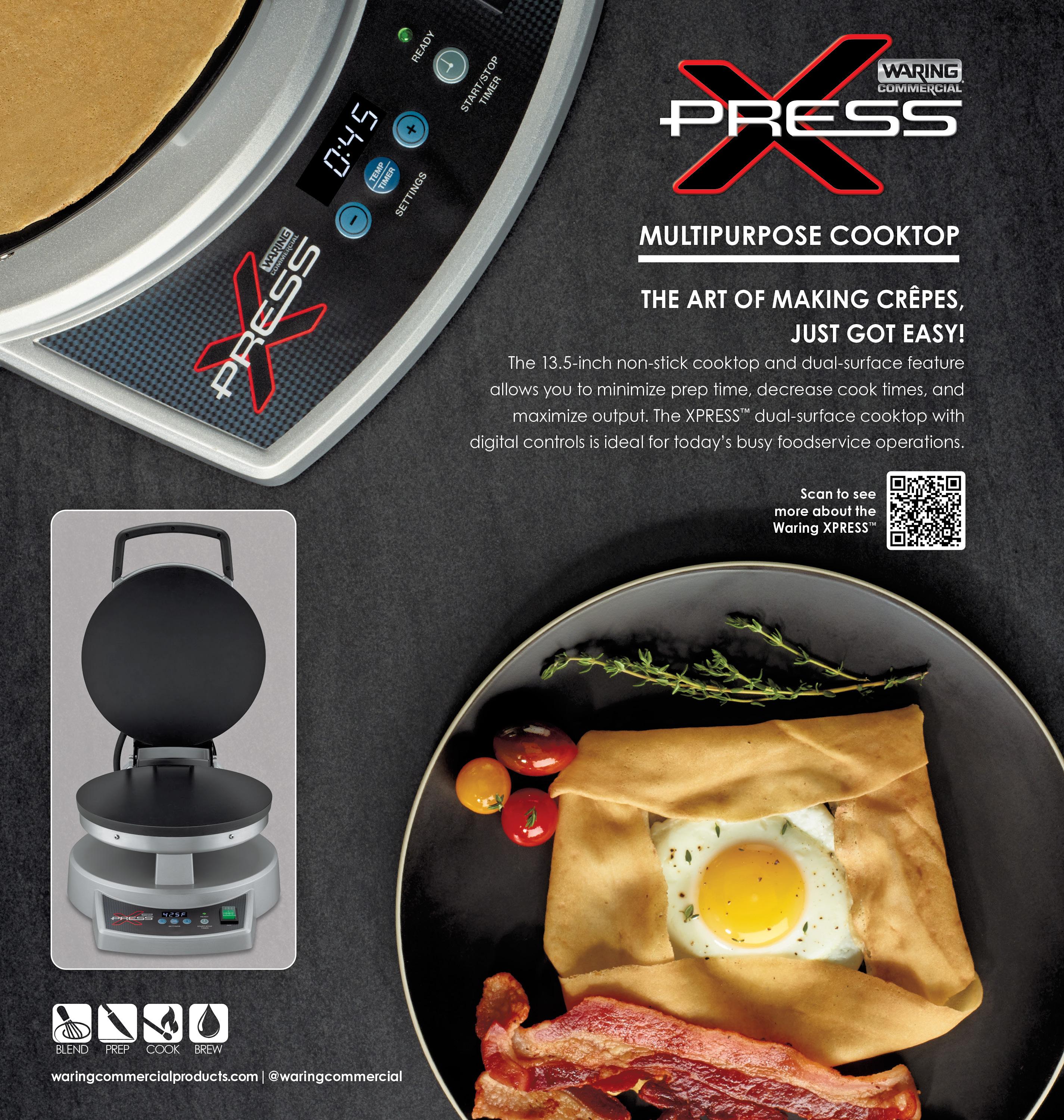

Events hold a special place in society by combining several enjoyable activities into one experience that facilitates connection and inspires. Attendees are united in some sort of commonality: a cause, shared passion, or connection to a person or organization.

Every event is unique, and can include such varied formats as golf outings, professional conferences, charity galas, or weddings and private parties. There is no one-size-fits all event, and so every detail, from décor to entertainment to catering, must reflect the purpose and theme of the event. Yet like most industries, the event industry is beholden to trends. Let’s look at the trends impacting events today and the opportunities they bring event planners.
Individuals are increasingly aware of the environmental aspect of their choices and the choices of corporations and organizations. Increasingly they aren’t as impressed by huge one-time-use displays, instead thinking about the waste. Fortunately, there are many ways to have an impressive event with less waste.
Think creatively about the swag or favors given to guests and refrain from giving out excessively packaged items or things that will sit in a drawer or on a shelf gathering dust. Things that they

will use often, wear, or consume are all better options than another stress ball.
Some décor can be repurposed as favors for guests to achieve several purposes. For instance, instead of cut flowers, live plants can be used as centerpieces and guests can take them home at the end of the event. This is sustainable, provides guests with a memorable favor they’ll enjoy, and cuts tear down time at the end of the event. Other solutions also pull double duty - instead of candles with paraffin wax, battery-powered candles can be used. This small change is cheaper in the long run for event planners, safer since there is no flame, and better for the environment.
Think twice about confetti cannons, fireworks, or excessive balloon usage. Does it add value and fit the theme appropriately, or are there better alternatives that are also more eco-conscious?
Other items can be made from recycled or recyclable materials. Or, eliminate the paper altogether. Menus, table signage, and agendas are just some examples of things that can be centrally located on a reusable display or entirely
digital. Many of these sustainable alternatives require little additional work and often serve the organization as well by saving money in the long run.
Using Technology Creatively Technology is always advancing, and keeping up with the latest developments can enhance events. On the logistical side, technology can be used to create a smoother experience for guests. They can RSVP or register online; receive critical information about the agendas, menus, or seating assignments; and check out or pay online. This eliminates waiting in lines and provides a great guest experience. Apps can use push notifications to tell guests when the next item on the agenda is about to start or when it’s time for last call at the bar. These logistical details are necessary for a smooth event, and using appropriate technology is often the best way to handle these details without detracting from the ambiance of the overall event.
Event themes and décor can be en-
continued on page 110

Sports have the power to transform quiet dayparts into vibrant, profitable opportunities for restaurants and bars. While sports betting from fantasy to pools has long been popular, the true magic may lie in creating a community hub where fans unite to cheer on their favorite teams.
Sharing the space with fellow supporters, singing chants, and celebrating together turns a simple morning game into an experience that lasts all day. By tapping into this energy, venues can draw in crowds during typically slow hours, fostering both loyalty and a sense of belonging— ultimately creating a new, powerful profit stream.
In several neighborhoods of New York City, Olde City Pubs has managed to carve out a unique space in an already bustling pub landscape. The pub has achieved remarkable success by uniting two seemingly distinct groups: local fans of the English Premier League’s Arsenal Football Club and Philadelphia expats working and living in the city. Under the leadership of Evan Stein, Founder and Chief Operating Officer of Olde City Pubs, the establishment has grown into a lively, energetic venue that celebrates the spirit of sports, camaraderie, and local pride. Stein’s vision for Olde City Pubs is a testament to how sports, culture, and community can blend seamlessly into a single, welcoming space.
When Evan Stein opened the Chelsea location in Manhattan of Olde City Pubs, it was designed with a specific sports culture in mind—one that would tap into New York City’s robust soccer scene. Though he wasn’t initially an Arsenal

supporter, Stein recognized the potential of attracting the passionate Arsenal fan base. “I met with some of the key leaders of Arsenal’s New York City supporters’ group before we even opened,” Stein explained. “I told them, ‘I’ll make this place the best Arsenal bar you’ve ever seen.’ We’ve stayed true to that promise.”
justing to the unique schedule of Premier League matches, which are often held during unconventional hours for New York bars. Early morning games, starting as early as 7:00 a.m., present logistical challenges, from staffing to stocking the right supplies.

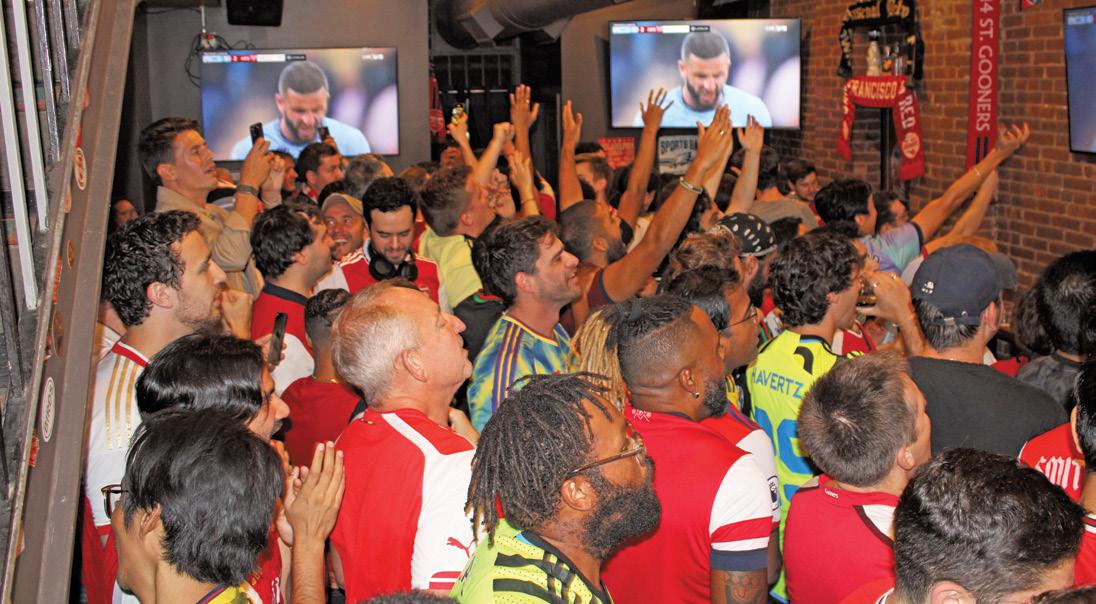
And indeed, Olde City Pubs has become known as the destination for Arsenal fans in Manhattan. The pub is adorned with Arsenal colors, and even the building itself is painted in the iconic red and white hues of the football club. The Arsenal crest proudly decorates the exterior, a feature that draws in passersby who can often be seen taking pictures outside the establishment.
The fan base has grown rapidly since Olde City became the headquarters for Arsenal’s official NYC supporters. Whether it’s a Saturday morning 7:00 a.m. kickoff or a mid-afternoon match, the pub is packed with fans clad in red jerseys, cheering loudly for their team. “It’s not just about watching the games,” Stein noted. “It’s about the experience—coming together to root for a common cause. You can feel the energy in the room. These fans are incredibly passionate, and we’re proud to give them a home.”
One of the challenges— and opportunities—Olde City Pubs has faced is ad-
“We’ve had to get creative with managing those early hours,” Stein said. “For the morning games, Arsenal supporters tend to favor Guinness—it’s our bestseller by far during those times. And we’ve developed a breakfast menu to complement that.”
The breakfast offerings at Olde City Pubs go beyond your typical pub fare. Stein has incorporated nods to his Philadelphia roots with unique items like broccoli rabe and egg sandwiches and house-baked hoagie rolls sourced from a bakery in Philadelphia. “We want to give our customers a reason to come early and stay through the game,” Stein added. “The breakfast sandwiches are a huge hit, and they’ve become a tradition for our regulars.”
In addition to being an Arsenal hotspot, Olde City Pubs is also a welcoming haven for Philadelphia transplants. Stein, who grew up in the suburbs of Philadelphia, understands the strong ties that Philly natives have to their hometown sports teams, even when living in New York City. At Olde City Pubs, Philadelphia sports are always a priority. Whether it’s an Eagles game on Sunday or a Phillies game during the MLB season, Stein ensures that Philly fans feel at home.
“We have a lot of Philly expats who live in New York and miss that connection to home,” Stein explained. “I wanted to create a space where they could watch their teams and feel like they’re back in Philly, even if they’re a couple of hours away.”
continued on page 110

When we think about crafting a cocktail, the mind often drifts to the spirits, bitters, mixers, or even the garnishes. However, one crucial element that often gets overlooked is the glassware. As a bartender and beverage professional, I’ve come to understand that the right glass doesn’t just hold a cocktail—it becomes an essential ingredient in the overall experience. In the world of cocktails, glassware plays a role just as vital as the ingredients that fill it, shaping the drink’s narrative, enhancing its flavors, and amplifying the guest’s sensory journey.
When I first began my journey in mixology, I was taught that the glass is simply a vessel—a means to an end. But as I evolved in my craft, I realized that glassware is so much more than that. It’s the canvas that frames your creation, the stage that sets the scene. The choice of glass can transform a cocktail, elevating a simple drink to a memorable experience.
Consider the difference between serv-

ing a martini in a coupe versus a classic V-shaped martini glass. The coupe, like Reserve by Libbey’s Prism Coupe, with its round, elegant shape, adds a touch of old-school glamour, evoking images of roaring twenties speakeasies and sophistication. On the other hand, the sharp lines of a V-shaped martini glass give off a sleek, modern vibe, making the same cocktail feel contemporary and bold. Each glass tells its own story, and as bartenders, it’s our job to choose the right one to complement the narrative we’re crafting.


Beyond aesthetics, glassware can significantly impact the flavor and aroma of a cocktail. The design of the glass can either concentrate or diffuse the aromas, which plays a critical role in the overall tasting experience. For example, a glass with a narrow rim, like a flute or a snifter, captures the bouquet of a drink, funneling the aromas directly to the nose as you sip. This is why flutes are favored for champagne—to preserve the delicate bubbles and enhance the olfactory experience, making each sip an explosion of flavor and scent.
Similarly, the thickness of the glass can influence the temperature of the cocktail, which in turn affects the taste. A thick-walled glass might retain coldness longer, making it perfect for drinks like Old Fashioneds, where the slow dilution from melting ice is part of the experience. Conversely, a thin-walled glass, such as the Reserve by Libbey Renewal Rocks glass, allows for more rapid temperature change, which can be ideal for sipping spirits neat.

As much as glassware influences flavor and aroma, it also plays a subtle, yet profound, role in the psychological experience of a cocktail. We eat—and drink—with our eyes first, and the way a cocktail is presented can set the tone for the entire experience.
Take, for example, the swizzle cocktail. When I select a specific glass for a swizzle, I’m thinking about how my guests will interact with it visually and physically. I know that certain shapes draw the eye to specific parts of the drink, perhaps to the layers of crushed ice, or to the garnish that crowns the top. The glass becomes a focal point, guiding the guest’s attention and enhancing their anticipation before they even take a sip. Color also plays a critical role. A clear glass allows the vibrant hues of a cocktail to shine through, creating an immediate visual appeal. This is where the psychology of color comes into play. Bright, citrusy colors like yellow and orange are
continued on page 124
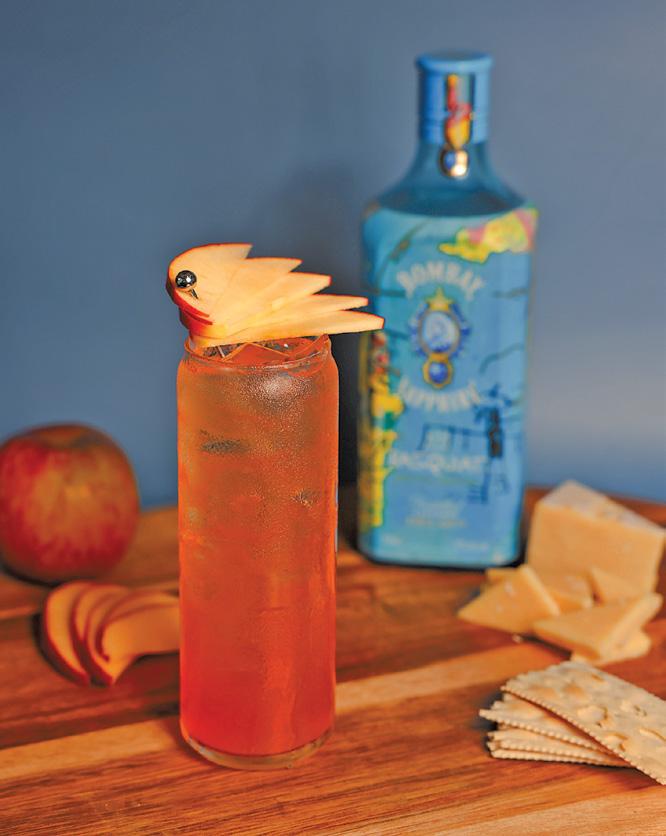

Benares entices a broad spectrum of diners—vegans, vegetarians, omnivores, pescatarians, and those with mixed dietary preferences.
Research shows that restaurants offering a variety of plant-based and plant-forward dishes are more likely to attract mixed groups. A 2021 survey by Restaurant Business Online found that restaurants with diverse menu options appeal to vegans, vegetarians, and their meat-eating friends alike. This inclusivity allows vegans and vegetarians to suggest restaurants they know everyone will enjoy, creating a shared, positive dining experience.
When I first heard about Benares, an Indian restaurant that began in New York City and later expanded to New
Jersey, I was intrigued by its reputation for offering a tempting array of vegetarian dishes, alongside tandoori specialties and a variety of seafood and meat dishes. Indian cuisine is renowned for its depth of flavor, and Benares appears to elevate this tradition with a careful balance of bold, plant-forward options and savory meat offerings.
To better understand how Benares balances the desires of plant-forward diners with those of omnivores, I interviewed Mr. Ranbir Bhatia, General Manager and Catering Director, Benares NJ, to discuss the restaurant’s vision and success.
Can you tell us about your background and what led you to enter the hospitality business?

From childhood in Chandigarh, India, as the oldest in my family, I was respon-
sible for setting up the dinner table and bringing food to the table. As I finished my schooling, a catering college opened in my hometown in 1974. I didn’t know what to do professionally, then my dad said, why don’t you get into the catering business? And that’s all I’ve done my whole life!
During college, I trained at Taj Mahal Intercontinental Hotel in Mumbai and my first job was with the Mumbai Sheraton New Delhi. That’s where I met my wife. Then it was on to the Hyatt Regency, also in India. I arrived in the US in 1987 and worked at Akbar in NYC and Long Island; then became a partner at Bombay Harbor. I also did stints at Ruby Tuesday and Denny’s along the way. We launched the Benares concept in 2008 in midtown Manhattan, then expanded to New Jersey five years ago. Our TriBeCa location is still in operation.
Your restaurant, Benares, is named after one of the oldest living cities in the world—Varanasi. What inspired this name, and how does the city’s


Cherry Dumaual is a seasoned contributing writer for Total Food Service, bringing years of experience in culinary communications to her role. As the former Partnerships Director at The Monday Campaigns/Meatless Monday, she was responsible for spearheading the PR and partnership development for Monday initiatives, including Meatless Monday. During her tenure, she successfully forged partnerships with renowned organizations, such as C-CAP (Careers for Culinary Arts Program), the American Institute of Cancer Research, and New Jersey Healthy Kids Initiative. Prior to joining TMC, Cherry held the position of Senior Vice President at leading PR agencies, where she worked with major food and healthcare clients. Her passion for learning and cooking international cuisines has led her and her husband to explore local food markets and restaurants in over 50 countries. This firsthand experience has allowed her to gain a deep understanding of different cultures and cuisines, which she brings to her work in the food industry.
significance influence your restaurant’s philosophy?
Our vision was to present the entirety of India’s vast culinary culture as best we could. Originally Indian restaurants here in the tri-state area would focus on Northern cuisine or Southern. Benares is in the middle of the country, the university there is one of the oldest in the world, it’s a deeply religious heritage and a very rich culture. That’s what inspired us.
While Benares is renowned for its tandoori meat and seafood, it also has a robust selection of vegetarian dishes. How do you ensure that these offerings are exciting enough to draw in both vegetarians and their omnivorous friends?
Our menu is made to appeal to everyone, with a thoughtful selection of dishes—vegan, vegetarian, and more—that are staples across different regions of India. Guests often tell us that our food
continued on page 108

Article by Andrew G. Beres & Katya Hammer,
We’re definitely feeling reinvigorated after this year’s Roots Conference! Singer Equipment Company was proud to sponsor Roots 2024: REINVIGORATE and head to The Chef’s Garden in Huron, Ohio to attend this unique conference. Roots brings together innovators from across agriculture, culinary arts, and hospitality to share ideas, challenges, and successes while exploring the intersection and future of regenerative agriculture, responsible consumption, and a more sustainable hospitality industry.
The conference puts some of the brightest minds, dedicated to building a more sustainable and resilient food system, at the source of that system. While gathered at the Culinary Vegetable Institute at The Chef’s Garden, we engaged in panels, discussions, and stunning meals that sparked fresh ideas and fostered meaningful conversation and connection.
Regenified’s Six Principles of Soil Health inspired the conference’s wideranging panel topics that covered minimizing disturbance and maximizing biodiversity, whether we’re on the farm or at the market. Panels were led by a veritable who’s who of agriculture, journalism, and hospitality, and it was truly a one-of-a-kind meeting of the minds. The event offered a wealth of knowledge and inspiration that will undoubtedly influence the future of the industry, because it has to!
Singer Equipment Company aims to do our part – supporting events like The Roots Conference, learning as much as we can while doing so, and giving our customers sustainable solutions for their operational needs. It’s a
As citizens and stewards of the planet, we understand that sustainability is not just a trend or a single act but requires ongoing commitment to change. Thankfully, we have incredible partners leading the way.
natural fit for our values, and it reflects our commitment to driving positive change in the industry. Our goal is to offer solutions that not only meet the highest standards of quality and service but also help reduce our environmental footprint.
Bringing a bit of Roots home, we’re thrilled to introduce our new Eco-Brochure. This comprehensive guide is more than just a catalog; it reflects our dedication to sustainability. Whether you’re searching for energy-efficient kitchen equipment, disposables, or
sustainable tabletop solutions, this brochure has something for every foodservice operation looking to make greener choices.
Our trusted vendor partners, including industry leaders in sustainable products, offer innovative solutions for foodservice operations. Our energyefficient kitchen equipment not only helps reduce energy consumption but also lowers operating costs. Meanwhile, our disposables offer a convenient and responsible alternative to traditional single-use items. And our

sustainable tabletop solutions are designed to last, enhancing the dining experience while minimizing waste and supporting ethical sourcing practices.
At Singer Equipment Company, we’re proud to contribute to a stronger, more sustainable planet. We can’t wait until next year’s Roots Conference, but we have lots of work to do in the meantime. As citizens and stewards of the planet, we understand that sustainability is not just a trend or a single act but requires ongoing commitment to change. Thankfully, we have incredible partners leading the way.
Together, we can make a difference. Scan the QR code below to access our new Eco-Brochure. For more information, please reach out to marketing@singerequipment.com or follow us on socials @ singerequipmentco.

Singer Equipment Company, the fourth largest equipment and supply dealer in the United States, remains privately owned and operated in its third generation of family leadership. Headquartered in Elverson, Pennsylvania, Singer maintains offices and distribution centers throughout the Mid-Atlantic and East Coast. Singer offers the power of a century of experience combined with highly personalized service.

Irmagine a small family-owned restaurant in the heart of a bustling city. The owners are a passionate couple who pour their hearts into creating incredible food, yet they struggle to make ends meet. They decide to focus on cutting costs. They trim the menu, reduce staff, even compromise on ingredients. But instead of thriving the restaurant loses its charm and customers begin to drift away.
Now let’s consider a different approach, one that emphasizes increasing revenue rather than decreasing your expenses. It’s a path that leads to growth, innovation and financial freedom that every restaurant owner dreams of. (Disclaimer: eventually you have to get to cutting costs with systems. But when you need sales, focus on increasing revenue first.)
I often talk with restaurant owners just like the couple I just described. They fit that description, and their an -
nual sales are under $850,000 a year, most often ranging from $350,000 to $750,000 a year. When your restaurant is in that range, you likely won’t be able to afford a full management team, and you will be key in the day-to-day operations.
When I talk with these restaurant owners, I let them know they need to increase their volumes first. Here is why: If I helped save 10 points on a $500,000 a year restaurant, that’s $50,000. When you’re already in a financial bind, this just means working your butt off with not much reward. But if a restaurant is able to get sales well up to $850,000 or $1 million, that 10% could become life-changing money. Imagine making $100,000 more per year on the same sales you’re doing right now. To get there, this means increasing sales first and finding efficiencies before cutting costs.
When focusing on a revenue-first

approach and getting your sales up, you need to focus on what makes your restaurant unique. Invest in a great hospitality experience and in marketing. There are a lot of strategies you can use to increase your revenue. (I offered a plan for how to increase restaurant sales $250,000 year on my podcast, “The Restaurant Prosperity Formula,” episode 45.)
With that said here are three quick strategies for increasing revenue:
1. Enhance your menu by offering items that will set you apart from the competition.
2. Improve your guest experience by training your staff.
3. Leverage your social media by telling your story and connecting with your community.
Now, let me tell you about a passionate restaurant owner who reached out to me some months ago because she had a dream for her restaurant which wasn’t her reality. She struggled with sales, employees and not knowing what she needed to do to make money. We got on a call and during our hour-plus Zoom meeting I learned about her passion for the industry, her dream, the challenge she was facing in her restaurant and that her annual sales were under $250,000 a year. I immediately explained to her my coaching program wasn’t the right fit for her because based on her volumes, what I would teach her couldn’t reduce her expenses enough for her to make money. First, she needed to increase her sales. I had to be very frank with her, and I told her to focus all her efforts on growing her sales above $850,000. A year later I got an email from her

David Scott Peters is an author, speaker, restaurant expert and coach who coaches restaurant operators how to stop being prisoners of their businesses and to finally achieve financial freedom. His first book, Restaurant Prosperity Formula: What Successful Restaurateurs Do, teaches the systems and traits restaurant owners must develop to run a profitable restaurant. Thousands of restaurants have worked with Peters to transform their businesses. Get his free 30-minute training video http://www.davidscottpeters.com.
saying, and I quote, “David on my discovery call last year, you told me that you wouldn’t coach me because I only made $250,000 last year. You told me to figure it out. I closed for two months and rebranded myself. I made $480,000 in five months. I’m on track to finish the year with $800,000 a year in sales.” Now she’s on a path where systems can change her life, and she can make money in the restaurant business, the money she deserves to make.
When implementing a revenuefirst approach, here are some mistakes to avoid:
• Don’t sacrifice quality for cost savings. Going against your core values on quality is a certain recipe for disaster with your customers.
• Make sure you look at what you’re spending money on and balance expenses with expenses that are really investments in growth. The next time you find yourself well reaching for the scissors to cut another expense, pause and ask yourself is this the path to prosperity or are you cutting away the very soul of your restaurant.
The key to true success in the restaurant business is not found in trimming away but building up, nurturing growth and embracing the revenuefirst approach.

We just said goodbye to summer so it’s difficult to think about winter weather already, however, October is often a time when the temperature drops outside and things heat up on the inside. Now is the time to prepare safety measures for the coming months as sometimes the greatest danger can be lurking inside your own properties.
Carbon monoxide (CO) gas is one of the most widespread and dangerous industrial hazards. It is the most common cause of occupational gas poisoning leading to death1. It can be lethal at concentrations as low as 1000 parts per million (ppm).

According to the Centers for Disease Control and Prevention (CDC), CO is responsible for more than 50,000 visits to the emergency room and over 400 deaths each year2. It is a colorless, odorless, toxic gas which interferes with the oxygen-carrying capacity of blood. Often known as the “silent killer”, CO is non-irritating and can overcome persons without warning. While CO is a concern that should be considered at all times, cold weather increases the use of gas-powered furnaces, as well as the use of alternative heating and power sources (portable generators, charcoal briquettes, propane stoves or grills), drastically increasing risk exposures in the winter months. This has also been amplified by the use of portable outdoor heaters due to the increased enclosed outdoor
structures brought on by COVID.
One of the most memorable incidents involved a seafood restaurant on Long Island where CO exposure led to one death and 28 hospitalizations. This is unfortunately just one of many as incidents of carbon monoxide poisoning are not uncommon in restaurants and are often fatal, leaving businesses in damaging situations they may not ever recover from.
Ensuring a safe working environment is essential to worker health and safety. Carbon monoxide poses an unseen risk that can easily be monitored and thus controlled. It is important that owners and managers look at tragic incidents such as this to examine their own restaurants and safety practices in order to prevent future incidents.
The following reflects the most re -
cent guidelines and safety standards for preventing carbon monoxide poisoning, based on the latest data from the CDC and CPSC in 2023 and 2024.
• Never operate a portable generator inside your home, garage, basement, crawlspace, shed, or any other enclosed or partially enclosed space. Opening doors or windows does not provide sufficient ventilation to prevent CO buildup.
• Always operate generators outdoors, at least 20 feet away from your house. Direct the exhaust away from homes and any buildings to prevent CO from entering. Avoid placing generators on porches or in carports as these areas are still too close to the home.
• Ensure your generator is properly

Robert Fiorito serves as Vice President with HUB International Northeast, a leading global insurance brokerage, where he specializes in providing insurance services to the restaurant industry. As a 25+ year veteran and former restaurateur himself, Robert has worked with a wide array of restaurant and food service businesses, ranging from fast-food chains to upscale, “white tablecloth” dining establishments. Robert can be reached at 212-3382324 or by email at robert.fiorito@ hubinternational.com.
maintained by checking and following all labels, instructions, and warnings in the owner’s manual.
• Newer Safety Features : Look for portable generators with a CO shutoff safety feature, which automatically shuts down the generator if high CO levels are detected. Models certified to the latest safety standards (PGMA G300-2018 and UL 2201) can significantly reduce CO poisoning risks.
• Fuel-burning systems like furnaces and fireplaces can emit CO if not properly installed or maintained. Have a professional inspect all fuelburning heating systems annually.
• Keep at least 3 feet of clearance around space heaters to avoid fire hazards, and always place them on a stable, level surface.
• Never leave portable heaters unattended, especially while sleeping, and ensure they are not placed in confined spaces.
• Install battery-operated or battery-backup CO alarms on each level of your home and outside sleeping areas. Interconnected alarms are best because when one alarm sounds, they all do.
• Test CO and smoke alarms month -
continued on page 124


Cuisine Solutions, the world’s largest sous vide manufacturer and pioneer of the method, will exhibit at the IFSA for the 20th year at booth 767 from October 28th-30th. The renowned international team of awardwinning chefs is led by Cuisine Solutions Chief Strategy Officer Gerard Bertholon and will spotlight selections for breakfast and lunch.
Cuisine Solutions partners with major airlines to help streamline their operations, enable reduced waste, lower labor costs, and save hours of prep time for chefs in the kitchen. Chef Bertholon leads the team of chefs who work with the airlines’ culinary departments to develop menus that are failsafe, consistent, and leave customers satisfied every time. The company’s wide range of sous vide products
Cuisine Solutions partners with major airlines to help streamline their operations, enable reduced waste, lower labor costs, and save hours of prep time for chefs in the kitchen.
including proteins, sauces, grains, plant-based proteins, and more, including their industry-shifting Sous Vide Egg Bites. Their pasteurized sous vide items offer 18 months of shelf life frozen, six days when defrosted, and can be reheated in mere minutes. Cuisine Solutions offers bespoke service to train airline staff to utilize the sous vide products.
Sous vide, which means “under vacuum” in French, is a cooking method developed by Dr. Bruno Goussault, the France-born Chief Scientist of Cuisine Solutions. Ingredients are placed in a vacuum-sealed food-grade plastic

pouch and cooked submerged in water at a precise time and temperature until the product is fully cooked. Cuisine Solutions’ advanced technology guarantees a perfect replication of the chefs’ recipes every time.
At IFSA, Cuisine Solutions will feature an ever-changing menu, with selections from the U.S., France, Thailand, and Brazil. The breakfast offerings include Sausage & Gravy Biscuits, featuring cage-free eggs, savory gravy and pork sausage and a soft, fluffy biscuit. Cuisine Solutions’ Tartines offer a selection of openfaced breakfast sandwiches, combin -
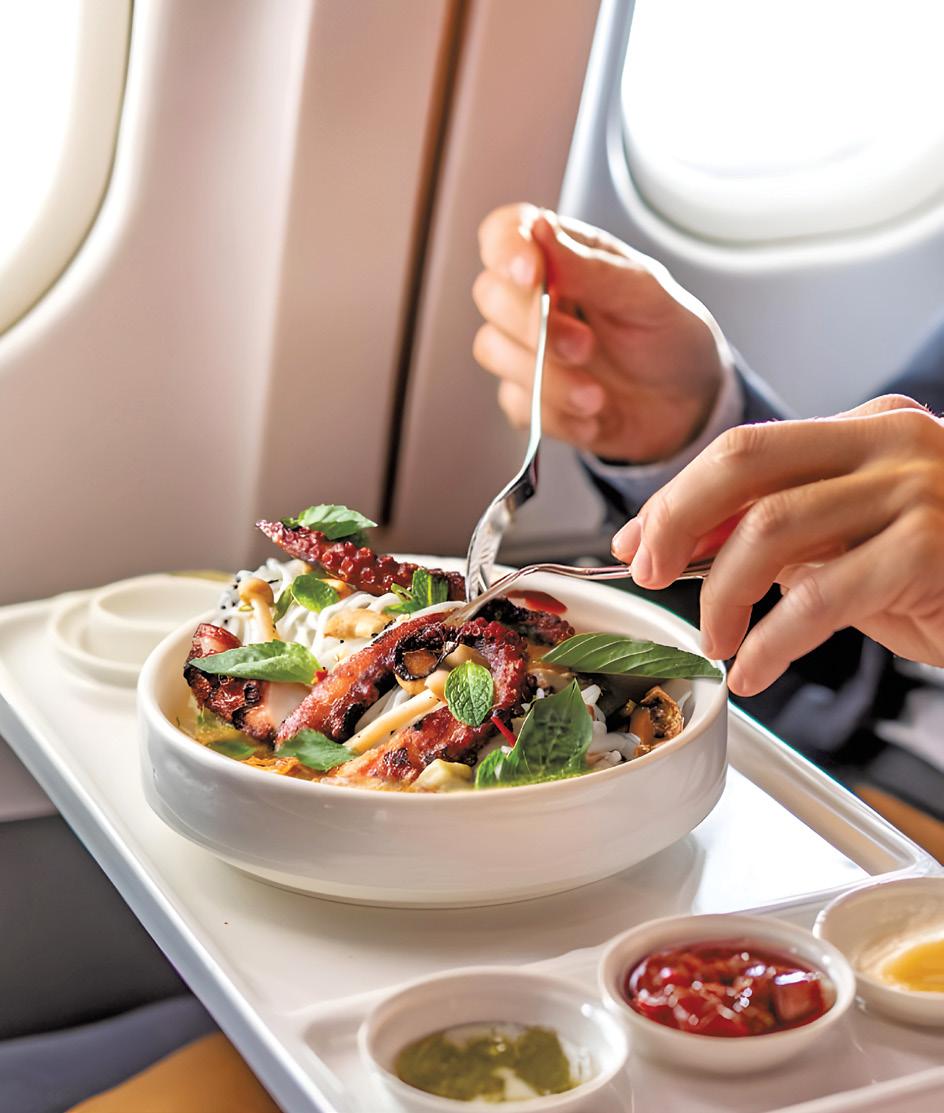
ing gourmet ingredients for a light and satisfying choice. They will also showcase a Tomato Mozzarella egg snack, Matcha Chia Pudding with persimmon compote, a sweet and seasonal addition to the breakfast menu. Additionally, Day Three features a flavorful Pumpkin Coconut Chia with Quinoa, topped off with a crunchy Ginger Cookie Crumb.
For lunch, IFSA attendees can expect a diverse menu. On Day One, offerings include a Taco Chicken Jar Salad – a dish combining black bean
continued on page 114

continued on page 134

Selecting the right pizza oven has evolved far beyond a simple gas vs. electric decision. Today’s ovens must be chosen with a keen understanding of how they will impact the specific flour, oils, toppings, and doughs used in your recipes. Oven technology now includes features like precise temperature control, humidity regulation, and even airflow management—all of which influence the final product’s texture, flavor, and consistency. From crispy thin crusts to chewy Neapolitan-style pies, every element of your pizza can be affected by the oven’s performance, making careful vetting essential to achieving the desired results.
24/7 Restaurant Equipment, a leading supplier of cutting-edge kitchen technology, has long played an integral role in shaping the pizza industry in New Jersey and beyond as they try to answer those key questions that will impact their success. In Fall 2024, the company partnered with the NJ Pizza Jam to sponsor a day of innovation, competition, and camaraderie for the state’s pizza professionals. The event goal is to become a platform for
growth—not only for the pizza chefs who attended but also for 24/7 Restaurant Equipment itself, as it showcased its latest equipment and strategies for boosting pizzeria efficiency and creativity.
“NJ Pizza Jam Fall 2024 was an incredible opportunity for us to connect with the pizza community,” said Christian Hernandez, President of 24/7 Restaurant Equipment. “The event was a chance to share our latest innovations, but also to listen and understand what challenges pizza professionals face when adding new pizzas to their menus.”
“We want to create spaces where pizza makers can come to us with their challenges, and we can help them find solutions—not just with equipment but with the knowledge and support they need to succeed.” — Christian Hernandez
The NJ Pizza Jam has become a cornerstone event for pizza makers in the region, bringing together restaurateurs, chefs, and industry leaders to share insights, strategies, and


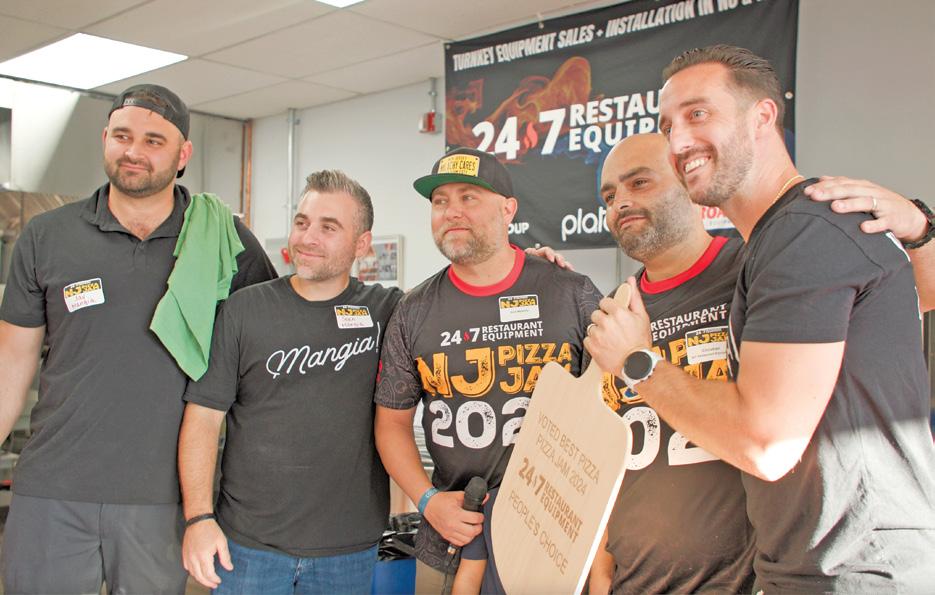
of course, some of the best pizza New Jersey has to offer.
Through live demonstrations and interactive workshops, the event gave
continued on page 122



In today’s rapidly evolving foodservice industry, ensuring food safety, maintaining freshness, and enhancing convenience have become paramount concerns. Inline Plastics, a leader in innovative packaging solutions, has stepped up to meet these needs with their Safe-T-Chef® product line. This advanced line of tamper-resistant and tamper-evident packaging solutions is designed to address the specific demands of foodservice providers, restaurants, and distributors across the industry.
“Our mission has always been to deliver packaging solutions that keep food safe while maintaining optimal quality,” said Carrie Cline, Senior Brand Manager. “Safe-T-Chef® was developed in direct response to the growing need for tamper protection technology in packaging that works for hot food applications.”
The Safe-T-Chef® line, launched to much acclaim, features polypropylene packaging designed to provide high clarity and durability, ideal for displaying hot foods. Inline Plastics’ unique patented technology not only ensures a tamper-resistant seal but also provides consumer confidence that food remains secure from production to consumption.
“The Safe-T-Chef® line evolved from its initial domed lid designs to include flat lid options, expanding its versatility,”

“When consumers can see the quality of food, their trust and likelihood to purchase increases.” — Carrie Cline, Senior Brand Manager
Cline explained. “This expansion caters to diverse operational needs. Whether it’s accommodating voluminous foods or presenting a sleeker profile, Safe-TChef® now offers tailored solutions without compromising on protection. Operators can choose packaging that best showcases their products, enhancing both functionality and visual appeal.’”
These advancements make Safe-TChef® an indispensable tool for restaurants, convenience stores, grocery stores, and other foodservice providers, whether they’re serving individual meals or family-sized portions. The new

options optimize stacking capabilities, maximizing space efficiency on shelves and delivery vehicles.
One of the most exciting recent enhancements to the Safe-T-Chef® line is the incorporation of anti-fog technology in the vented packaging. This feature addresses a common challenge faced by operators when packaging hot foods— condensation buildup inside the package, which often clouds visibility and diminishes the appeal of the product.
“Our customers told us repeatedly that visibility is crucial when it comes to displaying hot foods,” said Cline. “With
the anti-fog technology, we’ve ensured that the steam generated by hot foods doesn’t obscure the view, making the food more appetizing to consumers.”
The clear, all-around visibility of the Safe-T-Chef® packages enhance product presentation, which is key in high-turnover environments like convenience stores and grocery deli counters. With the vented lids, excess steam is effectively released without compromising the security of the tamper-evident seal.
Inline Plastics has consistently championed food safety, and the Safe-T-Chef® line is no exception. This tamper-resistant packaging not only protects the food but also serves as a deterrent to potential tampering incidents. Safe-T-Chef® packaging acts as an additional layer of protection. Knowing that the packaging is designed to prevent unauthorized access offers peace of mind to both foodservice operators and consumers.
Moreover, the visibility provided by the anti-fog technology contributes to reduced food waste. “When consumers can see the quality of food, their trust and likelihood to purchase increases.” said Cline. “It’s all about creating trust in the product, and that’s what Safe-T-Chef® does.”
continued on page 126


In an era where efficiency and customization are paramount for restaurant success, Cleveland Menu is taking menu design to the next level. Their newly launched DIY Menu Store is a game-changing service that enables restaurants to design their menus from scratch, have them printed on highquality stock, and receive them back within 72 hours. This innovation marks a new chapter for Cleveland Menu, a family-run business that has been providing high-quality menu solutions for over 90 years. The new addition to the line is the latest in multiple generational track record of innovation from menus to table tents, wine lists and check covers.
Founded in 1930 by Gerry Ramella’s father, Cleveland Menu has always been ahead of its time in menu printing and design. The company started as a local printer of daily menus for Cleveland’s finest restaurants and has since evolved into a leading player in the industry. Today, the business is run by the third generation of Ramellas, including Gerry Ramella (President), Jim Ramella (CoCEO), and Patrick Ramella (Co-CEO).
“My Dad was an orphan in West Virginia who learned the printing trade,” said Gerry Ramella. “When he came to Cleveland, he began working in a small print shop that eventually became Cleveland Menu. We’ve grown significantly since then, but we

“Restaurants can now easily order and print as few as 50 menus, allowing them to update their offerings without breaking the bank or waiting weeks for delivery.” — Jim Ramella
still hold true to the values of quality and service that he instilled in the business.”
Cleveland Menu’s new Do-it-Yourself (DIY) Menu Store offers restaurant owners an easy-to-use platform to print their menus without the need for expensive custom print shops. The platform allows restaurants to upload their designs, select from various paper stocks, and place their orders online, simplifying the entire process. Within just 72 hours, the menus are printed on Cleveland Menu’ proprietary Durapoly synthetic paper and delivered straight to the restaurant’s doorstep.
“This service is a response to what restaurants need today: speed, flexibility, and cost-effectiveness,” explained Jim Ramella. “Restaurants can now easily order and print as few as 50 menus, allowing them to update their offerings without breaking the bank or waiting weeks for delivery.” The platform’s ease of use is a key selling point. Even small, independent restaurants with limited resources can take advantage of Cleveland Menu’ premium printing services, which were once primarily available to larger chains and high-end restaurants.
The COVID-19 pandemic highlighted the need for restaurants to quickly adapt to changing customer preferences and operational challenges. With takeout and delivery services booming, many restaurants reduced their menu offer-
ings to streamline operations and focus on dishes that travel well.
“We’ve seen a real shift in how restaurants use their menus,” said Patrick Ramella. “During the pandemic, there was a big push for digital QR code menus, but diners are now returning to physical menus. We’ve heard from many clients that their customers prefer a printed menu – something tangible they can hold. That’s why our synthetic paper, which is waterproof and extremely durable, has become a popular choice for dine-in and takeout menus alike.”
Cleveland Menu is not just about providing a blank canvas for restaurants to print their menu items. The company’s team of experts are well-versed in the principles of menu engineering, helping restaurants maximize their revenue through strategic design and placement of dishes.
“Menu design is a crucial part of a restaurant’s brand and guest experience,” added Jim Ramella. “Our clients come to us for advice on how to highlight their most profitable dishes or create a certain ambiance through the design of their menus. For example, the placement of high-margin items in certain areas of the menu can subtly influence customer choices. A menu is more than just a list of items; it’s a key part of the dining experience and the restaurant’s
continued on page 126

As President and CEO of the Texas Restaurant Association (TRA), Dr. Emily Williams Knight has been a transformative force in one of the most influential state restaurant associations in the country. Taking on the role in August 2019, Knight has led with passion, resilience, and vision during one of the most challenging periods in the industry’s history. With Texas home to more than 50,000 restaurants, employing over 1.3 million people and generating $70 billion in sales, her leadership during the COVID-19 pandemic proved pivotal in ensuring

the survival of countless businesses.
A highly respected figure, Knight has utilized her vast experience in global leadership, education, and workforce development to bring innovative solutions to the table. Her tireless efforts resulted in several crucial waivers from Governor Abbott and federal support to keep Texas’s restaurant and foodservice industry afloat. Her success continued with the passage of six major pieces of legislation during the 87th Texas legislative session, a testament to her ability to navigate complex political landscapes while advocating fiercely for the needs
of her industry.
With a background that includes leading educational initiatives for hospitality programs and working with international education providers, Knight brings a wealth of knowledge to her role at the TRA. But her influence extends far beyond Texas. Many of the issues she and her team are lobbying for — from labor policies to supply chain disruptions — have national implications. As the restaurant industry faces unprecedented challenges, Total Food Service sought out Dr. Knight for her insights on these critical topics, knowing that her efforts could

shape the future for restaurateurs and foodservice operators across the U.S.
Can you share a little bit about your background and what led you from Connecticut to Texas?
Sure! Believe it or not, I’m originally from Connecticut. I grew up on a military base because my dad was a submariner. Everything was very service-oriented but far from glamorous. However, I watched a show called Hotel with Connie Sellecca, and it sparked this dream of running a major hotel. So, I went to hospitality school at Boston University. From there, my career took an interesting path. I married a military officer, which led me to work for Pizza Hut and Marriott after graduation. Eventually, I shifted into higher education, working for about a decade in different roles, including as the president of Kendall College near Chicago and leading a Swiss hotel school globally. Finally, I found my way to Texas when the CEO role at the Texas Restaurant Association opened up right before the pandemic.

policies at the state and federal levels. Today, the focus is on supporting members through the uncertainty in the market and maintaining a regulatory-friendly environment in Texas. We also deal with major legislative issues at the local, state, and federal levels, including regulations, swipe fees, and various lawsuits.
What are some of the key issues you’re addressing now, both at the state and federal level?



















What was on the original agenda you inherited at the Texas Restaurant Association?
The association was 93 years old at the time, and it needed a bit of a refresh. There were two major priorities: rebuilding the association and making sure the legislative environment remained business-friendly. Texas was booming, with a growing variety of food and brands, but the association had somewhat lost its way. We needed to reestablish the value proposition for our members while ensuring that the legislative landscape remained supportive for restaurants.
What are the current priorities on your agenda today?
The pandemic really clarified our purpose, showing the value of the association as we led from the front in reopening restaurants and shaping









At the state level, one of our biggest wins was the passage of a preemption bill, which ensures that restaurants in Texas, regardless of location, operate under a consistent set of economic rules. Another critical issue is swipe fees—these are the third-largest line item for restaurants. We’re working at both the state and federal levels to provide relief for operators. Additionally, we’re involved in multiple lawsuits around the overtime rule, joint employer regulations, and more. A surprising priority that’s emerging for us is childcare. With 1.4 million people employed by the private sector in Texas, childcare infrastructure is vital for maintaining a stable workforce.
What does a fair and equitable solution to the childcare issue look like?
It’s not about less regulation, but more consistent and thoughtful regulation. We need to empower homebased care and offer different tax incentives for employers. Our approach is to focus on the business and economic imperative. Both parties recognize the importance of solving this issue, and we’re working to pilot new childcare models, aiming for a solution that blends local regulation, tax incentives, and entrepreneurship.
How will the Michelin Guide’s arrival in Texas affect restaurant openings and food quality in key cities?
continued on page 40


The arrival of the Michelin Guide is going to have a significant impact. First, it’s going to drive tourism, and tourism is critical for the restaurant industry. Four out of every ten dollars spent in Texas restaurants come from tourists. While only a handful of restaurants will get Michelin stars, the influx of foodies and tourists will benefit everyone, from fine dining establishments to local taco stands. It will also keep more culinary talent in Texas, giving them the chance to build prestigious careers without leaving the state.
What is it like trying to open a restaurant in Dallas or Houston? How easy or difficult is it legislatively?
It’s actually incredibly easy to open a restaurant in Texas, maybe even too easy. The regulatory environment is very favorable. The challenges opera -
tors face are mostly related to building permits, but that’s where the association steps in to help. We have 23 chapters across the state, and our major cities have physical offices with staff who guide new operators through the process.
How are your members attracting top talent for front-of-house and back-of-house positions?
Labor is a challenge for everyone. Wages have gone up by 24%, and with the tip credit, many employees make $20 to $30 an hour or more. We’ve been able to scale benefits, like healthcare through a partnership with Teladoc, for just $9 a month, which includes full mental health coverage. Additionally, we’re offering professional development and clear career
continued on page 42


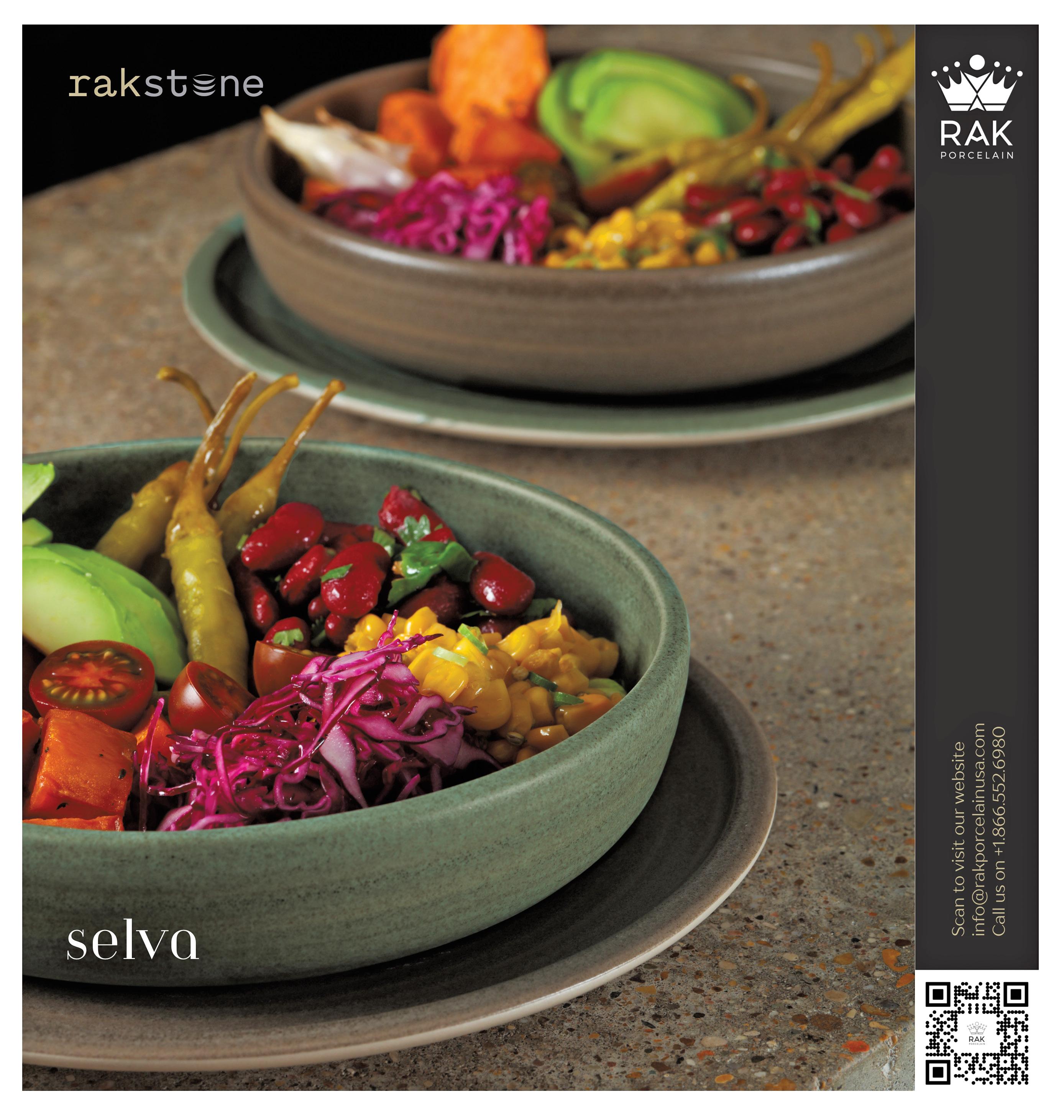
paths for employees. Programs like ProStart are preparing high school students for culinary careers, and our reentry program helps individuals exiting the justice system find work in the industry.
Tell us more about the reentry program and its impact.
Our reentry program focuses on individuals in the last six months of their sentence. They get trained in food service and earn certifications while working with partners like the San Antonio Food Bank. When they’re released, they already have a job and a support system in place. It’s been a highly successful program, and we’re now working to expand it across the state.
How is the restaurant real estate market evolving in Texas, particularly in downtown areas?
Downtown real estate is in a bit of flux, with some office spaces only operating at 70% capacity. A lot of brands
have moved to the suburbs, where there’s growth, while downtown spaces are transitioning to mixed-use developments. Restaurants are being cautious, requiring lease terms that guarantee a certain level of foot traffic before committing to spaces. In some cases, restaurants have shifted from a traditional dine-in model to catering for offices as a way to sustain business.
Who are the next-generation restaurant operators or concepts in Texas that we should be watching?
Texas has a rich legacy of independent operators. While large chains and franchises play a big role, what makes Texas special are the singleunit, family-owned restaurants. These independent operators make up about 70% of the market. On the larger scale, concepts like Velvet Taco and chains like Torchy’s Tacos are growing rapidly, but Texas’ culinary diversity— ranging from BBQ to Southeast Asian
continued on page 44



flavors—is where you’ll find the most exciting innovation.
What were some of the key takeaways from your recent annual trade show?
Technology, specifically artificial intelligence, was a huge focus. Our industry is very labor-intensive—requiring around 12.1 employees per restaurant, which is much higher than other sectors. The conversation now is about how to automate non-customer-facing tasks, like inventory management or delivery coordination, while keeping the human touch where it matters. Attendees were also very interested in integrating tech solutions they’d scrambled to adopt during the pandemic in a more thoughtful, cohesive way.
What are your thoughts on the Colonel concept started by one of Chipotle’s co-founders?
I’m actually going to see it firsthand soon, so I’ll reserve judgment until then. But I think it’s an interesting
concept, and like many innovations in the industry, it has the potential to drive change. We need big brands to keep innovating because their R&D often trickles down and helps smaller operators as well.
How does the Texas Restaurant Association view hospitality in a techdriven world?
The definition of hospitality is evolving, and technology will play a big role, but at the end of the day, it’s the customer who decides what hospitality looks like. Whether that means face-to-face interactions, virtual orders, or even fully automated systems, restaurants need to stay true to who they are and what their customers want. The danger is in forgetting your core identity while chasing the latest shiny object.
What are some of the issues you’re addressing with the Texas Alcoholic
continued on page 46



Beverage Commission (TABC)?
TABC has been an incredible partner, particularly with the alcohol-to-go law. We work together on ensuring it’s implemented safely. Right now, we’re also discussing issues around the growing winery and distillery industries in Texas and the bottle limits they face. Another big conversation revolves around cannabis-infused beverages, which are gaining popularity, and how that will affect the alcohol industry.
Why does the TRA oppose the bill allowing consumers to bring their own wine into restaurants?
We believe it’s a slippery slope. Once you allow customers to bring their own wine, why not allow them to bring their
“A surprising priority that’s emerging for us is childcare. With 1.4 million people employed by the private sector in Texas, childcare infrastructure is vital for maintaining a stable workforce.”
own salsa or any other item? It undermines the restaurant’s role in serving and caring for the entire dining experience, and it would negatively impact the bottom line for many operators.
What is the TRA’s position on immigration, especially considering Texas’ proximity to the border?

Make plans to attend the 2025 Texas Restaurant Show, presented by Eat Local. Eat Often. in Houston and connect with industry peers! Immerse yourself in 500 booths showcasing cutting-edge products and services. Gain valuable insights from industry professionals and business leaders during our three days of educational sessions. Whether you’re an operator of a single-unit restaurant or a multi-chain franchise, the Texas Restaurant Show has the information and data to help you thrive.
Immigration is crucial for our industry, both in Texas and across the country. We’re advocating for sensible immigration reform, including a visa program that allows people to come and work, pay taxes, but without the path to citizenship. Immigrants have long been a vital part of our workforce, and we want to see reforms that reflect their importance to our industry. We work closely with organizations like Forward.US and the National Restaurant Association on these issues.
What’s your take on the recent interest rate cuts’ impact on the industry?
I’m cautiously optimistic. While it’s a
step in the right direction, the real challenge is how long it will take to trickle down to consumers. Restaurant costs are still high, and consumers are feeling squeezed. We’ll need to see how quickly this impacts credit card interest rates and consumer confidence. More cuts in the coming months would be a good sign.
Looking ahead, what are the Texas Restaurant Association’s goals for 2025?
Our number one goal is to have a successful and impactful legislative session. We have strong support across the board, and we’re looking to solidify important work that will allow restaurants to thrive. Looking further ahead, Texas is expecting significant population growth, and every new resident is a win for our industry. We’re also focused on ensuring that, no matter what happens on the national level, we continue to remind people of the importance of our industry to the state’s economy.
All photos courtesy of Texas Restaurant Association


The 2024 Plant Based World Expo North America (PBW), held last month at New York City’s Javits Center, drew thousands of foodservice and retail professionals, all eager to explore the future of plant-based foods. As the only 100% plant-based trade event in North America, PBW set the stage for how restaurant owners and foodservice professionals can integrate plant-based options into their menus for 2025 and beyond. With over 200 exhibitors from around the world, this year’s Expo showcased products that push the boundaries of what plant-based foods can offer. Attendees were introduced to innovative


ingredients and globally inspired flavors, from Italian truffle-infused plant-based cheeses to French vegan croissants. Latin American influences were also present, as companies from Brazil and Peru presented nutrient-dense, sustainable ingredients like acai and jackfruit.
Henrik Lund, CEO of Naturli’ Foods, said, “The quality of the people we talked with this year has been exceptional. The Hosted Buyer Lounge provided invaluable opportunities to connect with stakeholders and decision-makers.”
PBW’s strategic matchmaking program resulted in nearly 400 meetings between buyers and exhibitors, including influential names such as KeHe, So-

dexo Campus, and Fresh Thyme Market.
“The Hosted Buyer program was fantastic,” said Fedele Stella, a buyer with Fairway Market. “I walked away with a solid list of brands to consider for our menu offerings.”
Ben Davis, PBW Content Chair and Strategic Advisor, highlighted several trends that restaurant owners should consider. “We saw a growing emphasis on whole-food-based products that emphasize natural, nutrient-dense ingredients,” he said. “Operators need to focus on quality, health-conscious plant-based options that go beyond just replicating traditional meat dishes.” Incorporating these kinds of options
into restaurant menus can help attract a broader range of diners, from vegans and vegetarians to flexitarians and healthconscious consumers. “Plant-based foods aren’t just a trend—they’re becoming a key part of the menu in many dining establishments,” Davis explained. “With consumers prioritizing sustainability and wellness, offering delicious plant-based options is a strategic move for any foodservice operator.”
Among the most popular items on display were healthier plant-based snacks made with innovative, sustainable ingredients. From algae-based

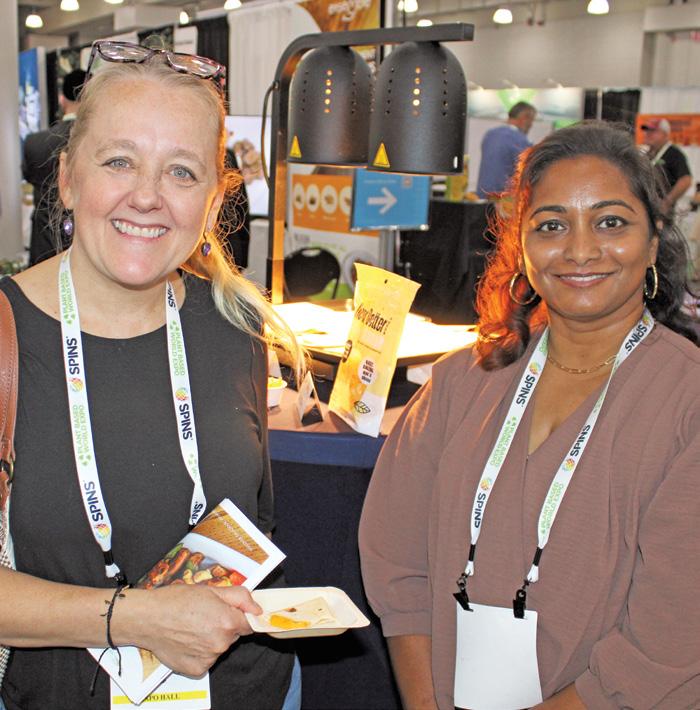
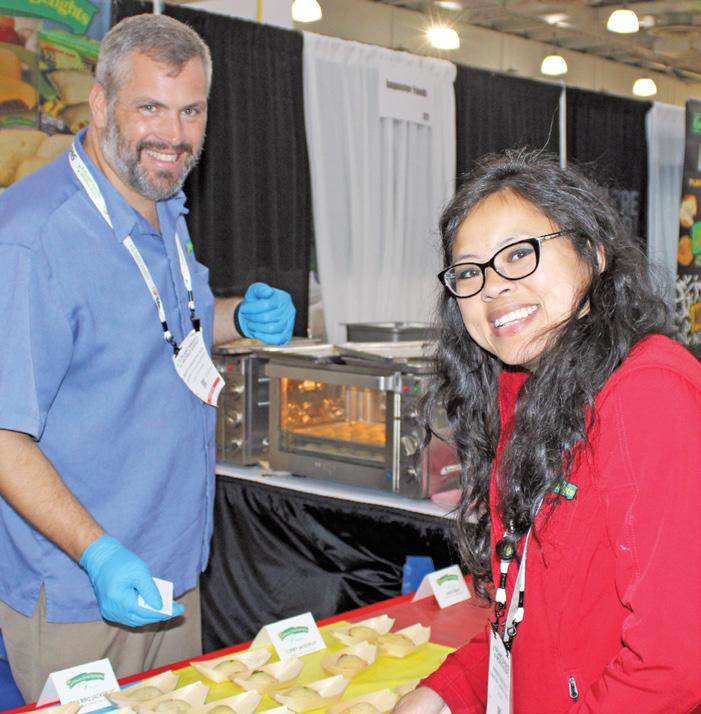
continued on page 117

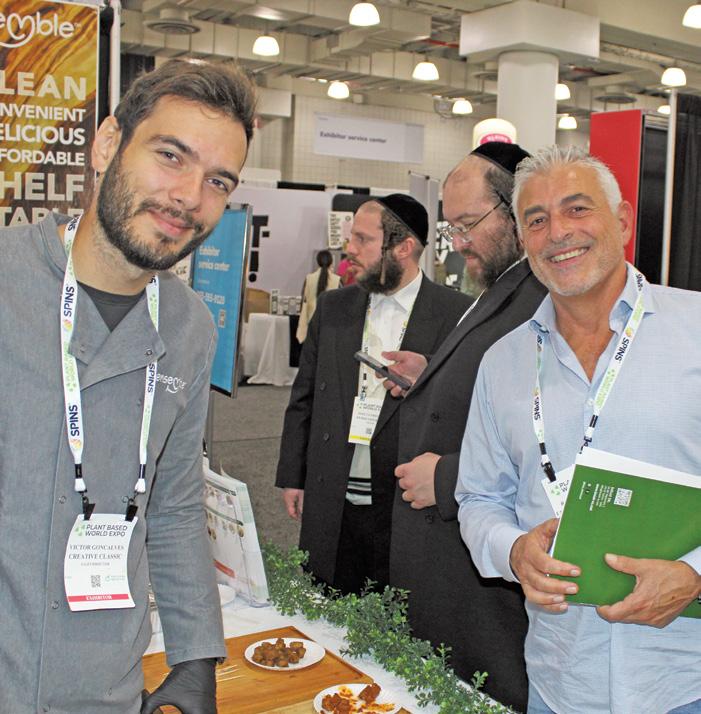

In recent years, convenience stores have expanded beyond their traditional role as quick stops for gas and snacks. They are now increasingly becoming hubs for fresh, fast, and hot food offerings. One of the driving forces behind this evolution is the development of compact, ventless kitchen equipment, which allows retailers to offer a wider variety of hot food items without the need for extensive kitchen infrastructure.
Among the leaders in this innovation is the AutoFry, a fully enclosed and automated deep-frying system that requires no external ventilation. Along with other compact kitchen equipment, such as the MultiChef high-speed oven, convenience store operators are finding new ways to optimize their space and boost revenue by offering foodservice options.
In the world of convenience stores, square footage is at a premium. Traditional kitchen setups often require a significant amount of space for large appliances, cooking surfaces, and ventilation systems. This can be a challenge for smaller stores or those that were not originally designed to accommodate foodservice operations. However, ventless equipment like AutoFry is transforming the way convenience stores can utilize their limited space.
One of the primary benefits of compact kitchen equipment is the ability to make the most out of limited square footage. Equipment like AutoFry can be easily integrated into the layout of any convenience store, even those with little to no dedicated kitchen

space. By using smaller, ventless units, operators can add foodservice offerings without requiring costly renovations or reducing the amount of retail space available for other products.
Traditional commercial kitchens often require complex and expensive ventilation systems to manage smoke, grease, and odors. These systems not only take up space but can also be costly to install and maintain. AutoFry eliminates the need for these systems by containing the frying process within an enclosed, self-venting unit. This dramatically reduces installation
costs and simplifies the process of adding a foodservice program to any convenience store.
Many convenience store operators are not experienced in running full kitchens, and hiring trained culinary staff can be a challenge. Equipment like AutoFry and MultiChef are designed with ease of use in mind. AutoFry is fully automated, allowing employees with minimal training to operate the fryer safely and efficiently. This allows stores to offer a wide range
continued on page 114
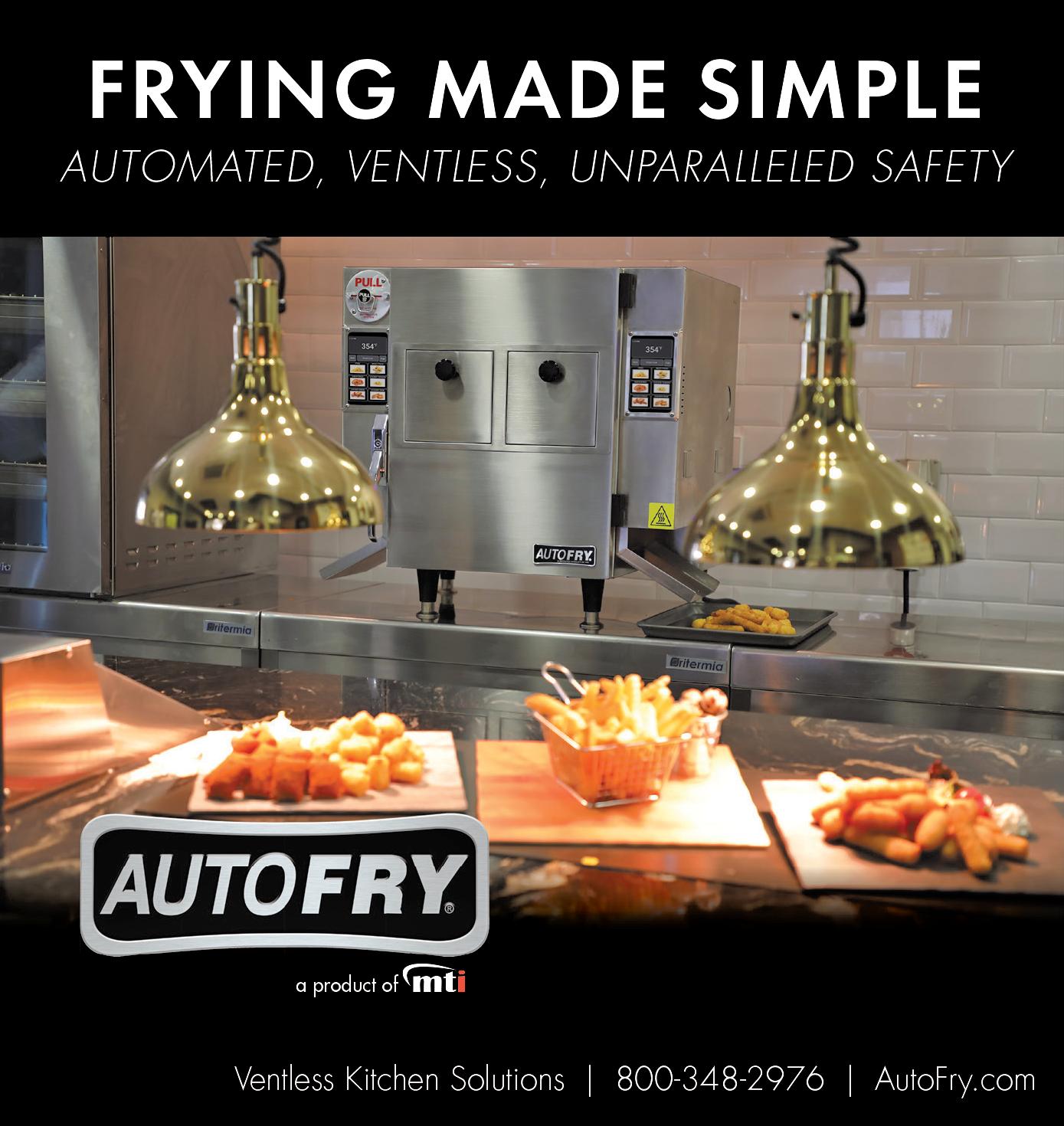

In the bustling world of foodservice, where efficiency and reliability often spell the difference between success and failure, Jeffrey Kaufman stands out as a visionary who transformed the way restaurants and commercial kitchens operate with a unique approach to service and facility management. As Founder of the Scientific Group, Kaufman has not only built a company that caters to the service needs of the food industry but also innovated a scalable model that sets them apart from other kitchen service providers.
Jeffrey Kaufman’s journey to creating the Scientific Group is anything but conventional. Raised in the Bronx, NY, Kaufman was always fascinated with how things worked. As a child, he was the kind of kid who loved to take apart toys just to understand the mechanisms behind them. Little did he know that this natural curiosity
“Preventive maintenance is key. It’s always cheaper to fix a small issue before it turns into a big problem.” — Jeffrey Kaufman
would lead him to revolutionize an entire industry.
After dabbling in accounting and realizing that sitting behind a desk wasn’t for him, Kaufman shifted gears and ventured into construction work. Starting small with renovation projects, he quickly gained a reputation for his hands-on expertise and grew his business from fixing bathrooms and kitchens to constructing hotels and office towers.
The idea for the Scientific Group was born out of necessity. Kaufman recognized the inefficiencies in hiring subcontractors who often lacked the experience or resources to finish
jobs on time. Instead of relying on third parties, he took a bold step to self-perform the work, which allowed him to maintain complete control over quality, timelines, and costs. As his company scaled, Kaufman spun off specialized units that could operate independently but work collaboratively to provide a comprehensive suite of solutions for commercial kitchens.
The Scientific Group has become a national powerhouse in kitchen service solutions, serving 70% of the major metropolitan markets across the United States. What makes them stand out is their holistic approach
to commercial kitchen operations.
While many service providers specialize in one or two verticals—such as fire suppression or grease trap maintenance—the Scientific Group offers 14 distinct service units under one roof, allowing clients to pick and choose exactly what they need. “We like to think of it as a dim sum menu for kitchen services,” Kaufman explained. “Clients can order exactly what they need, whether it’s exhaust cleaning, refrigeration maintenance, or pest control, and bypass the rest. We provide a turnkey solution that’s tailored to their unique needs.”
This breadth of service options is rare in the industry and allows Scientific to offer a one-stop-shop solution that other providers simply can’t match. Their scalability means they can handle a small local restaurant’s
continued on page 115


In today’s fast-paced world, where convenience and indulgence are top priorities for consumers, the foodservice industry must continuously innovate to meet these evolving demands. One way to do this is by offering versatile, grab-and-go options that appeal to a wide range of customers.
Enter Rich’s Filled Donut Bites—small, delicious, and perfectly suited to accompany the nation’s favorite beverage: coffee. The new, mouthwatering Double Chocolate Filled Donut Bites join two other ready-to-finish, decadent donut holes from Rich’s: Jumbo Birthday Cake Filled Donut Bites with Vanilla Frosting Filling and French Toast Cake Filled Donut Bites with Maple Filling. These donut bites are the ideal addition to any convenience store or limited-service restaurant (LSR) menu, providing an easy upsell opportunity that can drive sales throughout the day.
The three filled donut bites represent just a fraction of Rich’s extensive portfolio of bitesize donut delights. The Donut Bite portfolio offers classic and on-trend flavors in filled and unfilled cake and yeast varieties -- and whole grain options too. The lineup includes classic and on-trend flavors like Churro Bites, French Toast Bites, Pancake Cake Bites, Cornbread Poppers, Glazed Old-Fashioned Donut Holes, Yeast Raised Donut Holes, and Classic Cake Donut Holes.
Coffee is no longer just a morning ritual; it’s an all-day affair. According to recent
“A key trend we’re seeing is the desire for indulgent, yet convenient, on-the-go snacks.” — Alyssa Barrett
studies, over 64% of Americans drink coffee daily, with many enjoying multiple cups throughout the day. This ongoing love affair with coffee presents a significant opportunity for foodservice operators to boost their bottom line by offering complementary snacks that enhance the coffee-drinking experience. Rich’s Donut Bites are specifically designed to meet this need. These bitesized treats are the perfect companion to a cup of coffee, whether enjoyed during
a morning commute, a midday break, or a late-night study session. Their small size makes them an ideal snack for customers looking for a sweet indulgence without the guilt of a full-sized dessert.
“A key trend we’re seeing is the desire for indulgent, yet convenient, on-the-go snacks,” says Alyssa Barrett, Senior Customer Marketing Manager at Rich Products Foodservice Division. “Our Double Chocolate Filled Donut Bites perfectly align with this trend, offering a rich,
decadent treat that pairs beautifully with any beverage. Whether customers are looking for a quick snack or a sweet addition to their coffee routine, these donut bites deliver.”
In addition to satisfying consumer cravings, Rich’s Donut Bites offer significant labor-saving benefits for operators, especially those facing staffing challenges. These pre-fried, ready-to-serve donut bites can be prepared quickly and easily, allowing staff to focus on other important tasks.
“Our donut bites are designed with the operator in mind,” Barrett explains. “They require minimal preparation— just thaw and serve or heat and serve— and they maintain their quality, ensuring that customers enjoy a fresh, delicious product every time. This convenience is especially valuable for LSRs dealing with labor shortages or high turnover, where every minute counts.”

One of the standout features of Rich’s Filled Donut Bites is their versatility. While they are delicious on their own, these donut bites can also be customized with additional toppings or decorations, enhancing their visual appeal and menu versatility. Operators can easily add a drizzle of caramel, a sprinkle of powdered sugar, or even a dip in chocolate to create a unique offering that stands out in the crowded foodservice landscape.
“Customization is a big part of what makes these filled donut bites so appealing to operators,” says Barrett. “By adding a
continued on page 118

‘The Olive Tree of Vouves,’ the oldest living olive tree in the world, is still planted firmly in the ground on the island of Crete, in the village of Ano Vouves. Estimated to be anywhere from 2000-4000 years old, it’s still producing olives today!
Olives are an intrinsic part of the DNA of Greece, part of our heart and soul, so let’s dive into why we love these delightful little fruits so much.
Throughout time the olive tree has served as a source of inspiration. In Ancient Greece the olive branch also took on an important meaning. Used in the form of a wreath, it crowned the victorious who emerged from bloody battles. It was also used to anoint noble heads on highly celebrated occasions.
According to ancient Greek mythology, the olive tree has long been a symbol of peace and prosperity. The myth is tied to the founding of Athens, Greece, and a battle between Athena (Goddess of Wisdom) and Poseidon (God of the Sea), both of whom wanted to claim Athens as their own (which was without a patron deity at the time).
Zeus, King of Gods, suggested a contest between the two to see who would claim the city, so they each offered a gift to the citizens. Poseidon struck his trident in the ground, creating a spring of salty sea water which was of little use to Athenians. Athena, on the other hand, planted an olive tree on top of the Acropolis, providing the people of Athens with food, oil and wood. They, in turn, felt her gift was most valuable and beneficial, and from that point forward Athena became the patron deity of the city, and the city henceforth was known as
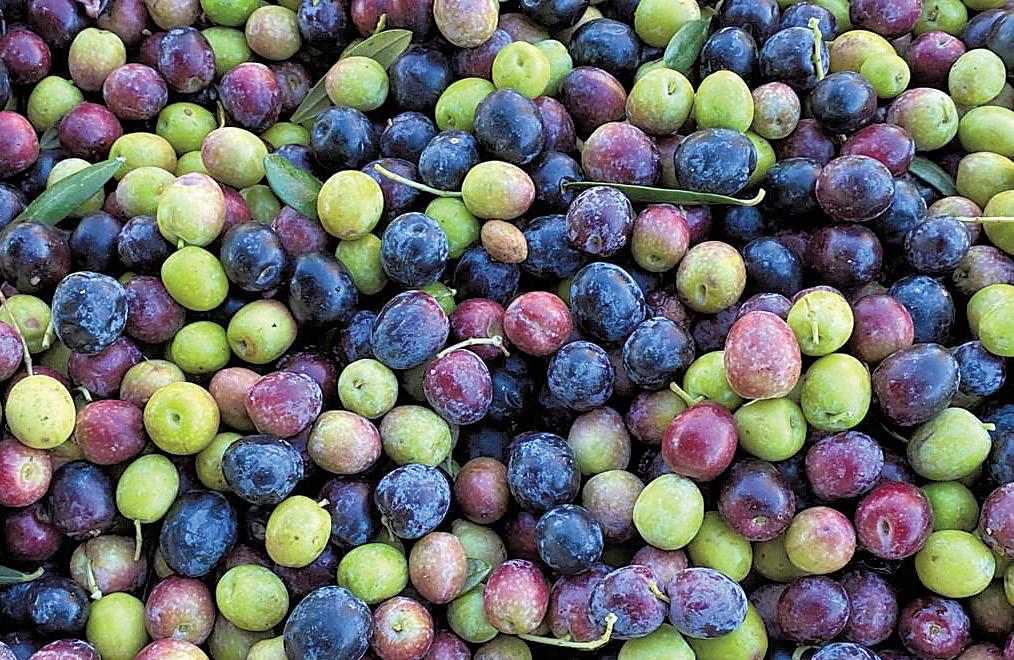
Today, Greece is recognized as one of the top producer of olives in the world. In fact, there are an estimated 120-170 million olive trees spread throughout the country – on the low end, that’s about 12 olive trees per person!
As a child, growing up in Thermo, a small village in Greece, we always had a handful of olives to sustain us throughout the day. They were usually eaten together with a hunk of bread, or rusks (a dry, hard, twice-baked bread), along with a piece of Feta cheese. Olives have always been a staple of Greek cuisine, and occupy a permanent place on most Greek dining tables.

One of my great memories from childhood was preserving olives with my family. My Papou (grandfather in Greek) taught me how to do that. He gave me a special stone used to crack the olives. He would tell me repeatedly just smash the olives, it’s a great way to release all of your frustration. He said it was better to take it out on the olives, rather than the people you love.
Once all the olives were cracked, we submerged them in a vat of clean water, and changed that water every two days, until the olives were no longer bitter. The we changed the water one more time, and

Chef Maria Loi is an entrepreneur, Greek food ambassador and healthy lifestyle guru. The author of more than 36 cookbooks, she is also the host of the award winning PBS series, The Life of Loi: Mediterranean Secrets, now airing its second season on PBS stations nationwide. Both seasons 1 & 2 are available to stream on PBS Passport, Amazon Prime Video, Apple TV, Amazon Freevee, Roku, and Plex TV. The Life of Loi aims to build an inspirational, educational movement around the Mediterranean diet and lifestyle. Loi Food Products, her specialty brand built on traditional ingredients from Greece, includes refrigerated dips, savory pies, pastas, botanical herbs, and olive oil sold on QVC, at Whole Foods Markets, Fresh Direct, and at other retailers. Chef Loi is also the namesake of the acclaimed restaurant, Loi Estiatorio, in the heart of Midtown Manhattan. Connect with her on LinkedIn, follow her on Instagram and Facebook, and learn more about her food philosophy at loiestiatorio.com/chef-loi/.
added vinegar and salt in order to brine and preserve them. Sometimes, we’d add lemon and other citrus and herbs to imbue them with different flavors, but our favorites were always the classic.
For me, as long as I have olives on my table, I am happy. I don’t care if they are black or green. Green olives are green because they are harvested early, and purple and black olives are harvested later, when they have ripened on the tree. While there are more than 32 native varieties of olives in Greece, there are
continued on page 58

some standouts that top the list in terms of popularity:
1. Kalamata - A popular variety that is dark purple to almost black in color, with a wrinkled skin and an almond-like shape. They have a fruity, salty flavor and are often preserved in red wine vinegar or red wine.
2. Koroneiki – A green olive variety that produces a rich green oil with a tropical hint and a peppery aftertaste. The trees are usually small and produce small olives with an incredibly high oil yield.
3. Agriniou – A lesser known but thoroughly loved variety of light green olives that come in all shapes and sizes, and are available in green and black form. They offer a unique flavor from the mild climate of central Greece, with a firm yet crunchy texture and unforgettable taste.
4. Amfissa - A variety of olive that is primarily cultivated in the region of Amfissa, Greece. They have a rich, fruity flavor and meaty texture.
5. Throuba – Coming from the island of Thassos, these small back olives are often called the ‘date olive,’ due to their prune-like appearance. Since they ripen on their own, Throumba are the only olives that can be eaten directly from the tree, and are meaty with a strong olive taste and aroma.
Though olives are a petite fruit, the wide variety of health benefits they offer is quite mighty!
• Olives are rich in monounsaturated fats – aka healthy fats. They are also a good source of oleic acid, which is known to promote heart health by reducing inflammation (beneficial for conditions like arthritis), and can also help lower your bad cholesterol levels.
• Olives also have antioxidant properties which includes vitamin E and polyphenols (micronutrients naturally occurring in plants), which can help protect your cells from oxidative stress, and reduce the risk of chronic diseases, as well as cancer.
• According to the National Institutes of Health, polyphenols in olives may improve your bone health by increasing bone density, reducing the risk of osteoporosis. Olives, as a good source of fiber, also aids digestion, promoting a healthy gut. The healthy fats and fiber in olives also leads to better blood sugar control, beneficial for those with diabetes.
There are an infinite number of ways olives can be added to an endless variety of dishes. And when you do cook with olives, you always want to keep in mind that there are many different varieties, each of which has a very different textures and flavor profile. Some are briny, some fruity, and some spicy. Try them in salads. Sliced, diced or whole (pitted), olives can make a delicious addition to a fresh green, pasta or grain salad. There is no traditional Horiatiki Salata (traditional Greek village salad) without Kalamata olives, made with tomatoes, cucumbers, red onion, green peppers, and feta cheese.
I want to share a secret for an amazing dressing for this salad (which is great for other salads as well): combine olive oil, chopped pitted olives, three tablespoons of olive brine, one tablespoon of red wine vinegar, along with a handful of fresh herbs, and a teaspoon of dry oregano. This can be done by hand, in a blender, or in a resealable container that

you shake vigorously. The result is a tart, briny, unctuous salad dressing that ties all the ingredients together in perfect harmony.
They are great as a tapenade: A lot of people feel intimidated by the notion of making a tapenade, but is it surprisingly simple, and one the favorites among my customers at Loi Estiatorio in New York City. They love having it served up with crudites, or spread on some perfectly toasted pita bread. It’s even great as a condiment for fish, chicken, or meat. This bright, tasty blend of olives, capers, anchovies, lemon, garlic and herbs can be prepared in a matter of minutes, and is sure to make any dish pop.
(On my PBS series, The Life of Loi, in episode 108, The Land of Liquid Gold, there’s an easy recipe to make an amazing tapenade! You can watch it on PBS Passport, Apple TV, Amazon Prime, Roku, and Plex TV).

Olives also can provide a briny flavor, depth and complexity to sauces used for braises or stews made with chicken or lamb. I frequently make one of my childhood favorites- a simple Mediterranean-style chicken stew that’s gently simmered with olives, tomatoes, chicken stock or water, and a variety of aromatics. Olives also make a great addition to a variety of pasta dishes. I like to incorporate them into a simple Mediterranean pasta made with fresh diced tomatoes, feta, and herbs. Incorporated into a variety of baked dishes, olives make a delicious addition to a pleth-
ora of baked goods including focaccia or a nice, savory muffin. They can also help bring out the flavor when added to roasted vegetables. I love the very easy combination of potatoes, carrots, red onions, green and/or red bell peppers, and sliced or whole olives. Simply drizzle the vegetables with olive oil right before baking, and season evenly with some dried or fresh herbs.
Remember, whenever you are cooking with olives, don’t forget to consider the relative saltiness of these little gems when combined with other ingredients…taste before seasoning – you may not need extra salt.
It is always worth trying a wonderful yet simple treat, stuffed olives. You can add almost anything to them, but they are especially tasty with cheese, almonds, garlic cloves, or pimentos, Any and all of the above can make for a great appetizer or served up as part of a charcuterie or grazing board.
Olives, and the trees they come from have been a part of Greek DNA for thousands of years. We love the shade from the trees, the gorgeous wood it provides, the delectable fruits that it grows, and the incredible oil that comes from the fruit. There is nothing that goes to waste, and nothing left unappreciated. The next time you see an olive, think about the magic that one tree has provided for millenia – then pop it in your mouth, enjoy the burst of briny goodness, and live on knowing you’ve done something good for the day.
All food dish photo credits are Chef Loi
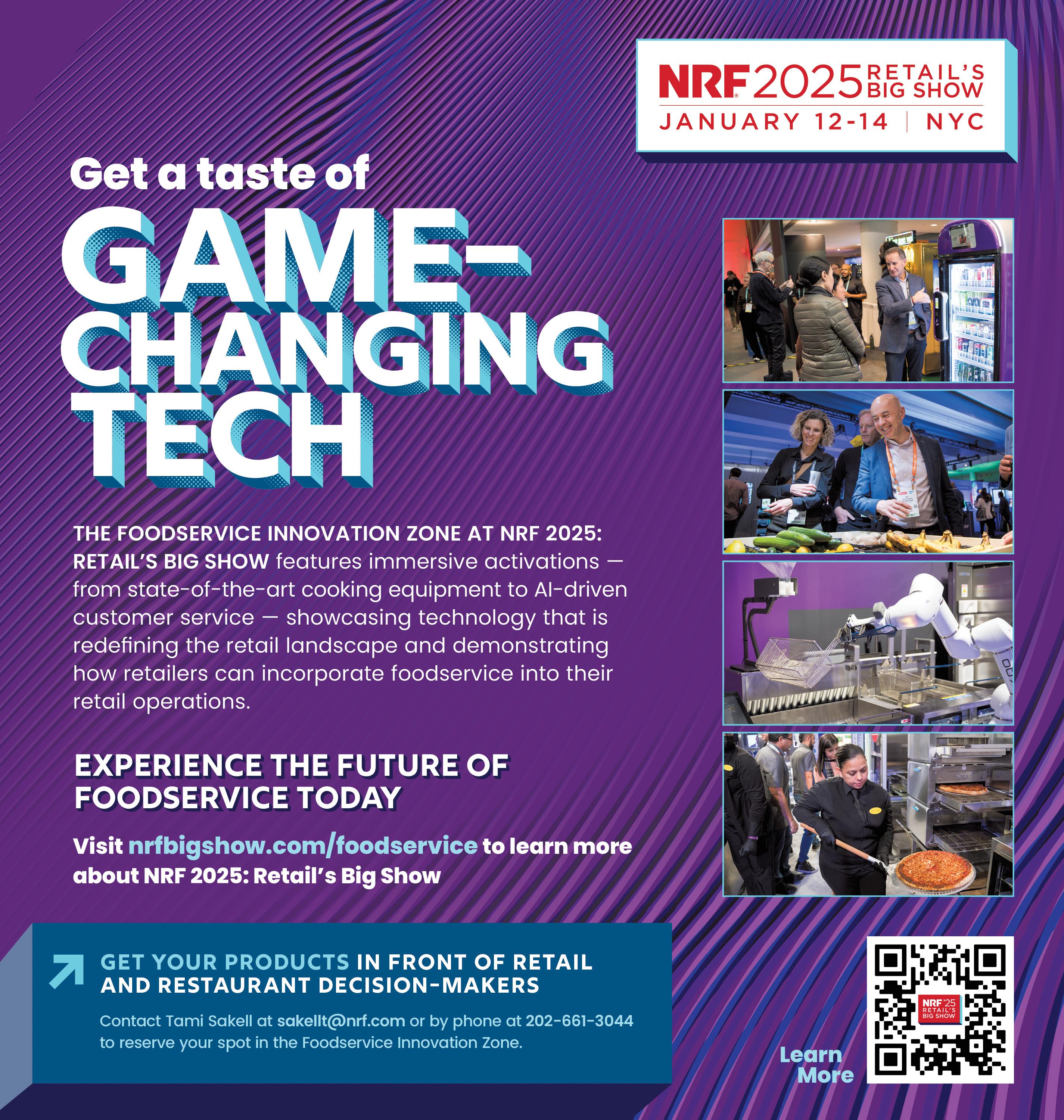
Distributor trade shows like Victory Foodservice’s annual Food Show are an essential opportunity for fostering collaboration between food manufacturers, distributor sales reps, and end-user customers in the restaurant and foodservice industry. These events have long served as a platform for the industry to gather, exchange ideas, and inspire menu innovations that keep dining experiences fresh and exciting. Chefs, restaurant owners, and foodservice operators rely on these

shows to discover new products, learn from industry experts, and build strong relationships with suppliers, ultimately allowing them to fine-tune their menu offerings. These interactions not only introduce new ingredients but also streamline operations, which can have a significant impact on a business’s bottom line.
Last month, Victory held its 21st Annual Food Show at the luxurious Resorts World Hotel in Queens, New York, marking a significant milestone for the company. As one of the region’s most


anticipated foodservice events, the show offered an unparalleled opportunity for professionals across the industry to come together, network, and explore the latest culinary trends. Victory Foodservice, a family-owned distributor based in the Bronx, has a long history of bringing high-quality food products to restaurants, caterers, hotels, and other foodservice operations throughout the Metro New York area.
Joanna Zoulis, Victory’s Director of Marketing, emphasized the importance of the show as a space for foodservice

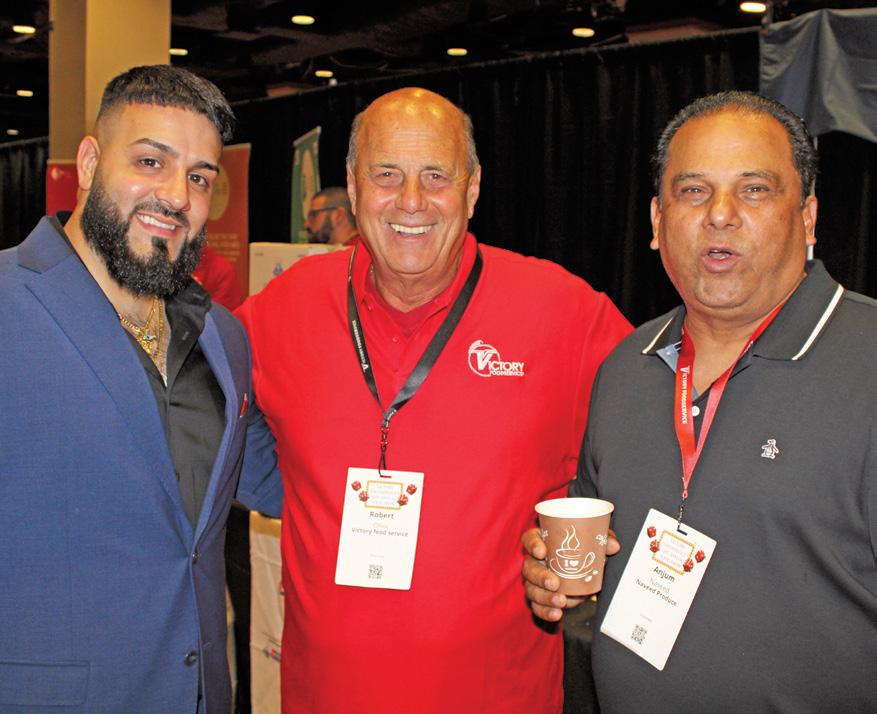
professionals to engage directly with vendors and suppliers. “The Victory Food Show is our way of giving back to our customers,” she said. “It creates a space for them to interact with our suppliers, gain insights into new products, and ultimately, find ways to enhance their businesses. We believe that by building these connections, we help our customers stay ahead in a competitive market.”
Moving the show to Resorts World
continued on page 62




Queens was a strategic decision to accommodate the growing number of attendees and provide an elevated experience. The venue’s state-of-the-art facilities allowed Victory to showcase its wide range of products—fresh produce, meats, seafood, and more—across 60,000 square feet of exhibition space. Attendees had access to over 200 vendor booths, offering everything from ready-to-serve solutions to artisanal products, reflecting the evolving needs of today’s restaurant operators.
One of the highlights of this year’s show was the focus on industry trends, particularly plant-based options and clean-label products. Zoulis noted the growing demand for healthier, more sustainable food options. “We’ve seen a real shift in what consumers are looking for, especially in plant-based and cleanlabel products,” she explained. “As a company, we’re committed to meeting this demand, and we’ve expanded our offerings significantly in these categories.”
Victory’s dedication to innovation didn’t stop there. With the industry facing ongoing labor challenges, the show also featured a variety of labor-saving products designed to help kitchens run more efficiently. From pre-prepared items that reduce prep time to ready-toserve dishes that maintain quality, Victory is focused on providing solutions that help foodservice operators manage costs and labor more effectively.
Sunder Luthra, one of Victory’s senior executives, highlighted this trend, saying, “We understand the pressures our customers face, especially with labor shortages. That’s why we’ve invested in products that help reduce kitchen workload without sacrificing quality. It’s about finding the right balance between convenience and maintaining the high standards our customers expect.”
A key feature of the show was the series of live chef demonstrations, which drew large crowds throughout the day. Industry-leading chefs from companies like Unilever, Krinos, and Smithfield took to the stage to showcase creative ways to use Victory’s products in innovative dishes. These demos were designed not just to impress but to educate, showing attendees how they could
incorporate these products into their own menus.
“We wanted to offer something more than just a product showcase,” Zoulis said. “Our goal was to inspire our customers with fresh ideas and practical applications for the products we carry. The chef demos were a fantastic way to bring those ideas to life.”
Victory also introduced a new feature this year: private consultation areas where attendees could meet oneon-one with vendors. These sessions allowed foodservice operators to dive deeper into product details, negotiate deals, and discuss how these products could fit into their specific operations. The intimate setting gave attendees the chance to make meaningful connections and explore purchasing opportunities that could directly benefit their businesses.
Despite the show’s size and scope, the event maintained the warm, family-friendly atmosphere that has always been a hallmark of Victory Foodservice. Attendees included longtime customers and suppliers, many of whom greeted each other like old friends. As Luthra put it, “Our success over the years is built on relationships—both with our customers and our vendors. We’re a family business, and that sense of community is something we’ve carried through every aspect of our company.”
The event also celebrated the diversity of the Metro New York foodservice scene, with Victory’s multilingual team offering support to attendees in a variety of languages. This inclusivity has been one of the keys to Victory’s success, allowing the company to serve a broad customer base across the city’s vibrant culinary landscape.
With over three decades in the business, Victory Foodservice remains committed to delivering quality products and exceptional service to its customers. The annual food show is not just a reflection of Victory’s achievements, but a testament to its future ambitions. The company’s investment in new technologies, sustainable products, and customer-driven innovations ensures that it will continue to be a leader in the foodservice distribution industry.
As the event came to a close, Zoulis



summed up the day perfectly: “We’re proud of the relationships we’ve built and the products we offer. But more than anything, we’re excited about what’s next—for us, for our customers, and for the industry.”
The Victory Foodservice Annual Food Show was a resounding success, and it left attendees inspired, informed, and ready to take their businesses to the next level.
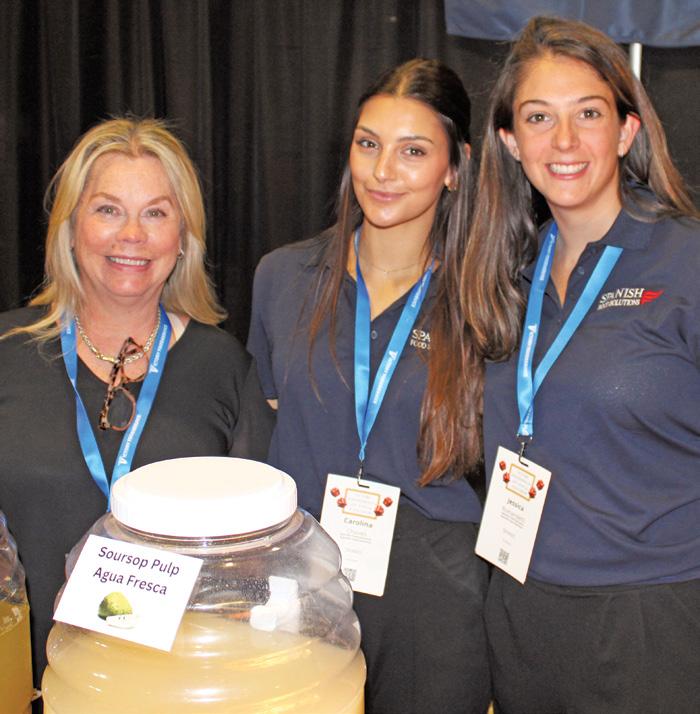

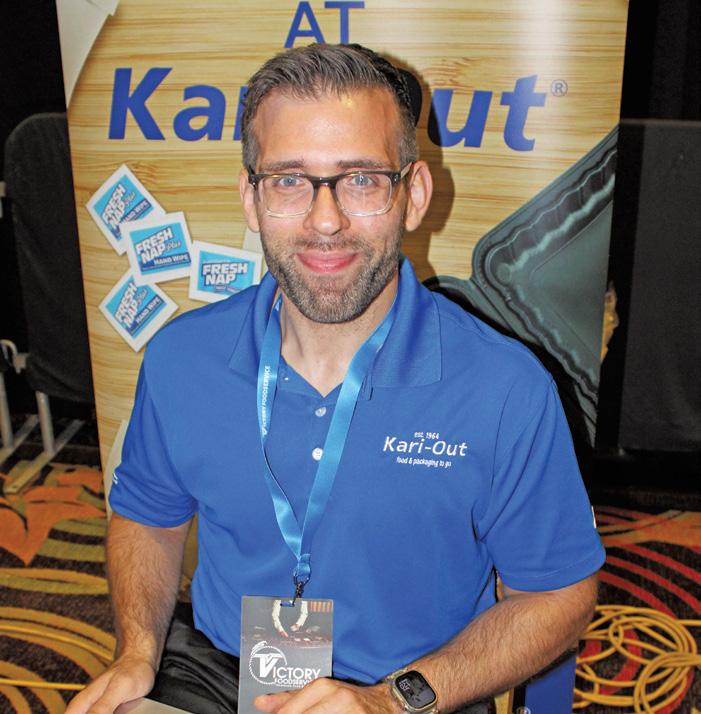




On a beautiful Manhattan day last month, TriState Marketing marked its 25th anniversary in grand style at Gotham Hall. The event brought together industry leaders, partners, and longtime colleagues to celebrate a remarkable journey spanning two and a half decades. From its humble beginnings to becoming an influential player in the food service industry, Tri-State Marketing has continually evolved with the times, and this anniversary was both a reflection on the past and a look to the future.
Lynne Schultz, co-founder and CEO of Tri-State Marketing with husband Bart Gobioff, expressed her heartfelt gratitude to the attendees, many of whom had been with her from the beginning. “What was truly special to me was seeing many of the same people I started with in the industry,” Schultz said. “It’s been a long, wonderful road with them, and I was quite humbled by how many people took time from their workweek to be with us.”
The event, which took place in Gotham Hall’s stunning, historical space, was designed not just as a celebration but also as a networking and learning opportunity for all. One of the highlights was a mini trade show, which allowed dealers and factory representatives to connect in a more intimate and productive setting. “We wanted to make sure that all the consultants and dealers got to spend quality time with all the factories,” Schultz explained. “Most of all, we wanted it to be an awesome networking event because, at the end of the day, people buy from people and the relationships they have with them.” The event truly lived up to this vision,
“It’s been a long, wonderful road with them, and I was quite humbled by how many people took time from their workweek to be with us.” — Lynne Schultz
as the room buzzed with conversation and new partnerships. “The hospitality industry is truly one of the best, and the enthusiasm and friendship in that room was a great reminder of that.”
The day wasn’t just about nostalgia. Tri-State Marketing has built a reputation on its forward-thinking, with a goal of helping the industry create its

vision. One of the highlights of TriState ‘25 was a keynote presentation from Beth Z, a renowned speaker and expert on technology and AI. Her talk focused on how AI is revolutionizing the food service industry and how businesses can leverage it to increase efficiency.
Schultz, a believer in the potential

of AI, was eager for attendees to absorb Beth Z’s insights. “I wanted people to walk away with the understanding of how AI can help us be more efficient,” Schultz explained. “AI will never replace the salesperson, but it will enable them to be more effective
continued on page 68

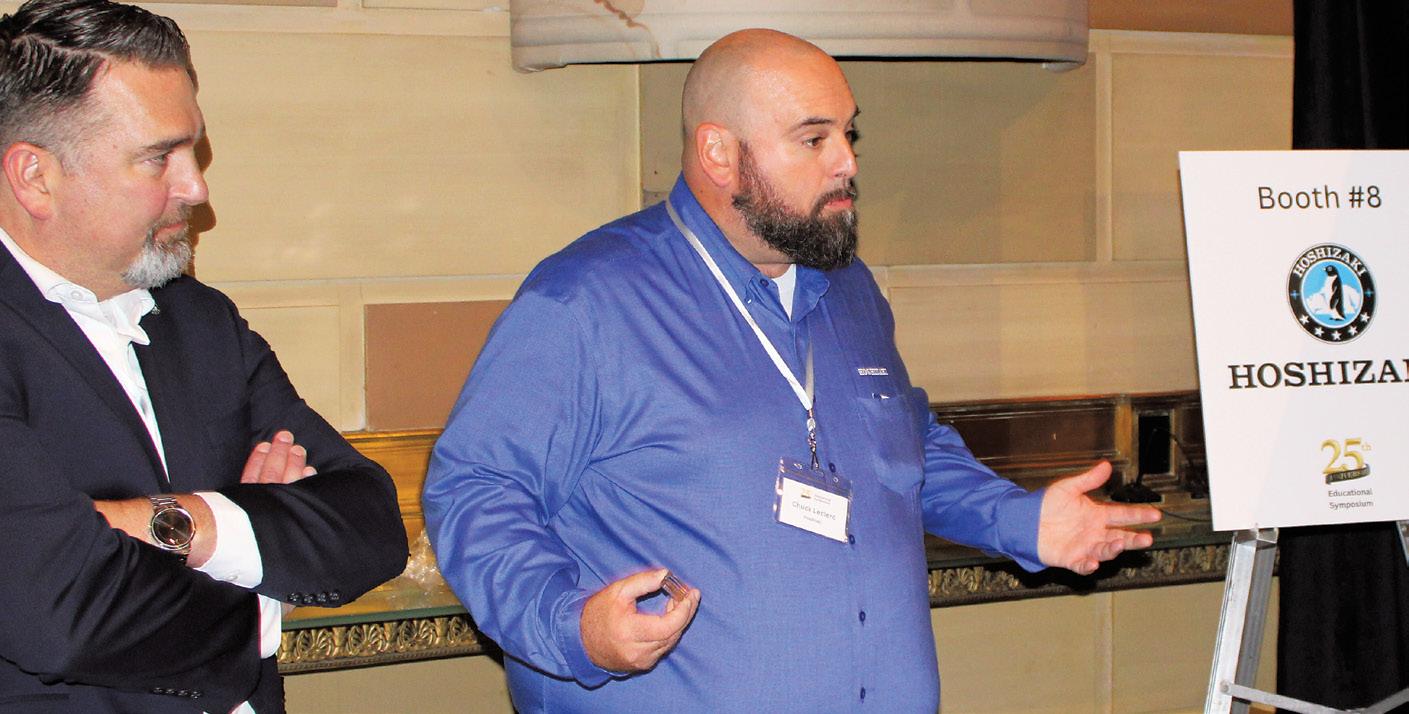

and better at their jobs. As long as we can keep AI under control, it should be as great of a tool as the internet has become.”
Beth Z’s talk resonated with the audience, sparking conversations about how companies can integrate AI into their operations without losing the personal touch that remains essential in the food service industry.
While technology was a key focus, the heart of the evening was about relationships and legacy. Schultz shared touching stories of long-time partnerships, including one with Ira Kaplan, a mentor who helped her in the early days of her career. “It’s one of the dearest stories of my career,” Schultz said with a smile. “Ira first gave us his help, and years later, his granddaughter is on her way to becoming an integral part of our team.”
The star-studded list of attendees included large contingents from leading dealers including Culinary Depot, Sam Tell and Singer. “You realize that leaders lead in our industry because of their commitment to growth and learning. They never miss an opportunity to learn! Their teams are constantly attending seminars and educational programs,” Schultz noted. “Success isn’t a difficult recipe, but it’s one you have to follow, and they do.” With Tri-State’s growth into New England and Pennsylvania and upstate New York notable figures including Matt Starr from Boston Showcase were in attendance.
The celebration wrapped up with a panel on the state of the industry moderated by TFS publisher Fred Klashman. It featured key industry leaders: Bill Chodan of Flik, SEFA’s Rachael Weaver and culinary guru Joshua Kohn of JLL. They discussed challenges and opportunities facing the food service sector, with topics ranging from sustainability to labor shortages. The panel provided valuable insights that attendees could take back to their own businesses.
As the event ended, Schultz and Gobioff took the stage to reflect on the importance of building a team of great, kind people. “I learned a long
continued on page 70







time ago that you could hire someone who knows everything about selling, but you can’t teach them to be nice, humble, and genuine,” she said. “But hire someone with those attributes, and you can teach them to sell any day.” Tri-State Marketing’s 25th anniversary wasn’t just a celebration of the past; it was a powerful reminder of the company’s commitment to relationships, innovation, and staying ahead of the curve. With the right mix of technology and personal touch, Schultz and her team are ready to lead the company into the next 25 years.
For more information on Tri-State Marketing, visit their website at https://www.tri-statemarketing.com/





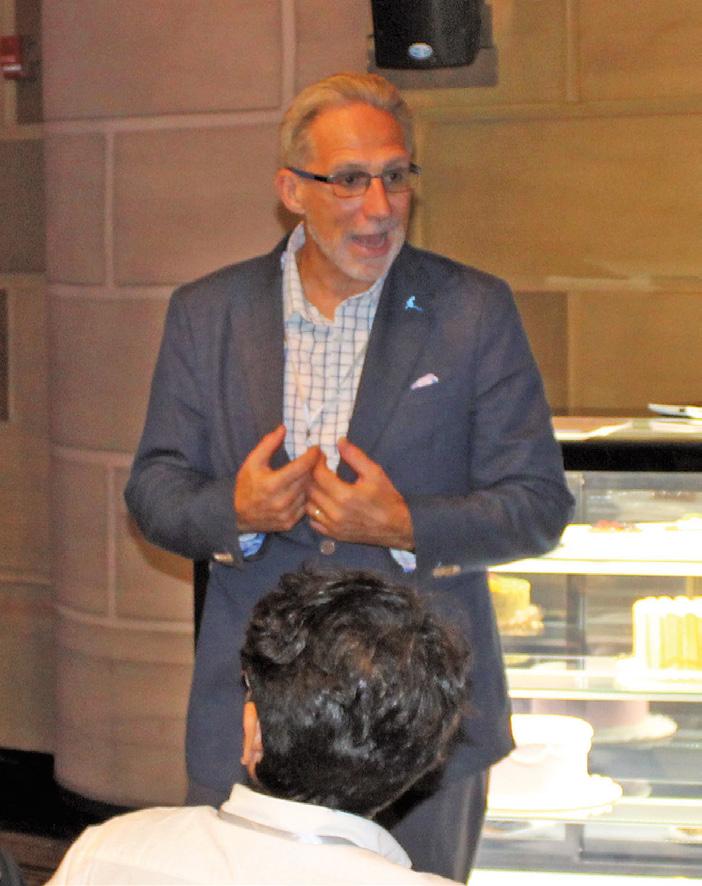






The 2024 Imperial Dade Innovations Expo made its highly anticipated return to the Meadowlands Exposition Center in Secaucus, NJ, drawing an impressive crowd of industry professionals and business leaders from across the country. This year’s event, part of Imperial Dade’s “Hands On” series, was once again a platform for hands-on demonstrations of the latest packaging and cleaning innovations and a critical networking hub for vendors and Imperial Dade’s expansive sales force.
Imperial Dade, a leading North Amer-


ican distributor of foodservice packaging, industrial products, and janitorial supplies, used the Expo to strengthen its ties with customers and vendors alike. Attendees were given the unique opportunity to not only interact with the products firsthand but also to meet faceto-face with the industry experts behind them.
Central to the appeal of the 2024 Innovations Expo was the immersive, handson experience it provided. Customers could see, touch, and test the latest advancements in cleaning and packaging solutions, allowing them to understand
how these products could enhance their day-to-day operations.
Bob Tillis, Chairman of Imperial Dade, spoke about the importance of this approach. “We’ve always believed that the best way for our customers to truly grasp the value of new products is to interact with them directly,” Tillis said. “This Expo is designed to give our customers that opportunity. They can see how the latest solutions fit into their workflows and have meaningful discussions with our experts about how to optimize their operations.”
The Expo featured a wide array of

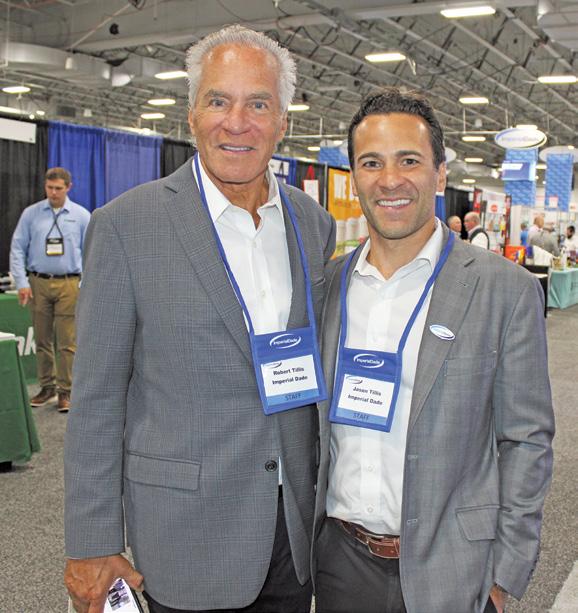

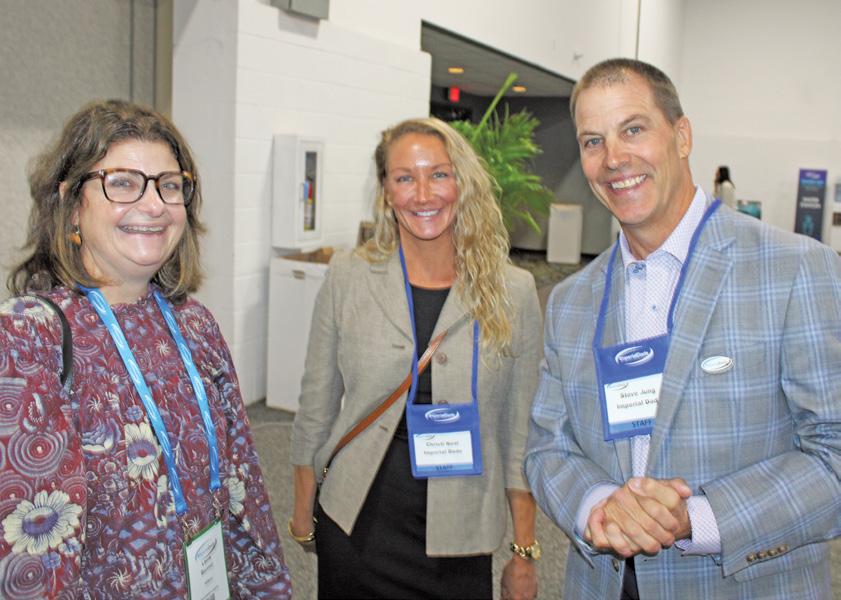
cutting-edge solutions, from sustainable foodservice packaging to advanced robotic cleaning systems. These innovations reflect the industry’s growing focus on sustainability, efficiency, and hygiene—trends that have become even more pronounced in the wake of the COVID-19 pandemic.
Jason Tillis, CEO of Imperial Dade, echoed his father’s thoughts, adding, “Our Innovations Expo isn’t just about showing products—it’s about creating those valuable ‘aha’ moments for our
continued on page 74



customers. We want them to leave the event with new ideas and insights that they can immediately apply in their businesses.” He continued, “At the same time, it’s a chance for us to spend quality time with our vendors and sales personnel, ensuring that we’re all aligned in delivering the best possible solutions to our customers.”
The 2024 show also provided valuable opportunities for Imperial Dade’s vendors to interact directly with the company’s extensive sales team. This face-to-face time is critical, ensuring that Imperial Dade’s sales representatives are well-equipped with in-depth knowledge of the products and solutions they offer.
“This event is as much about our vendors as it is about our customers,” Jason Tillis emphasized. “We make sure that our sales team is fully informed on the latest innovations, and in turn, they can pass that knowledge on to our customers. The relationships we foster at the Expo are crucial to maintaining the high level of service we’re known for.”
Vendors from around the globe participated in the Expo, showcasing an impressive range of products. Exhibitors brought their newest innovations in packaging, cleaning, and sanitation, many of which are designed to meet the ever-evolving demands of the restaurant, hospitality, and facilities management industries. These industries have increasingly emphasized sustainability and operational efficiency, trends that were reflected in the solutions displayed throughout the Expo.
Imperial Dade’s Innovations Expo has long been a critical part of the company’s strategy for staying ahead of in-
dustry trends. The 2024 event was no exception, with a particular focus on solutions that reduce waste, improve hygiene, and streamline operations.
For example, Imperial Dade’s Victoria Bay foodservice packaging line was a key feature at the show. This expanded product range helps businesses minimize waste by offering right-sized packaging options, perfect for optimizing portion control and reducing food waste. Attendees were able to explore these solutions up close and speak with Imperial Dade experts about how to incorporate them into their operations.
“The show really gave operators the opportunity to find the perfect fit for food containers, bags, and other packaging materials, with the goal of minimizing waste and saving money,” Bob Tillis noted. “These are the kinds of solutions that not only improve efficiency but also contribute to long-term sustainability.”
Additionally, the 2024 Expo featured a dedicated focus on preventative maintenance for cleaning equipment. Imperial Dade’s certified technicians were on-site to demonstrate how regular maintenance and asset management strategies can prolong the life of costly floor equipment. This hands-on pop-up repair shop was a hit with attendees, many of whom rely heavily on these machines in their daily operations.
Imperial Dade’s Innovations Expo continues to be a vital resource for addressing industry-specific and regional challenges. This year, a particular focus was given to New York City’s evolving waste management regulations, which have placed new demands on business-
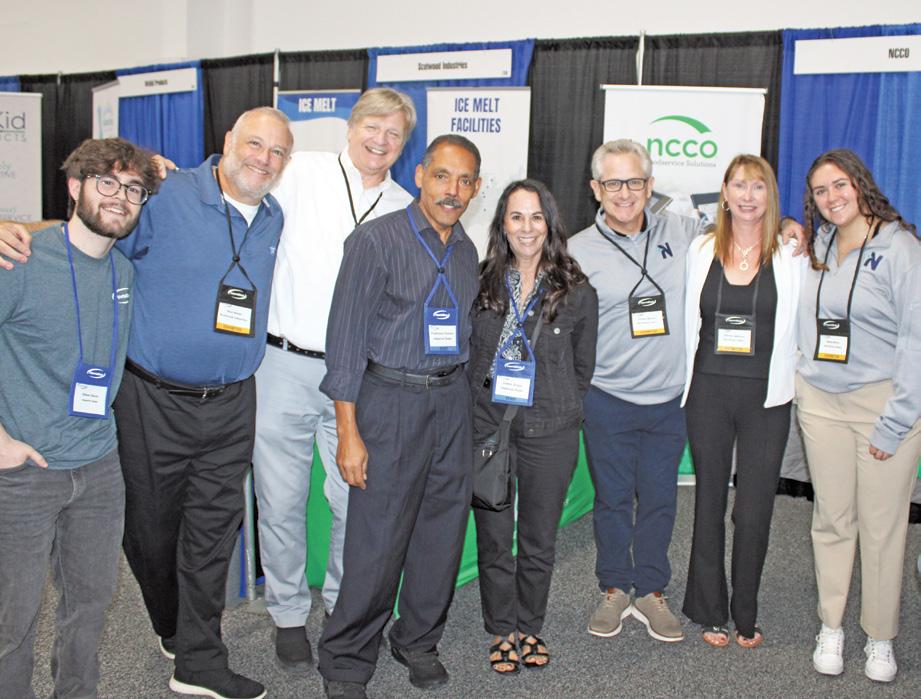


es. Imperial Dade showcased an array of waste management products, from heavy-duty receptacles to can liners designed to meet the latest compliance standards.
Laura Craven, Vice President of Marketing for Imperial Dade, discussed the company’s responsiveness to these changing needs. “Our New York City customers are facing new challenges with waste collection, and we were ready at the Expo with a full range of solutions to help them adapt,” Craven said. “The Expo is all about being proactive—giving our customers what they need to stay ahead of the curve.”
As the 2024 Innovations Expo came to a close, it was clear that Imperial Dade is committed to remaining at the forefront of the packaging and cleaning industries. With over 130 locations across North America, the company’s rapid expansion is fueled by its customer-first approach and a relentless focus on innovation.

In line with this growth, Imperial Dade recently completed its 91st acquisition with the purchase of Excell Direct, LLC, a premier distributor of foodservice and janitorial products in Arizona. Bob Tillis welcomed the Excell team, saying, “We’re excited to bring Excell Direct into the Imperial Dade family. Their focus on customer service aligns perfectly with our mission, and we look forward to expanding our presence in the Southwest.” Jason Tillis added, “This acquisition allows us to continue our growth while maintaining the high level of service and innovation that our customers expect. We’re looking forward to a future of continued success and collaboration with the Excell team.”
With the success of the 2024 Innovations Expo and its latest acquisition, Imperial Dade shows no signs of slowing down, solidifying its position as a leader in the distribution of packaging and janitorial supplies across North America.


As restaurant owners and managers are well aware, accepting credit card payments from customers involves costs for the restaurant, including the credit card companies charging service fees for the use of their cards. These service fees, also known as transaction fees or interchange fees, are a standard part of processing customer payments. However, when it comes to the processing of employees’ tips on those same credit cards, there is an ongoing debate about who should absorb these transaction fees - the restaurant or the worker? The answer to this question varies significantly depending on what state your restaurant is located in.
Currently, under federal law, employers are in fact permitted to deduct credit card transaction fees from an employee’s tips, when the tip is paid to the employee via a credit card transaction. There are restrictions to this practice, however. For example, an employer may not deduct in a manner that reduces an employee’s pay below minimum wage. Further, an employer may not deduct more than the value of the credit card transaction fee. In other words, if a credit card company charges a fee of 2% for any credit card transaction at a restaurant, federal law allows the restaurant to provide the employee 98% of the credit card tips and stay compliant with federal law.
Though federal law allows this practice, some states have passed prohibitions on this practice, e.g., California, Maine, New Jersey and Pennsylvania, making it unlawful for an employer to take deductions from an employee’s tips for credit card transaction fees. The group of states that prohibit this

practice of tip deduction for transaction fees is growing. Recently, in August 2024, Minnesota joined the list of states that prohibit any deduction of interchange fees from employees’ tips.
In contrast, there are states that protect the employer’s ability to make tip deductions for the credit card transaction fees. These states include Alaska, Illinois, Maryland, New York, North Carolina, Rhode Island, Washington state, and Washington D.C. Further, there are many states that have not passed their own laws regarding deducting credit card transaction fees and currently follow the federal rules. As these rules vary state by state, restaurant owners need to be well versed in the rules of the states they conduct business in to avoid engaging in an improper business practice.
Even when a restaurant operates in a state that allows tip deductions based on transaction fees, employers must still be cautious when implementing this practice. From a practical perspective, determining the amount of fees to deduct from tips is complex and can lead to le-
gal complications. For instance, credit card companies charge varying transaction fees; the fees can be different from card to card. As there is not one uniform fee across the board, restaurants should work with employment counsel to confirm that the amount they are deducting does not exceed what is legally permitted.
Further, even in states where the tip deduction is allowed, restaurants have faced lawsuits alleging that they deducted more from their employees’ tips than the actual transaction fees incurred or for extraneous fees outside the credit card transaction fee. These legal challenges make clear that restaurant owners must ensure they are not deducting in excess to avoid facing allegations that they are improperly deducting from employees’ tips and maintain proper recordkeeping practices to ensure compliance.
This landscape is further complicated by third-party food delivery services and their associated fees. There have been multiple lawsuits addressing the transaction fees charged by these third-party

Caitlin Breen is an Associate in the Labor & Employment Group at Ellenoff Grossman & Schole LLP. Her practice spans a broad range of employment matters throughout all phases of litigation, including wage and hour matters, employment discrimination, retaliation, and other employment related claims. Ms. Breen assists clients with employment issues, including drafting workplace policies and handbooks and advising regarding compliance with federal and state employment laws. In addition to her practice, Ms. Breen serves as an adjunct professor at Cardozo School of Law where she teaches a course on lawyering and legal writing. Ms. Breen can be reached at (212) 370-1300 or cbreen@egsllp.com.
delivery services and the deductions of these transaction fees from the tips of their delivery workers. The outcomes of these cases have varied. Some courts have found that the transaction fees charged by the third-party delivery companies are similar to credit card transaction fees and can be properly deducted from tips of delivery workers. Other courts have found that the third-party delivery transaction fees encompass extraneous costs beyond what can be deducted from a worker’s tips. As thirdparty delivery services are now an integral part of the hospitality industry, employers should be focused on and aware of future developments in this area.
The proper handling of credit card transaction fees and deductions from an employee’s tips is a complex issue that continues to change both in the legislature and the courts. Restaurant owners must be proactive in adapting to these changes to avoid liability. Restaurant owners should work closely with employment counsel to navigate this changing landscape, keep up to date with state and local laws, and regularly ensure their business practices are compliant. Legal counsel can assist with managing tip policies and transaction fee deductions, making sure that employers do not improperly deduct tips from employees.


In today’s competitive pizza industry, top pizzerias rely more than ever on the flexibility and consistency of their pizza ovens to meet evolving customer demands. With a growing variety of pizza styles, from traditional Neapolitan and New York to Detroit deep-dish, ovens must adapt seamlessly to diverse cooking techniques. Additionally, alternative crusts, such as gluten-free, add complexity to the process, making precise temperature control and even heat distribution essential. A versatile, reliable oven is no longer a luxury—it’s a necessity for pizzerias striving to maintain quality and keep up with the latest culinary trends. That versatility took centerstage last
“We designed Pegasus pizza ovens to cook a wide variety of pizzas. With more than 35 pizzerias attending the event, it was the perfect opportunity to demonstrate how adaptable our ovens are to different pizza styles.” — Dave Rourke
month as Galaxy Group brought their state-of-the-art Pegasus pizza ovens to Dave Portnoy’s annual One Bite Pizza Fest, supplying 40 ovens to support some of the nation’s top pizzerias. After the success of their initial participation last year at the New York City event, where they provided six ovens, Galaxy Group significantly expanded its role in
2024, becoming a key contributor to the festival’s culinary excellence. For Galaxy Group, the opportunity to participate in such a high-profile event underscores the growing reputation of its Pegasus line and the brand’s commitment to supporting the best in the pizza industry. The festival featured over 35 renowned pizzerias, each with their own

signature style, from traditional Neapolitan to deep-dish and New York-style pizzas. The flexibility and reliability of Pegasus ovens allowed them to seamlessly support each pizzeria’s unique needs.
“The request for more ovens came directly from the festival organizers,” noted Hakan Inan, Chief Operating Officer of Galaxy Group. “Last year, we supported the event with six ovens, and the feedback from pizzeria owners was overwhelmingly positive. Based on that success, they decided to go with 40 ovens this year.” The growth in demand reflects the trust the event’s organizers continued on page 116


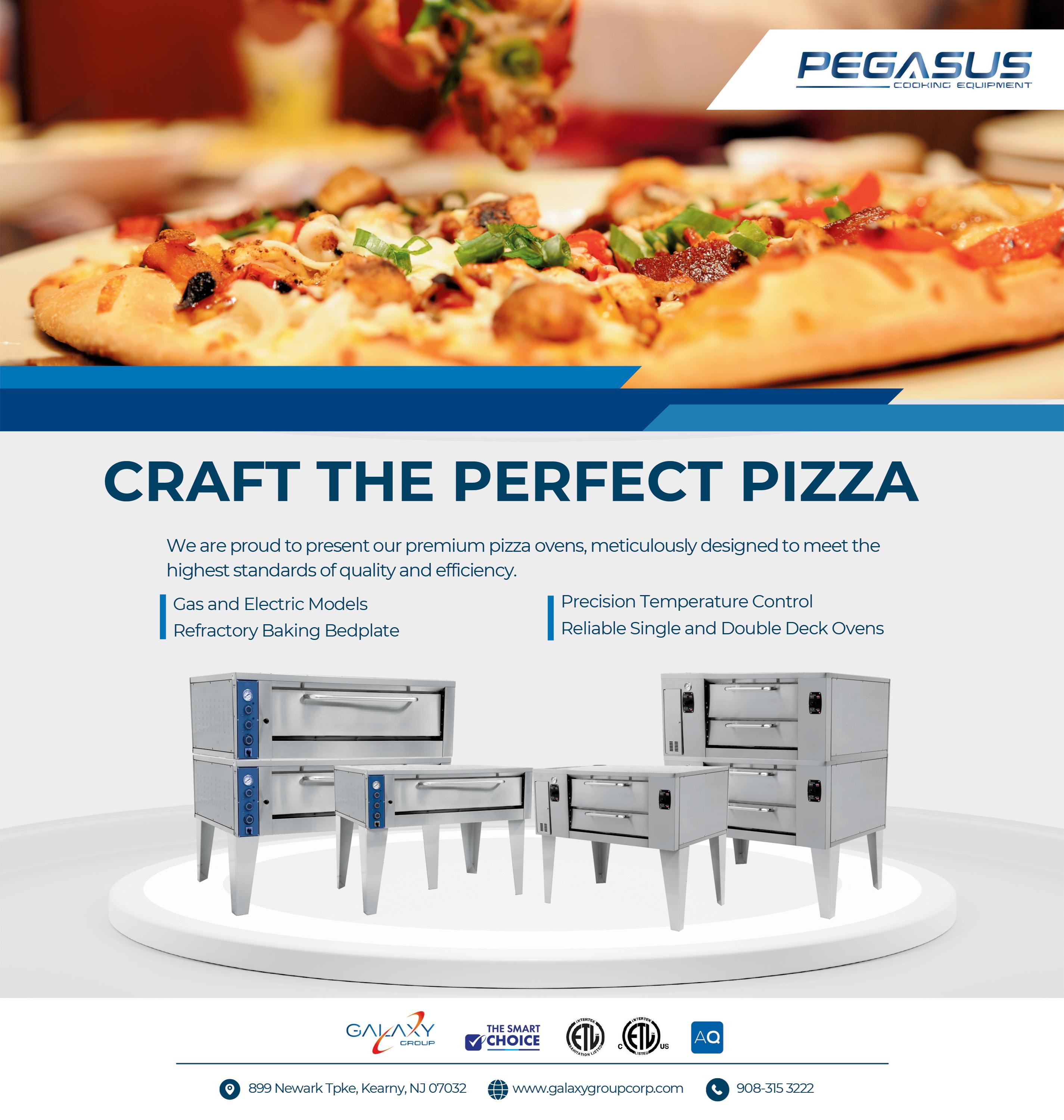




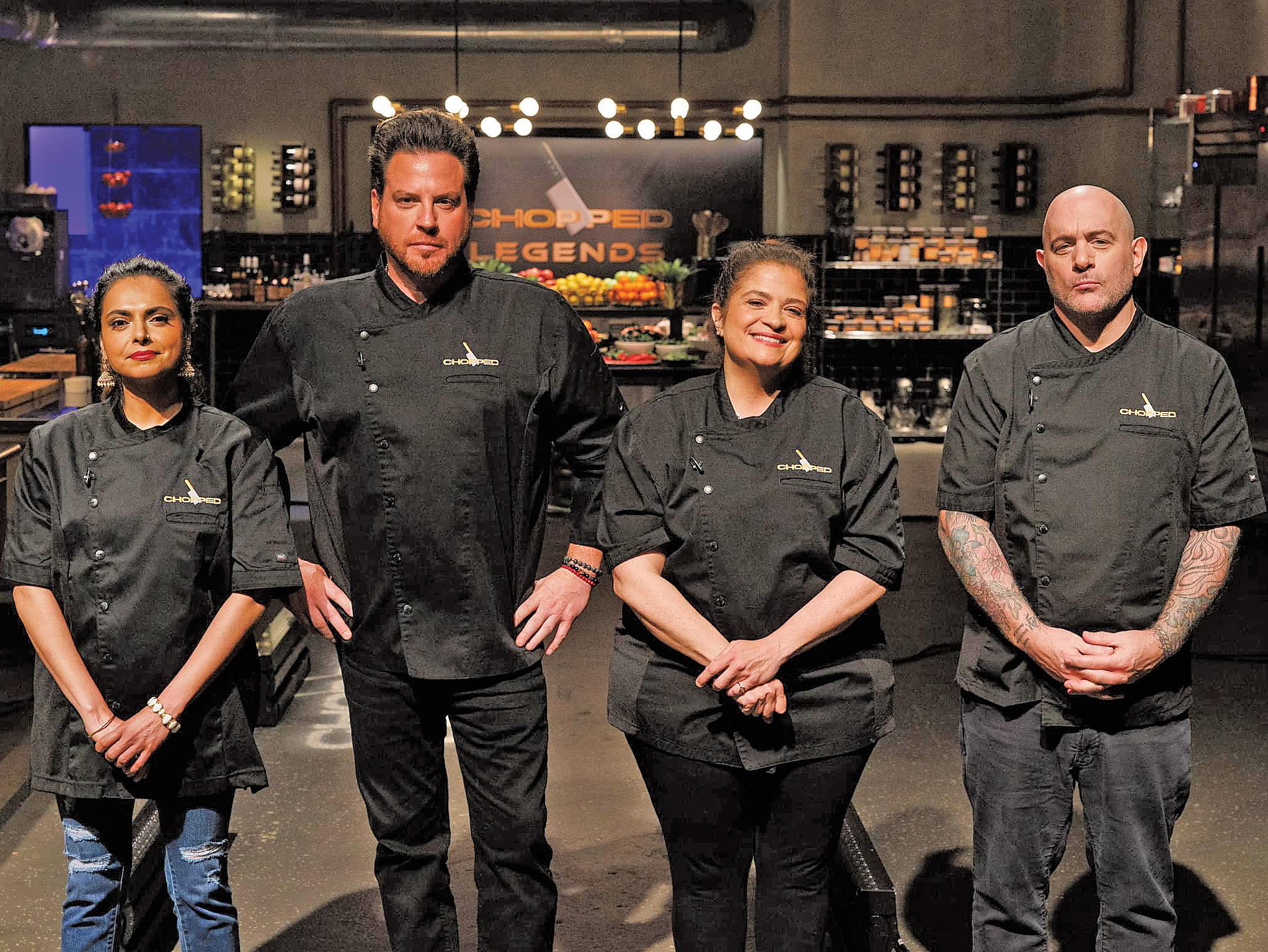
Chopped Legends Tournament
Maneet Chauhan, Scott Conant, Alex Guarnaschelli and Chef Chris Santos are searching for a new culinary legend among the 16 chefs competing. They are ready to see their four hand-picked Chopped Champions battle it out in the all-new Chopped Legends Tournament. In the grand finale, these legends will step in as sous chefs for their winning mentee.
Matt Sartwell, Managing Partner, Kitchen Arts & Letters Bookstore in New York City shares his book reviews...
Zahav Home: Cooking for Friends and Family by
Michael Solomonov and Steve Cooks
WHAT WE’RE LISTENING TO:

From the popular Philadelphia eatery comes this friendly, hands-on guide to preparing the restaurant’s Israeli-inspired food at home.
Writing with his business partner Steve Cook, Chef Michael Solomonov offers food which tips its hat to Middle Eastern favorites and flavors as well as Ashkenazic classics. It also demonstrates familiarity with a wider range of culinary influences.
So among the recipes here you’ll find the likes of:
• Both red and green shakshukas; butternut squash baba ganoush; kofte meatballs with pomegranate and sumac
• Romanian eggplant with garlic confit; matzo ball soup; potato kugel
• Avocado salad with peaches; Arabic coffee bbq chicken; cabbage cacio e pepe
The recipe selection emphasizes easy preparation for both weeknight meals and for having people over. Photo sequences help demystify seemingly ambitious tasks like spatchcocking a chicken or braiding challah. It’s all part of the book’s upbeat effort to encourage home cooking.
Flavorama: A Guide to Unlocking the Art and Science of Flavor by
Arielle Johnson
A flavor scientist known for work in places such as Noma’s fermentation lab and for lectures at MIT, SXSW, and Tales of the Cocktail, Arielle Johnson has
continued on page 112

As the Executive Director of the New York City Hospitality Alliance, I’ve seen firsthand how the restaurant industry is woven into the very fabric of our city. Whether you’re a visitor coming for a slice of pizza in Brooklyn or a local seeking a five-star meal in Manhattan, New York City’s food scene defines many people’s experiences. That’s why the city’s latest efforts to reduce storefront vacancies, boost neighborhood revitalization, and launch dynamic new tools like nyctourism.com are so critical—not just for small businesses, but particularly for restaurateurs.
Restaurants don’t just serve food; they provide a cultural and social experience, and they help to define New York City as a global destination. With this new push to highlight events, attractions, and deals, restaurateurs are poised to benefit from increased foot traffic, exposure, and community engagement like never before. Here’s how these developments will shape the future of NYC’s restaurant industry.
The NYC administration has placed significant emphasis on revitalizing commercial corridors across the five boroughs. By actively reducing storefront vacancies, offering nearly $5 million in grants, and working closely with local organizations, the city is creating a fertile environment for growth. For restaurateurs, this means more opportunities to fill empty spaces and launch new concepts in areas that were once struggling.
The lower vacancy rates across the Bronx, Queens, and Staten Island, combined with a substantial drop in vacancies in Manhattan, tell a positive story. A lively neighborhood filled with diverse businesses draws more people, making it more likely that diners will visit local restaurants as part of

A lively neighborhood filled with diverse businesses draws more people, making it more likely that diners will visit local restaurants as part of their overall experience.
their overall experience. The health of a restaurant often depends on the foot traffic generated by surrounding businesses, and with the city’s renewed focus on these commercial corridors, it’s a win-win for everyone.
NYC has always been a top tourist destination, but even the most seasoned visitors need help navigating the vast landscape of attractions, events, and dining options. This is where nyctourism.com, the official tourism website of New York City, comes in. The site acts as a central hub for tourists to explore events and attractions while discovering the local restaurants that make New York City such a unique place to visit.
As restaurateurs, this platform is a game-changer. Whether someone is attending a Broadway show or walking through Central Park, nyctourism.com helps direct visitors to nearby dining options. It not only allows tourists to search for places to eat by neighborhood, cuisine, and price range, but it also showcases exclusive deals and offers, helping visitors get the most out of
their dining experience.
By partnering with the website, restaurants can reach a larger, more targeted audience of visitors who are actively seeking out new experiences. Whether it’s a tourist planning a night out or a local looking to try a new spot during restaurant week, this tool increases visibility and drives more people through the doors.
New York City is famous for its yearround events—from Fashion Week to the Tribeca Film Festival, there’s always something happening. The city administration is putting a major emphasis on promoting events, attractions, and neighborhood experiences through platforms like nyctourism. com, which will undoubtedly help bring more people into the city. But it’s not just about attending these events— it’s about pairing those experiences with dining.
Imagine you’re visiting the city for the U.S. Open. You go to nyctourism. com to see where you can grab dinner afterward, and you discover a great local restaurant in Flushing, Queens,

www.thenycalliance.org/
offering a special deal for Open attendees. This is the kind of synergy that brings long-term benefits to both event-goers and restaurant owners. Events generate excitement, and dining completes the experience.
Restaurants should seize this moment to collaborate with event organizers, theaters, and attractions. Crosspromotions, special pre-fixe menus tied to cultural happenings, and latenight dining options for those attending concerts or shows can create new revenue streams. The ability to align a restaurant’s offerings with the pulse of the city’s cultural calendar will help restaurateurs boost traffic and create memorable experiences for both locals and tourists alike.
At their core, restaurants are about bringing people together. Whether it’s sharing a meal with family or making new connections over cocktails, restaurants help build community. The city’s new initiatives, particularly the $4.8 million in neighborhood revitalization grants, will not only make New
continued on page 118

US corporations are grappling with the challenge of transitioning employees from hybrid work schedules back to in-office “residency.” One creative approach being used is leveraging enticing food options to make the workplace more appealing. The foodservice management industry is stepping up, using technology and AI to enhance both the dining experience for employees and streamline operations for their teams. These innovations aim to create convenience and comfort, from personalized meal options to automated processes. However, the industry treading carefully as it attempts to balance this modernization carefully, ensuring that employees embrace the changes without feeling overwhelmed by the technology.
With that backdrop, The Society for Hospitality and Foodservice Management (SHFM) hosted its highly anticipated annual National Conference in Baltimore last month, bringing together thought leaders, innovators, and professionals from across the workplace hospitality and amenities sector. The conference, which celebrated
SHFM’s 45th anniversary, was packed with insightful sessions, inspiring keynotes, and notable events, all centered around this year’s theme of “Finding Our Purpose” and embracing “Unreasonable Hospitality.”
From exploring the future of workplace hospitality to recognizing emerging talent with the unveiling of the SHFM Rising Stars, the event offered a comprehensive view of where the industry is heading. Attendees left with valuable knowledge, strengthened connections, and renewed inspiration to drive change in their organizations.
One of the main highlights of the conference was the keynote delivered by Will Guidara, the bestselling author of Unreasonable Hospitality and co-producer of The Bear. Guidara captivated the audience with insights into his journey transforming Eleven Madison Park from a brasserie to the world’s best restaurant. His central message was that food, service, and design are merely ingredients in a more important recipe: the human connection. Guidara emphasized that creating a “one size fits one” approach to hospitality can spark moments of magic in the workplace and leave a last-


ing impression on customers and clients alike.” The key to success lies not just in the quality of food or design, but in how deeply we engage with people,” Guidara said. His talk resonated strongly with conference attendees, particularly in the context of workplace hospitality, where creating personalized and memorable experiences is paramount.
Eve Turow-Paul, author and expert in global food trends, provided another captivating session focused on generational shifts in food consumption and hospitality. Her presentation dove deep into how younger generations value authenticity, wellness, and sustainable practices. “We’re seeing a significant movement toward conscious consumption,” she remarked, highlighting the growing importance of aligning hospitality services with these values. Turow-Paul’s insights into how generational trends are reshaping the foodservice industry gave attendees practical takeaways to apply in their own organizations.
The SHFM National Conference is not just a forum for ideas—it’s also where the future leadership of the organiza-
continued on page 106


by Josephine
Arestaurant’s unique brand and vision can be the defining factor in what creates a loyal customer. Loyal customers want to know what they can expect, and they return expecting consistency and highquality food and service. National chain Freddy’s Frozen Custard and Steakburgers is at the forefront of this strategy, proving themselves to be innovative leaders in the world of cook-to-order food while keeping guest satisfaction at the center of their brand.
“All of our innovations are centered around our core,” said Brian Wise, Chief Operating Officer of Freddy’s. “We’re never going to stray too far from what we’re doing.” The “core” that Wise refers to, began back in 2002 in Lawrence, Kansas. It’s also known as the “Freddy’s Way,” which focuses on putting others first, and always keeping guests in mind. Freddy’s started that year as a family-owned and operated business, and shortly after it opened, franchisees began to build many of the brand’s original locations. Most of those franchisees
“We’re a cook-to-order brand, and that comes with a certain amount of timeliness.” — Brian Wise
were close family friends, and one of them was Wise himself.
Wise left his corporate job and bought his first Freddy’s franchise in 2004. He went on to build 34 more locations by 2019, when he decided that he wanted to impact the company on a bigger scale. He joined the corporate office, and in 2022, was promoted to COO. Despite the shift in leadership, Wise has been able to hone into Freddy’s core values through a variety of different innovations while keeping “Freddy’s Way” alive.
When he joined the corporate office, one of the first things on his agenda was bettering the guest experience specifically through speed-of-service times, which is a main factor that makes Freddy’s stand out. “We’re a cook-to-order brand, and that comes with a certain amount of timeliness,” said Wise. Speedof-service is especially important when it comes to the drive thru and meet-
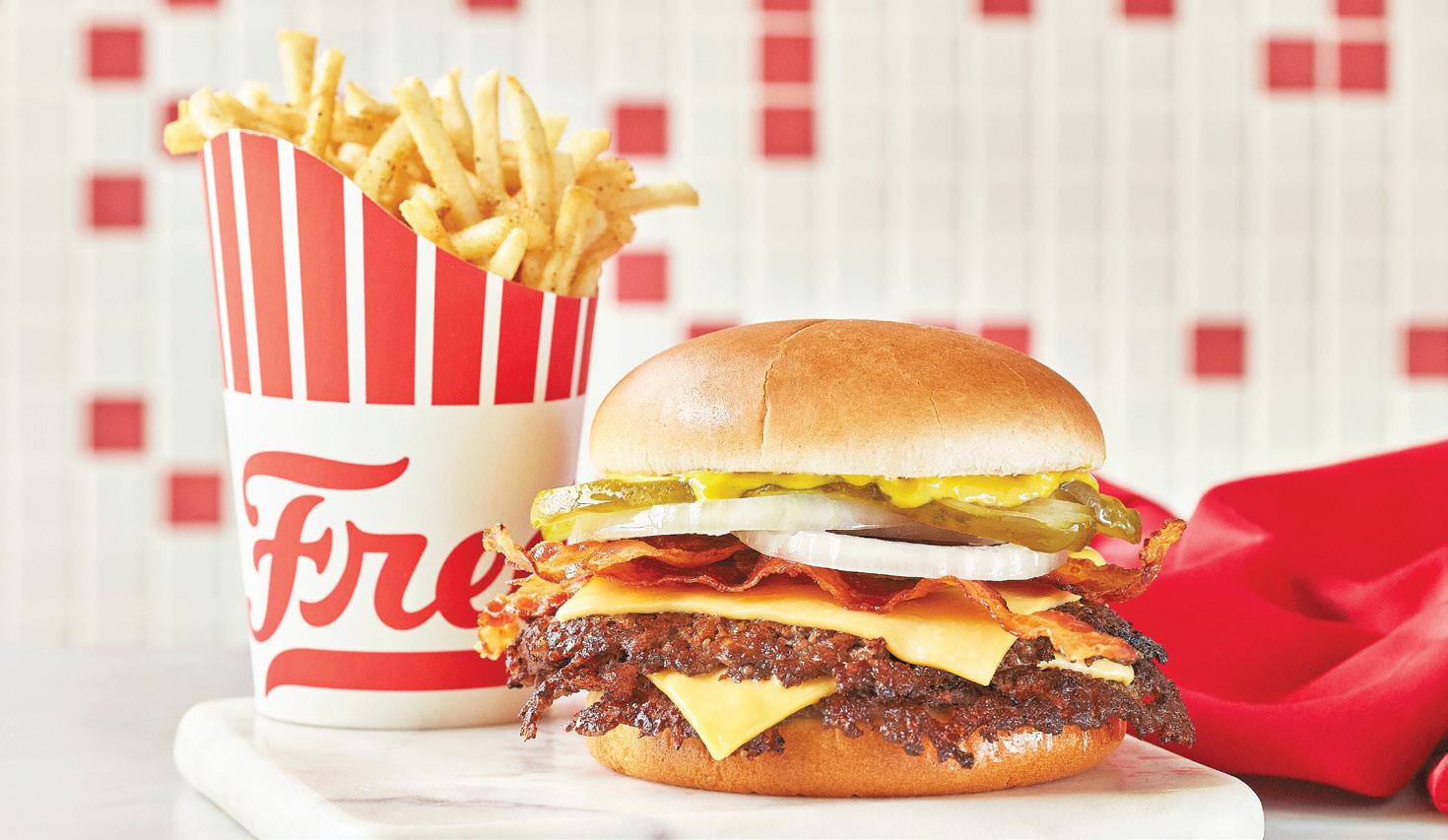
ing expectations and throughput times there.
The COVID-19 pandemic was, naturally, a hurdle for Freddy’s, but the company’s goal of executing cook-to-order food quickly and deliciously came in handy and made the transition to drivethru-only fairly simple. “We saw it as an opportunity to look at our business through a different lens,” Wise said. “It really forced us to see if we could meet speed and accuracy while delivering exceptional food.” And, undoubtedly, it did. The pre-existing skills that Freddy’s team members had helped keep customer throughput consistent, even during the pandemic.
After the pandemic, it became clear that the vision and values of the business were important to maintaining its success. “It’s crucial that a brand knows their brand positioning, and for Freddy’s, it’s cooked-to-order food and food

Brian Wise
that is grill-heavy,” Wise noted. Knowing who they are is what helps Freddy’s achieve consistency and high quality. With cooked-to-order food and great customer service at the core of their business, Freddy’s looks for ways to assist employees without compromising the quality of its food through technol-
continued on page 106
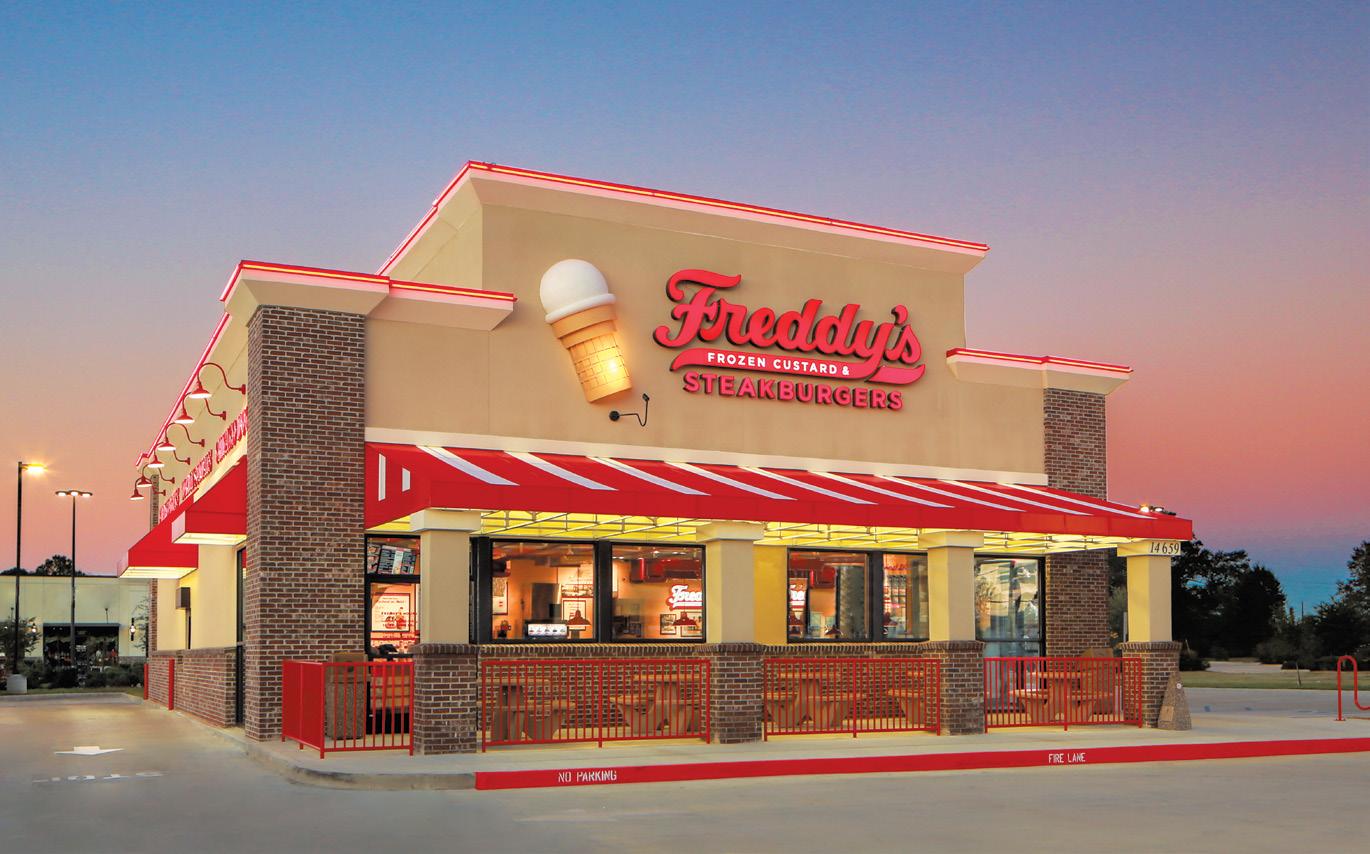
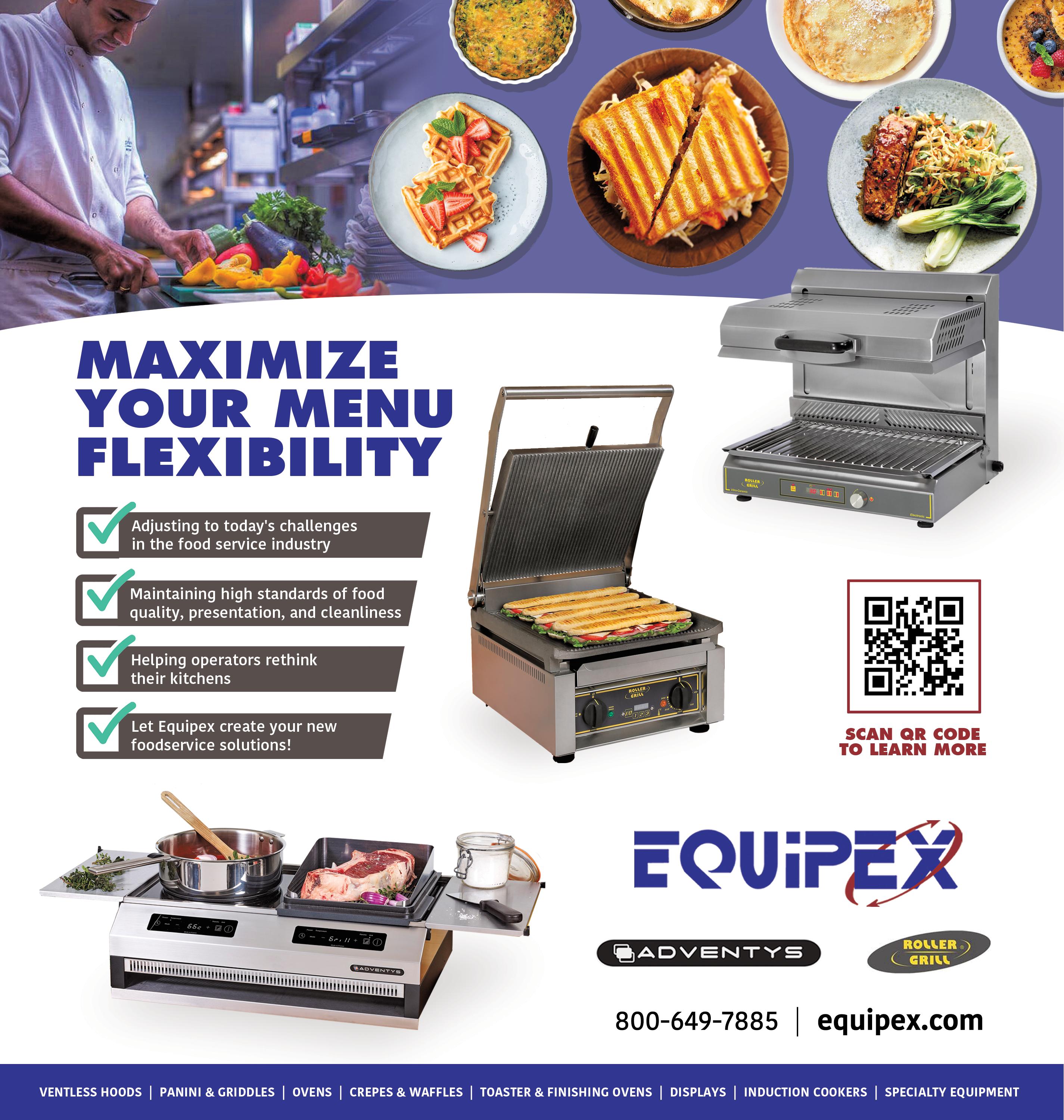
Thompson Restaurants has firmly established itself as a key player in the culinary scene of the Mid-Atlantic, and its recent expansion with the opening of Hen Quarter Prime in Washington, DC’s Buzzard Point further cements the company’s influence. Known for its Southern-inspired dishes and a focus on premium, full-service dining, Hen Quarter Prime is the latest manifestation of Thompson’s strategic growth within competitive urban markets. But as the company scales up in the nation’s capital, it is also navigating the complexities of doing business in a city where legislative changes, particularly regarding the service industry, present significant challenges.
Thompson Restaurants, a familyowned business under the umbrella of Thompson Hospitality, operates over 70 restaurant locations under 14 unique brands, including Big Buns Damn Good
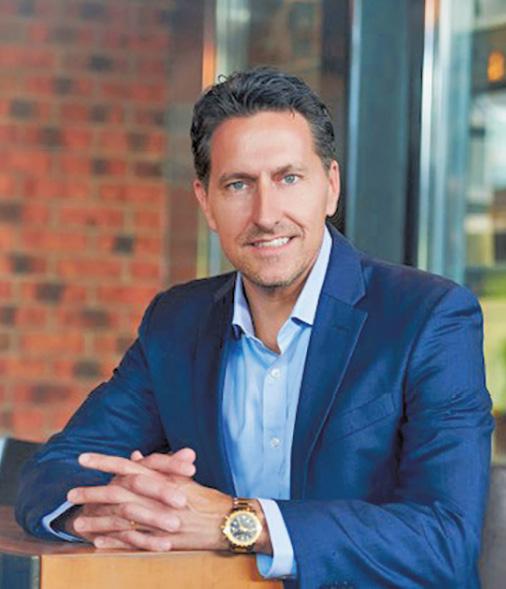
Burgers, Milk & Honey, Matchbox, and Wiseguy Pizza. Alex Berentzen, the Chief Operating Officer (COO) of Thompson Restaurants, has been instrumental in guiding this growth. According to Berentzen, Hen Quarter Prime represents more than just another addition to their portfolio; it signals a refined evolution of what Southern dining can offer.
“Hen Quarter Prime is our love letter to Southern cuisine but elevated for a more discerning palate,” Berentzen explained. “This location is special because it blends everything people love about the South—comfort, hospitality, and rich flavors—with a premium, modern twist. We’re confident this will become a cornerstone for upscale dining in Buzzard Point.”
Hen Quarter Prime is the second location in the Hen Quarter family, following the success of its first restaurant. The decision to expand in DC’s Buzzard Point, with its waterfront views and proximity
“We’re excited about what’s ahead. Hen Quarter Prime is just the beginning of our next phase.” — Alex Berentzen
to the rapidly developing Capitol Riverfront, is a bold move for Thompson Restaurants. The 6,600-square-foot venue seats over 200 guests and features private dining spaces, retractable windows, and luxurious interiors—all designed to create a memorable dining experience. Yet, opening in DC comes with hurdles beyond just building and design.
Washington, DC is currently grappling with a policy shift that could fundamentally change how restaurants do business: the legislative push to eliminate the tipping system, known as Initiative 82. Passed in 2022, this initiative gradually increases the minimum wage for tipped workers to match the city’s standard minimum wage. While intended to

create wage stability for employees, the initiative has created financial uncertainty for many restaurant operators in the city, including Thompson Restaurants.
For Berentzen, navigating this new economic landscape has required careful planning and adaptation. “The elimination of the tip credit is a huge shift,” he said. “It’s not something that our customers, or even our employees, were asking for. The consequences are complex, especially for a city like DC, where operating costs are already skyhigh. Every time the wage increases, we have to adjust prices or absorb the hit, and it’s challenging to maintain the balance between profitability and customer experience.”
Unlike some competitors who have responded by adding service charges or reducing staff, Thompson Restaurants has taken a different approach. “We made a conscious decision not to add a service charge,” Berentzen noted. “We want transparency in our pricing. The price you see on the menu is what you pay, and we believe that’s the fairest model for our guests. However, it’s not an easy decision, especially when margins are already thin.”
Hen Quarter Prime’s debut in Buzzard Point is a testament to Thompson Restaurants’ confidence in the DC market, despite these challenges. “We are bullish on DC, even though it comes with its
continued on page 116


Maintaining a clean commercial kitchen is no longer just about appearance—it’s about safety, compliance, and maintaining the trust of your customers. As the Chief Executive Officer of York Building Services, I’ve seen firsthand the critical impact professional cleaning services can have on food service operations. Whether you’re a restaurant owner or a foodservice operator, the difference between success and failure can often be found in the details of how you manage cleanliness. Today, I want to share why professional cleaning isn’t just a luxury, but a necessity, and how it can help you avoid costly mistakes, stay compliant, and keep your reputation intact.
Every restaurant or commercial kitchen is subject to Department of Health (DOH) inspections, and failing to meet
Over time, even small lapses in cleanliness can lead to health code violations, potentially damaging your business’s reputation permanently.
their strict hygiene and safety standards can result in fines, shutdowns, or even permanent closures. This is where professional cleaning services can make a big difference.
Unlike in-house staff, professional cleaners are trained to focus exclusively on hygiene, using specialized methods and equipment that ensure compliance with regulations. For example, our teams at York Building Services use detailed checklists and inspection forms within a mobile app that tracks every area of the kitchen, ensuring nothing is overlooked.

This is complimented by daily ‘close outs’ by assigned supervisors and direct oversight by area managers and our operations team. It’s easy for in-house staff to skip corners or rush through tasks, especially when juggling multiple responsibilities and not being held duly accountable. In contrast, a professional cleaning service has one priority: your kitchen’s cleanliness.
Slippery floors, cross-contamination, and pests are some of the most common hazards we encounter in kitchens. Using the wrong cleaning products can create dangerous conditions, such as over-saturating floors and drains or improperly cleaning behind equipment where pests like fruit flies, roaches, and rodents love to hide. Over time, even small lapses in cleanliness can lead to health code violations, potentially damaging your business’s reputation permanently.
Hiring a professional cleaning service can seem like an added expense, but in reality, it’s a cost-saving measure and investment. I’ve spoken with many executive chefs who initially question the price of outsourcing cleaning. What they often don’t realize is the hidden costs of using untrained, in-house staff.
For instance, I frequently hear about overtime pay racking up because of inefficient cleaning practices, or staff misus-

Robert Rivadeneira is the co-founder and driving force behind York Building Services, Inc. (YBS), a two-time Inc. 5000 commercial cleaning company that has been providing highquality, professional building services to the New York Metropolitan Area for more than 25 years. Established in 1997 by Robert and his father, Alberto Rivadeneira, YBS specializes in creating safe, productive, and healthy environments for its clients, with a strong focus on the hospitality industry. Under Robert’s leadership, YBS has grown into a trusted partner for numerous businesses by offering tailored cleaning programs and services, including overnight cleaning programs, kitchen stewarding, finedetail and project cleaning, along with professionally trained cleaning personnel. Robert’s vision has always been to approach cleaning as an integral part of a company’s success, working closely with clients as an extension of their management teams. With a team of trained and certified professionals, YBS ensures high standards of cleanliness and safety, particularly in kitchens and restaurants. Robert’s dedication to excellence, combined with the leadership of his wife, Harmony Trujillo, has shaped the company’s values of service, leadership, relationships, and integrity. This family-owned business continues to thrive, making a lasting impact on New York City’s commercial cleaning industry.
ing supplies, which leads to higher costs and lower productivity. When our cleaning teams come in, we often save clients money in the long term. Not only do we reduce labor inefficiencies, but we also protect expensive kitchen equipment from unnecessary wear and tear caused by improper cleaning methods.
Food safety is paramount in any kitchen. Unfortunately, cross-contamination between different areas of a restaurant is a common issue when cleaning is not handled professionally. A dishwasher who finishes up late at night may not have the time—or the training—to properly clean floors or sanitize prep areas, potentially spreading contaminants
continued on page 120


In today’s fast-paced foodservice industry, commercial kitchen service companies and restaurant operators face ever-evolving challenges. From equipment breakdowns that halt operations to the struggle of finding reliable service providers, managing a commercial kitchen is no small task.
“We want to make sure service providers can focus on their work, not on whether or not they’ll be paid on time.” — Kuljeev Singh

Enter ResQ, a platform designed to bridge the gap between service providers and restaurant operators, offering streamlined operations and faster cash flow for both. Founded in 2019 by Kuljeev Singh, ResQ is reshaping the landscape for commercial kitchen maintenance and service management. ResQ was born from the real-world pain points experienced by Singh and his team. After spending years in venture capital and eventually acquiring a restaurant, Singh and his colleagues began to see firsthand the inefficiencies in the commercial kitchen service industry. Equipment breakdowns—ranging from refrigeration units to ovens—led to significant financial losses. Singh recalls, “We lost tens of thousands of dollars in wasted inventory and lost sales due to equipment failures. It was clear there had to be a better way to manage these issues.” This realization led to the creation of ResQ, a program that evolved into a comprehensive service management platform. Today, ResQ serves both
restaurant operators and commercial kitchen service companies, helping them streamline operations, reduce costs, and improve the overall service experience.
One of the primary ways ResQ benefits commercial kitchen service companies is by delivering a steady flow of high-quality leads. “We’ve designed ResQ to be a tool that doesn’t just connect service providers with one-off jobs, but instead helps them build long-term relationships with restaurant operators,” Singh explained. Through ResQ’s embedded marketplace, service providers can gain access to a wide range of potential clients, significantly boosting their revenue potential.

Additionally, ResQ’s platform offers scoring mechanisms that help service providers stand out based on factors like first-time fix rates and response times. “We provide a clear view of who the top-performing vendors are, allowing service companies to build credibility and grow their client base,” Singh added. As a result, service providers not only get more work but are also able to secure larger, more profitable contracts. In the world of service businesses, cash flow is king. Service providers often face long payment cycles, with many waiting 30 to 60 days to get paid for their work. This delay can be crippling, especially for smaller companies that rely on timely payments to cover
operational costs.
ResQ addresses this pain point directly. “We have implemented a payment program where service providers can get paid as quickly as seven days after completing a job,” Singh said. This not only ensures that service companies have consistent cash flow but also reduces the administrative burden of chasing down payments. “We want to make sure service providers can focus on their work, not on whether or not they’ll be paid on time,” he emphasized.
By offering predictable and timely payments, ResQ empowers service companies to invest in growth—whether that means hiring more technicians or expanding into new markets. For smaller service businesses, this can be a game-changer, allowing them to compete with larger players in the industry.
For restaurant operators, ResQ offers an equally compelling value proposition. Commercial kitchen equipment failures can bring operations to a halt, leading to lost revenue and unhappy customers. Managing repairs and maintenance is often a complex, time-consuming task that pulls restaurant staff away from their primary responsibilities. ResQ’s platform provides restaurant operators with a comprehensive continued on page 123
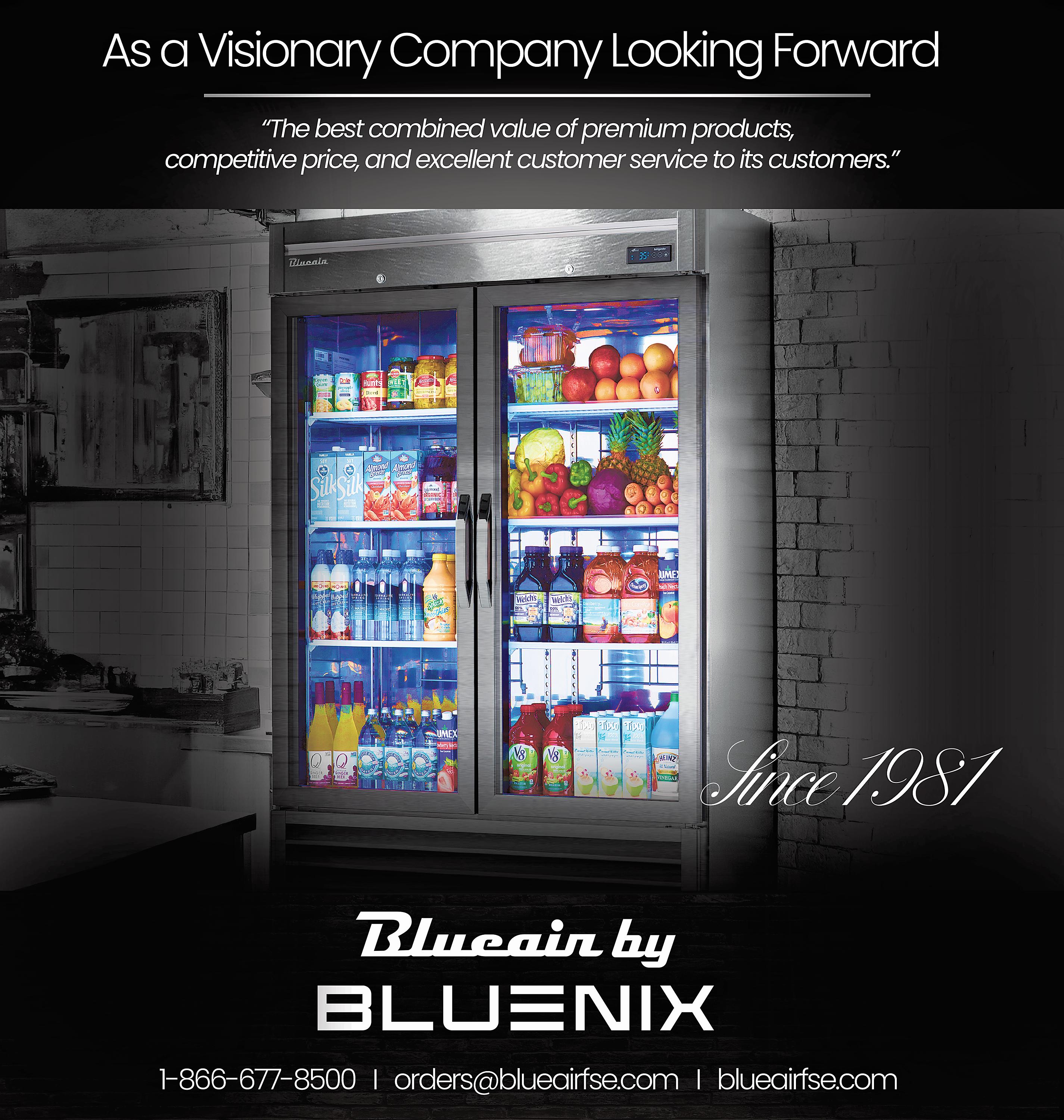
ANew Yorker might move to Maine for its serene landscapes, lower cost of living, and slower pace of life, offering a welcome escape from the city’s hustle. Maine’s coastal beauty and tight-knit communities appeal to those seeking a balanced lifestyle. If you’re also a great chef, your culinary talents could also make a significant impact on you new home. Maine’s thriving local food scene, with access to fresh seafood and organic produce, would allow you to create unique, locally inspired dishes. As a chef, you could become part of a growing legion of culinary stars that have elevated Maine’s culinary reputation by attracting foodies and fostering community connections through innovative dining experiences.
In Portland, Maine, a new culinary
“Their French Cider Vinegar is a staple in my kitchen, and I’ve used their leek powder for everything from pork tenderloin crusts to gnocchi flavoring.” — Chef Bobby Will
star is on the rise, and his name is Chef Bobby Will. At Thistle & Grouse, a gastropub located in the heart of Portland’s Old Port district, Chef Bobby has fused his innovative culinary techniques with the rich, local bounty of Maine, creating a dining experience that is both refined and approachable. With a commitment to sustainability, local sourcing, and culinary excellence, Chef Bobby’s work at Thistle & Grouse has quickly gained the attention of both food enthusiasts and industry insiders alike.
Having opened its doors in Decem -

ber 2023, Thistle & Grouse offers a seasonal, farm-to-table menu featuring creative takes on classic dishes. The restaurant’s success is a testament to Chef Bobby’s vision and his ability to turn culinary passion into a thriving business. But according to Chef Bobby, it’s not just his creativity in the kitchen that has driven Thistle & Grouse’s rise—it’s the partnerships he has forged along the way, particularly with food distributor Chefs Warehouse.
Chef Bobby’s journey into the culinary world began early. “I remember

being in Home Ec class in sixth grade, and my teacher told me I had a natural hand for cooking,” he shared. From there, he pursued his passion at a vocational high school, where his football coach, also the head of the culinary department, took him under his wing. “That’s when I knew I wanted to make a career out of cooking,” Chef Bobby recalled. His path led him to the prestigious Culinary Institute of America, where he honed his craft before working under renowned chefs like Jean-Georges Vongerichten and Andy Husbands.
At Thistle & Grouse, Chef Bobby has brought all of these influences together, blending modern techniques with time-honored traditions. His signature dish, a Gulf of Maine Hake Bolognese, exemplifies this approach. “It came about because we had 40 pounds of hake that needed to be used up, and I decided to make a seafood pasta using the fish in the same style as sweet Italian sausage,” Chef Bobby explained. “I wanted to push the boundaries of what people think of when they hear ‘seafood pasta,’ and the result has been a hit.”
For Chef Bobby, consistency and quality are at the heart of his success, and partnering with Chefs Warehouse has been a key part of maintaining that standard. “From the moment I met the Chefs Warehouse team, I knew we were aligned,” he said. “They understood the importance of having
continued on page 104


Do you have the SCOOP on any foodservice and hospitality news? Send items to SCOOP Editor Joyce Appelman at tfs@totalfood.com
SCOOP has learned that Ellenoff Grossman & Schole LLP has announced the addition of Susie Cirilli as Partner in their Labor and Employment Practice Group.
SCOOP heard that Hanna Lee Communications has launched New York Bartender Week November 18-24, 2024. If you are interested in participating in the weeklong festival, visit their agency’s website and sign up: https://www.hannaleecommunications.com/
the world’s top restaurants, providing up-and-coming talent with invaluable training. Since their 2014 launch, they have awarded over $2 million in stage experiences to young chefs around the United States and worldwide. Application Criteria:
* Must have a minimum of three (3) years but no more than seven (7) years working experience in a full service restaurant
* Must be a US citizen or have valid working papers for the US

Ms. Cirilli represents employers and executives in every aspect of employment law, including issues relating to discrimination, hostile work environment, retaliation and compensation. Ms. Cirilli counsels companies on best practices, drafts policies and defends litigation stemming from Title VII, FMLA, ADA, ADEA, and other state and local laws. She also represents executives in their transitions to and from companies.
Her practice regularly involves matters in the sports world, with a specific focus on women’s sports. Ms. Cirilli is a trusted advisor to companies, agents, coaches and clubs. She counsels clubs on all employment issues, including wage and hour and discrimination avoidance. She also represents executives, including coaches, with employment related issues as they arise. Lastly, Ms. Cirilli writes extensively on important topics in the women’s sport world to educate players, coaches, clubs and leagues. Ms. Cirilli is admitted in the District of New Jersey, the Eastern District of Pennsylvania, the Middle District of Pennsylvania, the Southern District of New York, the Eastern District of New York and the District of Vermont.
* Must be currently employed for at least one (1) year at your current restaurant
* Must have permission from your current employer to apply
To apply, go to this link: https://www.mentorbkb. org/2024grantapplications/
You will also need to include your personally written essays, recommendation letters, resume and headshot. Applications will close on November 10, 2024.

SCOOP learned that IRINOX Professional North America has appointed Mark Ortiz as National Sales Director. Ortiz brings 25 years of expertise in the commercial food service industry to this role. Prior to joining Irinox, he served as Vice President and Head of National Sales at Electrolux Professional Group, where he spearheaded sales and business development initiatives, driving the company’s expansion in the North American market. Ortiz will be instrumental in enhancing brand awareness, fostering business growth, and increasing market share for Irinox. He will oversee and direct sales activities in alignment with the company’s strategic objectives.
SCOOP learned that applications are now open for the 2024 Ment’or Grant Program. The Grant Program provides young culinary professionals with unique opportunities to expand their training and skills by connecting them with established mentors from some of
SCOOP has learned that EatOkra, the award-winning and critically-acclaimed app amplifying Black cuisine from consumer good makers to restaurateurs nationwide, will present the inaugural “Culinary Creatives Conference” on Sunday, October 13, 2024, from 9 am6 pm at the Metropolitan Pavilion, 125 W 18th St, New York, NY 10011. ”Over the past four years, we’ve collaborated with our partners to provide grants, enhance access to capital, and supply vital resources that fortify these businesses. The “Culinary Creatives Conference” (3C) synthesizes these efforts, bringing a tangible, realworld dimension to our digital endeavors and creating a comprehensive platform for growth and innovation,” says Janique Edwards, EatOkra Co-Founder & COO. The one-day conference will be hosted by James Beard Foundation 2024 award recipient KJ Kearney of Black Food Fridays and a panel discussion led by award-winning and celebrated chef and restaurateur Melba Wilson. PEPSI® Dig In is the Conference Partner presenting
continued on page 98

multiple on-site activations featuring local restaurateurs and a dedicated VIP Lounge. Pepsi Dig In has been a long-time partner of EatOkra in a shared mission to support underserved restaurants within Black communities. Tickets on sale now at: https://culinarycreativesconference.com/
SCOOP discovered that ConverseNow, the leading provider of voice AI technology for restaurants, announced a new partnership with Adora POS, a leading point-of-sale system for single point and multi-point restaurants. Through this partnership, Adora POS customers now have access to ConverseNow’s market-leading voice AI solutions, designed to streamline phone ordering processes and drive consistent upsell strategies. ConverseNow’s cutting-edge voice AI technology allows restaurant guests to place orders and have their queries answered using natural human speech, making the ordering process more efficient and customerfriendly. This integration caters to customers who prefer voice interactions over online orders, providing them with a seamless and intuitive experience while allowing restaurant employees to focus on delivering excellent instore customer service, improving overall efficiency and satisfaction. For more information about ConverseNow and its voice AI technology, visit www.conversenow.ai.
SCOOP heard that the Baltimore Ravens announced an exciting new partnership with Baltimore-based Atlas Restaurant Group, for the 2024 NFL season. This dynamic collaboration between two companies with deep-rooted ties to Baltimore aims to further enhance the Ravens’ fan experience throughout the season. This partnership is set to bring a new level of engagement and benefits to Ravens fans, offering unparalleled opportunities to interact with the team and fanbase while also gaining access to exclusive rewards and offers. With this partnership, Atlas Restaurant Group will
offer fan promotions and giveaways via the free Atlas Rewards app. Fans will have the chance to win Ravens tickets, enjoy special offers on food and beverages at Atlas restaurants, and access unique promotions designed to elevate the gameday experience. Atlas Restaurant Group is also proud to be an official sponsor of Baltimore Ravens Purple Fridays. To kick off the season, Atlas will host a spectacular kickoff party at Watershed, featuring the Ravens Caravan, mascot Poe and Baltimore’s Marching Ravens. This event promises to be a vibrant celebration of Ravens spirit and community camaraderie.
SCOOP has learned that Bigelow Tea, the 100% woman owned and operated family tea company founded in 1945, recently announced the groundbreaking of its new state-of-the-art facility located at Blankenbaker Road in Louisville, Kentucky. The ceremony, which took place at the site at 2706 Blankenbaker Road on September 9, 2024, marked the commencement of construction on this significant project.
The new 265,000-square-foot building will serve as a key facility for Bigelow Tea’s production, packaging, storage, and distribution operations. The site also includes 25,000 square feet of planned office space, and it sits on a sprawling 20-acre plot, allowing for a future expansion of 75,000 square feet as the company continues to grow.
Cindi Bigelow, the company’s CEO and President, is excited to see the building come to fruition. “There are so many people that have worked tirelessly to bring this project to life. I especially want to call out John Bruins, Senior Director of Engineering, for his commitment to
talking to almost every employee over the last two years to ensure that this facility was built to include everyone’s needs.”
Hollenbach Oakley has been awarded the Project Management agreement for the construction of this new facility, and Horizon Commercial Realty played a pivotal role in facilitating the purchase of the property, ensuring that Bigelow Tea’s vision for its new facility could be realized.
Greg Oakley, Managing Partner of Hollenbach Oakley and Horizon Commercial Realty, expressed his enthusiasm for the collaboration. “Working with Bigelow Tea on this project is a tremendous honor. This facility will not only enhance their operational capabilities but also demonstrate their commitment to the Louisville community and sustainable practices,” Oakley said.
Sitework is scheduled to begin this year, with the main construction phase slated to start in early 2025. Civil drawings have already been completed, and the facility will include environmentally friendly features such as solar canopies over employee parking lots, underscoring Bigelow Tea’s commitment to sustainability.
With the start of this project, Bigelow Tea’s plan includes expanding their workforce, further contributing to the local economy. The total investment for this project is estimated at over $70 million.
Bigelow Tea’s current Louisville facility is located at 2401 Constant Comment Place, for over 30 years and is very happy to be able to expand in the same wonderful community. The new facility marks a significant milestone in the company’s continued growth and commitment to excellence.
About Bigelow Tea Company: Based in Fairfield, CT and 100% family and woman-owned, the Bigelow Tea Company pioneered the specialty tea category nearly 80 years ago. The third-generation company takes pride continued on page 100


in its heritage and successful growth from a one-product, entrepreneurial venture into America’s #1 leading tea company brand producing over 2 billion tea bags annually in the company’s three manufacturing facilities in the US. The Bigelow Tea line includes more than 150 varieties of Flavored, Traditional, Green, Herbal, Decaffeinated, steep by Bigelow Organic, Bigelow Benefits Wellness teas and Bigelow Botanicals Cold Water Infusion – including its flagship specialty tea flavor, “Constant Comment”®, an all-time American favorite. Bigelow Tea products are available nationwide and internationally as well as on www.BigelowTea.com
Staypineapple, the Pacific Northwest-based hospitality group with 10 hotels, four restaurants and three cafés nationwide, announced the promotion of David Fingerman from Executive Chef at Atwood Restaurant, a premier dining establishment located in Staypineapple Chicago, to Corporate Executive Chef for the Staypineapple Hotels brand. In this new role, Fingerman will oversee culinary operations across all Staypineapple hotels and food and beverage outlets, bringing his innovative approach and passion for exceptional dining experiences to a broader audience.
Fingerman, an award-nominated chef with over a decade of experience in executive-level culinary roles, started from humble beginnings as a baker’s assistant at the age of 15. After a number of culinary positions throughout his earlier career, Fingerman first joined the Atwood team in 2013, then pursued an opportunity to work and learn under famed celebrity chef Graham Elliot as Sous Chef at the acclaimed casual fine dining concept, Graham Elliot Bistro, in Chicago’s West Loop neighborhood. Fingerman was quickly promoted to Executive Chef under Graham Elliot’s leadership, where he spent two years leading the bistro’s culinary direction before taking an opportunity as Executive Chef at Madrina in Dallas, Texas. Fingerman returned to Atwood in 2017 as Executive Chef, and in 2021 he was tasked with leading both Atwood’s front and back of house teams, overseeing all culinary, service and beverage operations for the restaurant.
Adirondack Winery announced the appointment of Courtney Rankin as the organization’s inaugural female
winemaker. With over six years of experience in winemaking, she will be overseeing the production of over 35 wines, six hard ciders and lead the development of new wine and hard cider releases for the company.
Courtney’s career started by getting involved in the craft beer industry. After studying craft beer brewing at Schenectady County Community College, she then found Galway Rock Winery in Ballston Lake, NY, where she apprenticed as the assistant winemaker for the owner and winemaker, Kate Soldani, learning the world of winemaking by, again, getting hands-on experience. At Adirondack Winery, Ms. Rankin’s responsibility for wine and cider production will more than triple. Adirondack Winery’s wine production reaches 20,000 cases annually, while its Extreme Heights Cidery brand is fledgling. The Queensbury wine making facility has capacity to grow to a 50,000 case annual production volume.
- Chef Melissa Rodriguez, head of the two-Michelinstarred Al Coro which shuttered late last year, will cook in the same kitchen at Crane Club, a new restaurant by Tao Group. Crane Club will serve a menu shaped by open-fire cooking of grilled vegetables, meats, and seafood, with a 1000-bottle wine list.
- Locanda Verde is opening a second location. The new spot from chef partner Andrew Carmellini, Luke Ostrom, and Josh Pickard, in partnership with actor Robert De Niro, will debut in Hudson Yards, 15 years after the original location. The two-level, 6,000-squarefoot space features two bars and an outdoor terrace with views across the Hudson River. It’s designed by Roman and Williams. with neutrals, woods, and mid-century accents to lend warmth.
- Los Angeles import Sushi by Scratch has opened, a sushi speakeasy with a $225 omakase from Chef Phillip Frankland Lee and his wife and pastry chef, Margarita Kallas-Lee. It’s one of a handful across the country.
- H&H Bagels, the iconic New York bagel brand, announced their first-of-its-kind Lox Flight, created in collaboration with Brooklyn’s fourth-generation, familyowned smoked fish purveyor Acme Smoked Fish. These two born and bred NYC brands are elevating the traditional “bagels and lox” experience with the Lox Flight: your choice of a freshly-baked H&H bagel cream cheese, and four flavors of Acme’s smoked fish, including two brand new flavors debuting with H&H, all packaged in a custom designed bento-style box.
- The Corner Store, the new classic American restaurant from the team behind Catch Hospitality Group: Tilman Fertitta, Mark Birnbaum, and Eugene Remm, opens in SoHo. The Corner Store’s food menu features playful takes on American classics from Catch Hospital-
ity Group’s Culinary Director Michael Vignola and Executive Chef Paul Castro, formerly of Catch New York and Nobu. The innovative and highly technical beverage menu, curated by Lucas Robinson, Catch Hospitality Group’s Beverage Director, and Alexis Belton, previously of The Alinea Group’s The Aviary and Dev Johnson, previously of Employees Only centers around a premium martini program. The warm space, designed by Rockwell Group, has a nostalgic feel, inspired by old-school New York dining, and boasts a 13-seat bar, ample booth and banquette seating with wood details, and an enclosed patio with lush greenery.
- Chef Michael White has teamed up with one of the biggest developers in Manhattan to open Santi, his high-end Italian Midtown restaurant. The property is the former location of Alto, an early White restaurant that earned him a New York Times three-star review. The developer behind the revival of Rockefeller Center, now home to restaurants like Jupiter, Le Rock, Lodi, and Naro, Tishman Speyer owns the space.
- Kellogg’s Diner, Williamsburg’s beloved landmark destination from restaurateur Louis Skibar and restaurant designer Nico Arze, re-opened its doors with Chef Jackie Carnesi, formerly the Executive Chef of Nura, featuring a variety of classic diner favorites alongside a handful of dishes inspired by Jackie’s home state of Texas. Nico and Matthew Maddy, the notable New Yorkbased designer duo known for Lllia, Celestine, and Public Records, among others, have re-invented the 75-seat diner aesthetic to incorporate modern design elements, lending the space to a new generation of diners.
- Chef Jackie Carnesi, who previously worked under chef Alex Stupak at Empellon Cocina, then on menu development at Roberta’s for six years, before opening Nura as the Executive Chef where she was named a StarChef Rising Star in 2023, among other accolades. Alongside Jackie is a team of talented chefs including Pastry Chef Amanda Perdomo, previously of Contra and Wildair. The beverage program is developed by awardwinning Bar Director Chris Amirault, who has garnered accolades for his work with places like the Maybourne Beverly Hills Hotel, Otium LA, and Nura.
Arlo Hotels announced an exciting partnership with Chef Pepe Moncayo to elevate the culinary experience at Arlo Washington DC. Chef Moncayo will take the helm of the kitchen, promising guests a Spanish-inspired dining journey. Chef Moncayo’s culinary journey has been remarkable leading to the success of Cranes restaurant,
continued on page 102


established in 2020. His commitment to being an artisan earned Cranes the prestigious Michelin Star in 2021, establishing Pepe Moncayo as one of the top chefs in the nation. The restaurant was also honored with the prestigious title of “Formal Fine Dining Restaurant of the Year” by the Restaurant Association of Metropolitan Washington.
Atlanta-based restaurateur Brian Lewis announces the next installation of his beloved concept Bocado to a new Sandy Springs location with a fresh menu focused on small plates and wood-fired pizzas, plus pasta, seafood and steak entrees. Lewis originally conceived of Bocado as an American eatery that served Atlanta’s West Midtown for 12 years, in addition to sister concepts Bocado Burger at Avalon in Alpharetta, Georgia, and Bocado Bar + Diner in Charlotte, North Carolina. This chapter will emphasize the Bocado ethos of showcasing simple, good ingredients.
Michelin recognized 28 Denver restaurants in the second year of its Michelin Guide Colorado. In addition to a host of returning awarded restaurants, Michelin awarded Alma Fonda Fina one star and MAKfam a Bib Gourmand, and named both Kawa Ni and Brasserie Brixton as newly recommended restaurants.
Sushi By Bou, the nationally acclaimed omakase restaurant concept by NYC-based hospitality group simplevenue, has partnered with Arlo Wynwood to open its newest location within the boutique lifestyle hotel’s third-floor cocktail lounge Higher Ground. Sushi By Bou is one of simplevenue’s most well-known flagship brands, reimagining the omakase experience across 20+ nationwide locations. The transformative hospitality group, founded by Michael Sinensky and Erika London, brings distinctive micro-restaurant concepts to underused spaces found within existing venues. Its latest hot spot is an intimate 650-square-foot space in the heart of Wynwood’s cultural arts district. Upon entering the dark, newly renovated speakeasy setting, guests will discover an ode to ‘90s hip-hop with abstract graffiti and portraits of musical OGs like The Notorious B.I.G., while dim lighting, luxurious velvet, black screen dividers and crimson curtains further enhance the atmosphere’s exclusive aura. The 14-seat omakase counter, eight-seat bar and cozy 14-seat lounge area are the ideal spots to enjoy craft cocktails and Sushi By Bou’s signature timed omakase experience.
- Miami’s Kimpton EPIC Hotel Area 31 restaurant shared three new appointments within their team in-
cluding Yoren De Beul brings over 14 years of hospitality experience to his new role as Food & Beverage Supervisor. With previous hospitality experience from renowned hotels such as Sheraton Amsterdam, Hilton Paris Opera, and Sofitel Paris Arc De Triomphe. With over 20 years of hospitality experience, Robert Centeno joins the team as Assistant Food & Beverage Director. Robert honed his hospitality skills at renowned properties such as the Caribe Royale, JW Marriott – Ritz Carlton Grand Lakes, and Signia Hilton Bonnet Creek – Waldorf Astoria Orlando. Luis Bergery joins as Lead Bartender, bringing nine years of diverse hospitality experience to the role.
Apicii, the acclaimed national hospitality group behind a diverse portfolio of restaurants, bars and private event spaces nationwide, is introducing its cantina concept Masa & Agave to Cleveland. Now officially open to the public, the cantina features authentically inspired Mexican cuisine and Cleveland’s largest collection of agave spirits, which showcases Mexico’s distillers and agave distilling regions. The lively 2,800-square-foot space, features contemporary interpretations of Mexican motifs and a hip, upbeat atmosphere. The focal point of the 80-seat dining room and bar is a wall of tequila lockers house the collection of agave spirits. Handblown Mexican glass chandeliers and playful wallpaper enhance the stylish, artsy ambiance.
The cantina features three original murals by nomadic artist Aaron Petz: Day of the Dead in the dining room, celebrating the land of the dead with joy, remembrance, and love, bridging the realms of the living and the dead; Las Flores in the foyer, depicting flowers guiding souls to the afterlife, transforming the viewer’s experience into a surrealistic journey; and Mayahuel on the building’s exterior, a dramatic 35’ x 38’ acrylic mural depicting Princess Mayahuel, the Aztec goddess of agave, drawing the “elixir of life” from the heavens. This mural also comes to life through an exclusive Masa & Agave Instagram filter, allowing guests to interact with its magical story through their cell phone cameras.
-InterContinental Cleveland shared two new appointments within their culinary team – Cluster Executive Chef Omar Jones and Executive Pastry Chef Thomas Francescangeli.
Cluster Executive Chef Omar Jones is a culinary professional with more than 30 years of experience in the hospitality industry. A native of the Cleveland area, Chef Jones’ passion for cooking was kindled in his family’s kitchen, learning the art from his grandmother and mother. His professional journey began with his first job at Sandy’s, a local ice cream parlor. After graduating with an Associate Degree in Culinary Arts from Pennsylvania Institute of Culinary Arts, Chef Jones started as a Butch-
er at the InterContinental Hotel Cleveland in 2003. His dedication and skill in his craft quickly earned him recognition and advancement within the hotel.
As the current Cluster Executive Chef, Chef Jones oversees the hotel’s sprawling 35,000 square feet of meeting and event space and the on-site restaurants, Table 45 and North Coast Café, as well as C2 Restaurant Bar & Lounge located within the InterContinental Suites. Chef Omar is deeply committed to meeting guest needs, delivering quality food, and building a strong and efficient team by coaching his staff. Chef Jones’ philosophy in the kitchen is simple yet thorough: focus on flavor, balance, and always taste your creations. He has earned the prestigious title of “Ohio Manager of the Year” in 2021 from the Ohio Hotel & Lodging Association (OHLA).
Executive Pastry Chef Thomas Francescangeli is a culinary professional with 15 years of diverse experience in the hospitality industry. Born and raised on Cleveland’s west side, Chef Tom ventured to Chicago where he earned a Bachelor of Architecture from the Illinois Institute of Technology. Having studied French in school, he decided to study abroad in Paris where his perception of food was heavily influenced by the Parisian culture, and he discovered a passion for designing desserts in addition to buildings.
In 2010, Chef Tom followed that culinary passion to the InterContinental Cleveland where he joined the team as a Pastry Cook. From there, he briefly moved to South Korea to teach English for the next three years, and moved back home to continue his career in pastry. His diverse professional background, including experiences in architecture studios, kitchens, and classrooms, has significantly impacted his work ethic and philosophy as the current Executive Pastry Chef at InterContinental Cleveland Hotel.
The Texas Inn, one of Virginia’s oldest continually operated restaurants, was honored by the Virginia Restaurant Lodging & Travel Association (VRLTA) with a lifetime membership for its status as a “Legacy Restaurant.” The legendary diner, “T Room” to long-time customers, was recognized along with five other venerable dining establishments at VRLTA’s annual meeting in Richmond. Other recipients of the lifetime membership include Joe’s Inn (Richmond), Black Angus (Virginia Beach), Pierce’s BBQ (Williamsburg), L’Auberge Chez Francois (Great Falls) and Red Fox Inn & Tavern (Middleburg). The restaurant originally named Texas Tavern was founded in 1935 and is known for its famous Cheesy Western burger. The company has one location in Harrisonburg, VA, two in Lynchburg, VA, and recently opened a Richmond location in May of this year.
continued on page 104
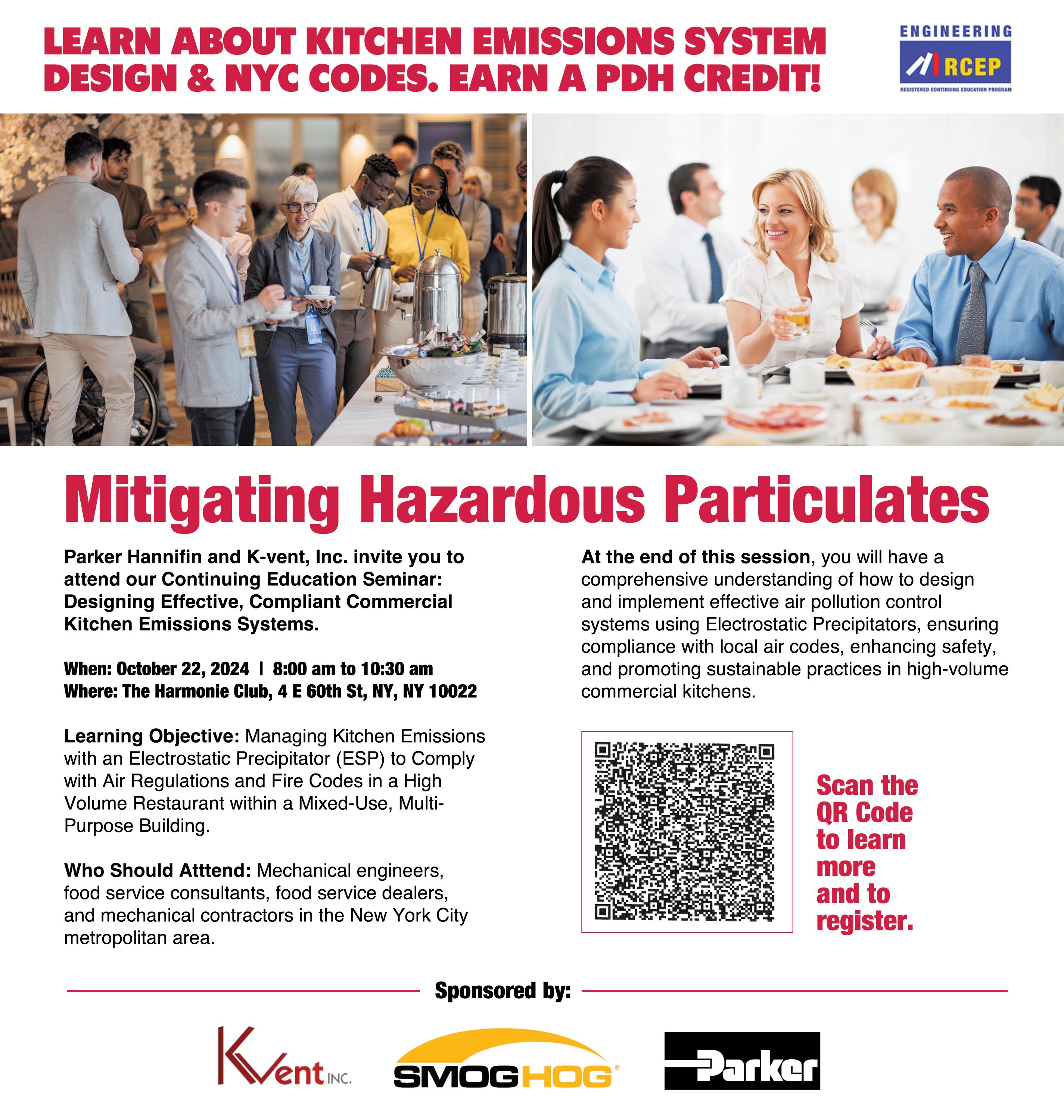
SCOOP learned that Inline Plastics has just unveiled two exciting additions to their Safe-T-Fresh® Rounds line that promise to be the talk of every party. These ingenious platters are set to redefine how we savor, serve, and store our favorite party bites.
The real magic lies in the details. Inline Plastics has packed these platters with smart features that make them a must-have. The tamper protection technology ensures these delectable dishes travel from store to table with confidence, while the leak resistant seal and clever anti-migration lid keeps flavors in their place. And the rigid stacking rails are a game-changer, maximizing shelf space and stability.
Imagine a world where carefully prepared snacks stay as fresh and appetizing as the moment they were made. That’s the reality Inline Plastics is bringing with their new 54 oz platter (SKU TSPL054C5) and 104 oz platter (SKU TSPL104C5). These aren’t just any platters – they’re culinary canvases designed to showcase and secure contents, keeping appetizing spreads party-perfect.
Picture this: four spacious compartments surrounding a central dip holder, giving freedom to create a feast for both the eyes and the palate. Retailers, get ready to
CHEF BOBBY WILL
from page 94
the best ingredients, and their dedication to quality has allowed me to create a menu that is not only exciting but also consistent.”
The partnership has been vital in sourcing the high-quality ingredients that have made Thistle & Grouse’s dishes stand out. Whether it’s seafood, charcuterie, or specialty pantry items, Chef Bobby relies on Chefs Warehouse to provide him with the products that match his exacting standards. “I’m always looking for unique flavors and ingredients, and the variety I get from Chefs Warehouse is unbeatable,” Chef Bobby noted. “Their French Cider Vinegar is a staple in my kitchen, and I’ve used their leek powder for everything from pork tenderloin crusts to gnocchi flavoring.”
This attention to detail extends be -
revolutionize your display game. These platters are space-saving, sales-boosting superstars that will have your consumers coming back for more. Ready to take your culinary creations to the next level? Discover the magic of Safe-TFresh® Platters.
Inline Plastics, headquartered in Shelton, CT, is the leading manufacturer of innovative, high-quality, crystal-clear food packaging with over 55 years of experience. The company transformed the marketplace with their Safe-T-Fresh® line, a tamper-resistant and tamper-evident product which utilizes their patented technology, providing retailers and consumers with greater product protection. They continue to design and manufacture packaging solutions that keep food products safe, fresh, and enhance shelf merchandising. The company also offers the most complete line of automated equipment to close, lock, and label their packaging. For more information on their vast line of award-winning products, visit inlineplastics.com
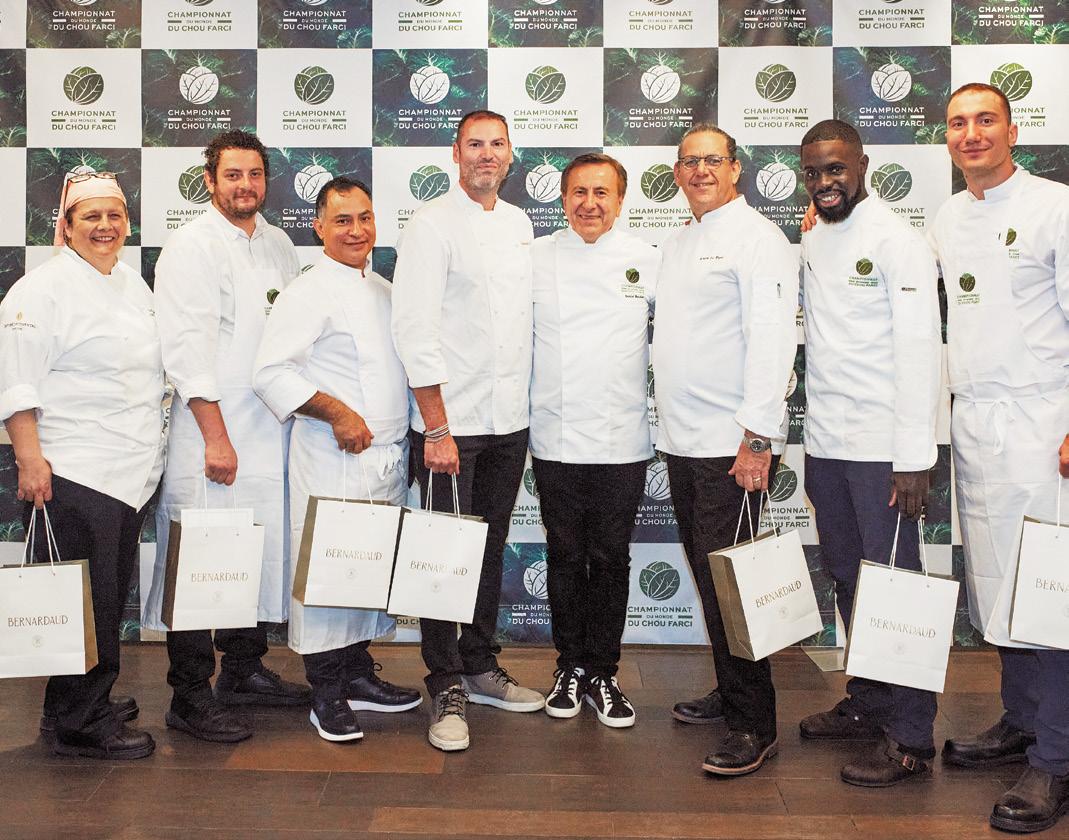
for the Stuffed Cabbage World Championship, organized by the Stuffed Cabbage Association, took place on September 18, 2024, in New York at the Institute of Culinary Education, bringing together seven chefs from the United States and Canada.
SCOOP learned that the final of the Americas selection
yond the ingredients themselves to the overall dining experience at Thistle & Grouse. Chef Bobby and his team are committed to creating an atmosphere that is welcoming, relaxed, and reflective of Portland’s vibrant food scene. The warm, inviting space, complete with reclaimed wood accents and cozy leather booths, provides the perfect backdrop for enjoying a meal crafted with care.
In addition to partnering with Chefs Warehouse, Chef Bobby is deeply committed to sourcing ingredients from local farms and fisheries. “Maine has such an incredible variety of fresh, sustainable products, and I wanted Thistle & Grouse to highlight that,” he explained. The restaurant sources everything from Wagyu beef to seafood from local providers like Tide Mill
For over three hours, the finalists showcased their culinary skills, passionately presenting their stuffed cabbage recipes, an iconic dish in French and global gastronomy. At the end of the day, the jury, led by its president Chef Daniel Boulud, named Guillaume Ginther, winner of the Americas selection. He has thus qualified for the final of the first Stuffed Cabbage World Championship, which will take place on November 18, 2024, in Limoges, France, a city reknown for its porcelain including event host Bernardaud.
Organic Farm and Maine Grains, ensuring that every dish reflects the best that the state has to offer.
This commitment to sustainability is evident in every aspect of Thistle & Grouse’s menu. “Growing up by the water, I’ve always had a deep respect for the ocean and the importance of preserving its bounty,” Chef Bobby said. “That’s why sustainability is a core value here—we want to honor the ingredients and the people who provide them.”
As Thistle & Grouse continues to grow, Chef Bobby remains focused on pushing the boundaries of what a gastropub can be. “We’re constantly evolving the menu to reflect the seasons and to keep things exciting for our guests,” he shared. From the creative seafood dishes to the curated
selection of craft beers and cocktails, there’s always something new to discover at Thistle & Grouse.
Looking ahead, Chef Bobby plans to expand his work with local food producers and continue innovating in the kitchen. “There’s so much potential here in Portland, and I want to keep building on that,” he said. “Thistle & Grouse is just the beginning—I’m excited to see where we can take this.”
With Chef Bobby at the helm, Thistle & Grouse is well on its way to becoming a cornerstone of Portland’s culinary landscape, offering a dining experience that is both innovative and deeply rooted in the local community. His success is a testament to his passion, creativity, and the partnerships he has built, both in the kitchen and beyond.

ogy and training.
The brand’s positioning stems even further beyond being a cooked-to-order business; it’s also a business that cares for its business partners, its franchisees, and its employees. The leaders at Freddy’s recognize the importance of maintaining these relationships, even after substantial coast-to-coast growth. This has surely helped the company grow at the corporate level and also keep its franchisees thriving. Additionally, it’s led to thousands of customers and community members who are being positively impacted by the “Freddy’s Way.” For example, Freddy’s supports a variety of national programs, including Folds of Honor and the Kids in Need Foundation, and its franchisees support many local charities as well.
As they continue to hone into their core values and mission, Wise noted that they’re also growing in various ways

to excite a new generation of Freddy’s fans. The company has a product development team and a corporate chief who listen to customer wants and needs to bring new products to market. One of their most recent menu additions is the “Frost” frozen custard line, which puts a spin on the brand’s well-known frozen
tion is shaped. At the event, the 20242025 Board of Directors and the Industry Advisory Board were officially unveiled. Shayne Varnum, Director of Consultant Services & Government Sales at ITW Food Equipment Group, was named SHFM’s new president. Varnum, who has been a part of the hospitality industry for over two decades, brings with him a wealth of experience and a deep commitment to innovation and collaboration. In his new role, Varnum emphasized the importance of mentoring young professionals and fostering growth across all levels of the industry.
Other board members include Jenna Calhoun, who was named PresidentElect, and Rob Yayac, serving as Treasurer. The election of new directors and senior suppliers, such as Eric Cooley from PepsiCo, marks a significant milestone for SHFM as the organization continues its mission to empower its members and champion workplace hospitality.
In addition to board elections, the conference honored the industry’s most distinguished professionals with the SHFM Awards. The prestigious Robert Pacifico Award, given for outstanding service, was a highlight of the awards
from page 84
ceremony. The recognition of these industry leaders underscored the essential role they play in shaping workplace hospitality.
A standout feature of this year’s conference was the announcement of the 2024-2025 SHFM Rising Stars. These young professionals, all under the age of 39, were recognized for their outstanding contributions and potential to lead the future of hospitality. SHFM places a strong emphasis on nurturing young talent, and the Rising Stars program provides these individuals with resources, mentorship, and networking opportunities that will help shape their careers.
This year’s Rising Stars included CC Andrews from Aramark, Harpreet Cheema from Sodexo, and Natalia Lopresti from Jane Street. These professionals have not only demonstrated exceptional skill and leadership but are also driving innovation in workplace hospitality. “It’s incredible to see the next generation stepping up with fresh ideas and energy,” said Lopresti, who was named the Chair of the Rising Stars program.
Additionally, the Julie Flik Rising Star Continuation Program recognized
custard by utilizing flavors like lemonade and creamsicle. Similarly, they’re planning to add a line of tater tots to the menu to complement Freddy’s famous steakburgers.
Both additions bring a fun and unique twist on traditional Freddy’s food, highlighting the company’s desire to in-
novate while staying true to their core menu. This strategy is what sets Freddy’s apart in the world of chain restaurants, and it’s what keeps people returning to experience the “Freddy’s Way.” Freddy’s remarkable expansion from a single Wichita outlet in 2002 to over 400 locations today underscores its impressive ascent within the fast-casual dining sector. Even amidst rapid growth and the allure of new markets, Freddy’s has maintained its original commitment to quality and customer service, characteristics that have become synonymous with the brand. This steadfast focus not only enhances customer loyalty but also presents a promising prospect for potential franchisees. As Freddy’s continues to identify key regions for expansion, the essence of that first restaurant in Kansas remains the cornerstone of their enduring success, proving that growth and values can indeed coexist harmoniously.
those who have aged out of the Rising Stars program but continue to make significant contributions to SHFM and the industry. The continuation program ensures that talented individuals remain engaged with SHFM, offering them additional leadership and development opportunities.
Beyond keynotes and awards, the SHFM National Conference was filled with engaging breakout sessions, networking opportunities, and special events. One of the most popular events was the culinary showcase, where teams of chefs and foodservice providers demonstrated cutting-edge techniques and innovative approaches to workplace dining. These live demonstrations offered attendees a taste of the future of foodservice and inspired many to rethink their own offerings.
Panel discussions led by industry leaders including Amelia Ekus also provided valuable insights into the challenges and opportunities facing the foodservice industry today. Topics included sustainability, the future of remote work and hospitality, and how to build more inclusive workplaces. Attendees appreciated the interactive format of the panels,
which allowed for robust discussions and idea-sharing.
The conference also took time to celebrate its 45th anniversary, with a special evening event that brought together long-time members and newcomers alike. This celebration not only marked SHFM’s rich history but also set the tone for the organization’s future as a trailblazer in workplace hospitality.
As the SHFM National Conference concluded, there was a palpable sense of excitement for what the future holds. With new leadership, rising talent, and a clear vision for the future, SHFM is poised to continue driving innovation in workplace hospitality. Incoming president Varnum summed up the conference’s energy best: “Together, we’re building a future where hospitality is not just about service, but about creating meaningful human connections.”
With its focus on mentorship, innovation, and collaboration, SHFM is ensuring that the future of workplace hospitality is bright. As the industry continues to evolve, the SHFM National Conference remains a critical forum for shaping its direction and cultivating the next generation of leaders.
the decision to partner with Michael White for this venture was driven by more than just business logic. “Michael’s career is nothing short of remarkable. He spent years living in Italy, immersing himself in the culture and mastering the techniques of Italian cuisine. It was important for us to create a restaurant that reflects his journey, a retrospective of all his experiences, while also pushing the boundaries of modern dining,” he said.
White, who has been a trailblazer in the Italian dining world, spent years honing his craft in Italy before bringing his expertise to New York City. His previous establishments were celebrated for their attention to detail, creativity, and authenticity—qualities that are expected to shine at Santi.
“We’re reimagining the space and the menu, while keeping true to the Italian roots that made Michael’s cuisine so iconic,” Bronster added. “It’s not just about serving great food; it’s about creating an immersive experience where every detail, from the decor to the service, transports diners to Italy.”
The menu at Santi promises to be a culinary journey, with dishes inspired by Chef White’s extensive travels and apprenticeship across Italy. The restaurant will focus on handmade pastas, fresh crudos, and seasonal ingredients sourced from the best suppliers.
The ambiance, Bronster explained, will be intimate yet casual. “We wanted to create a warm, inviting space where people feel comfortable and can enjoy an authentic Italian meal without the need for formalities,” he said. “The lighting will be soft, the staff welcoming, and the aroma of fresh basil will linger in the air. Every element has been designed to evoke the feeling of being in a cozy trattoria in Italy.”
The restaurant is expected to be a major draw in New York’s already competitive dining scene, but Bronster is confident in its ability to stand out. “We know New York is a tough market. There are over 7,000 establishments here, and you have to be
great at everything—food, service, ambiance. But with Santi, we have something special. Michael’s ability to execute simple yet refined dishes, combined with our attention to every detail of the dining experience, sets us apart.”
While Santi represents a significant milestone for BBianco Hospitality, it is by no means the end of their expansion. The company has several other projects in the pipeline, including new ventures in Coral Gables and Dallas. “Our goal is to continue expanding, but in a thoughtful way,” Bronster explained. “We don’t want to grow just for the sake of growth. Each new project has to align with our values and our commitment to delivering exceptional dining experiences.”
The future looks bright for BBianco, as they plan to not only open more restaurants but also to expand their consulting and management services to new markets. “There’s a growing demand for high-quality hospitality management services, especially in this post-pandemic world where many restaurant owners are looking for ways to streamline operations and adapt to changing consumer behaviors. We’re positioned perfectly to meet that demand,” Bronster said.
BBianco Hospitality’s success is built on a foundation of passion, expertise, and a deep understanding of the restaurant industry’s challenges.
With Santi set to open in the fall of 2024, the company is well on its way to becoming a dominant force in highend dining. For Bronster, the journey is far from over. “We’re excited about the future,” he said. “Our goal is to continue pushing boundaries, delivering exceptional dining experiences, and helping restaurateurs succeed in an increasingly competitive market. With Santi, we’re taking a big step in that direction, and we can’t wait for what’s next.”
As BBianco continues to expand, one thing is clear: their focus on quality, innovation, and passion for the culinary arts will keep them at the forefront of the hospitality industry for years to come.

takes them back to the meals they grew up with: home-cooked, full of flavor, made with love. Sure, like most Indian restaurants, we offer classics like samosas and pakoras, but we go beyond that. For instance, we feature unique dishes, like Lamb Shoulder with Corn from Karauli, Rajasthan, and Banarasi Kachori, deep fried puff pastry stuffed with flavored lentils. We make sure that our servers and I guide guests who are unfamiliar. We ask, are you in the mood for—vegan, veggie, shrimp, spicy? People ask, what is popular - and I always say, I can’t tell you that, but I can tell you what my favorites are. Unquestionably the most popular dish in an Indian restaurant is Chicken Tikka Masala. It originated in the UK, not India, but it’s everyone’s comfort food, so we serve
from page 2
To meet these demands, Restaura has built its model around three core pillars: freshness, technology, and a commitment to individualized service. First and foremost, freshness is at the heart of Restaura’s offerings. The company is committed to providing scratch-made meals using local and seasonal ingredients whenever possible. “We’re bringing a restaurant-quality experience to senior living,” Schenkel said. “From farm-totable offerings to globally inspired dishes, we’re pushing boundaries on what’s possible in senior dining.”
Beyond food quality, Restaura is investing heavily in technology to enhance the dining experience. Cuticelli explained, “Technology is a game changer in this space. We’ve developed systems that allow residents to give real-time feedback on their meals. It’s not enough to ask once a year how the food is—we want immediate insights so we can continuously improve.”
These technological innovations don’t stop at meal feedback. Restaura is also leveraging predictive analytics to track preferences and dietary trends across its senior communities. This allows them to offer personalized meal plans that cater to both individual preferences and health requirements, a significant improvement over the one-size-fits-all
that, too!
What motivated you to expand Benares to Wyckoff, New Jersey?
When we closed our 56th Street location in Manhattan, we still had TriBeCa, so we asked ourselves, why not a place in New Jersey? We saw this site, which was struggling. We loved the shopping center and available parking. We opened in 2019, then COVID hit—and with the tremendous support of the community—we somehow managed to thrive, and haven’t looked back. Like many other venues at the time, once we could reopen our doors and start cooking again, we offered generous discounts and donated foods to first responders, hospitals, and the Franklin Lakes and Wyckoff police departments.
What are the three most popular vegetarian dishes at Benares?
Our most popular vegan and vegetarian dishes include Diwani Handi (“Crazy Pot”): spinach, cheese and all the veggies you can think of. To make it vegan, we remove the cheese. Everybody loves it. Then there’s Baingan Mirch Ka Salan (baby eggplant with tamarind and a peanut & coconut sauce), and Dal Makhani, black lentils slow cooked overnight and finished with butter.
Looking ahead, where do you see Benares in five years?
Great question. We would definitely like to expand. Readers may not realize how important the catering side of the business is, both financially and
culturally. Indian weddings are frequently multi-day affairs with guest lists anywhere from 200-400; often more. Financially, catering is probably 75% of the business. We have a massive kitchen/commissary in Astoria, Queens and handle at least 200 catering gigs per year, including weddings, anniversaries and birthdays. Additionally, we own one catering business on Long Island with an 800-person capacity. So yes, here in NJ, we’d like to open either another catering facility or restaurant, or form a business partnership with an existing catering facility.
Discover more about Benares and its mouthwatering menu by visiting their website: https://www.benaresnj.com/

approach many communities still use. “Our goal is to make the dining experience as seamless and enjoyable as possible,” Cuticelli noted. “Seniors should feel like they are dining at their favorite restaurant every day, with options that meet their specific needs.”
The modern senior is more concerned with health and wellness than previous generations. Many are focused on longevity, disease prevention, and managing chronic conditions like diabetes and heart disease. Schenkel and Cuticelli are keenly aware of this, which is why Restaura places a strong emphasis on health-conscious meal options. The company plans to offer menus that align with specific health goals, such as heart-healthy diets, low-sodium options, and meals designed for diabetic management.
“Food is a critical component of health,” Schenkel remarked. “We’re working with nutritionists and chefs to create meals that don’t just taste good but actively contribute to our residents’ well-being.” Cuticelli added, “The days of over-processed, nutrient-poor meals are over. We’re focusing on whole, fresh ingredients and tailoring our menus to promote long-term health.”
Restaura also differentiates itself through its people-first approach. Schenkel and Cuticelli are determined to create a company culture where employees feel valued and invested in the success of the business. They believe this will translate into better service for residents.
“We want our employees to take pride in what they’re doing and feel like they’re part of something bigger,” Schenkel said. “That’s why we’ve introduced an employee ownership program. Every team member will have a stake in the company, which we believe will foster a deeper commitment to delivering exceptional service.” This unique ownership model is rare in the senior dining sector and is expected to set Restaura apart from its competitors. “When employees feel like they have a real role in the company’s success, it shows in their work,” Cuticelli stated. “We’re creating a culture that values innovation, teamwork, and above all, the well-being of our residents.”
Restaura’s vision extends beyond its initial launch. Schenkel and Cuti-
celli have ambitious plans for growth, aiming to become a national leader in senior dining services. They are currently in discussions with several senior living communities across the country and are poised to expand rapidly over the next few years.
“We see a huge opportunity to scale Restaura nationally,” Schenkel said. “The need for high-quality, health-conscious senior dining services is only going to grow as the baby boomer generation ages.” Cuticelli echoed this sentiment, adding, “We’re just getting started. Our goal is to revolutionize the senior dining experience across the country. This is only the beginning of what we believe will be a transformative journey for senior living.”
As Restaura enters the senior dining market, its innovative approach, focus on quality, and commitment to redefining the dining experience for seniors set it up for long-term success. Seniors, their families, and communities alike can look forward to a fresh, exciting dining alternative. “We have a tremendous advantage as we launch this month. Senior dining is all we do, it is our passion and singular focus,” Cuticelli concluded.

from page 14
hanced with projection mapping, interactive displays, and augmented reality (AR). Instead of showing donors drawings of the new building, they can walk through it with the help of AR or elaborate projections that encompass the walls, ceiling, and floor. Overcome space restraints and allow guests to test drive a car or simulate a golf swing, elevating product demos into a memorable experience.
Regardless of the nature of the event, many guests will feel the pull of social media, and technology enables event planners to create a special social media opportunity. Custom filters, hashtags, and photo opportunities designed with social media in mind can be mutually beneficial for both event organizers and guests, providing clout and likes for both parties.
All of these technological upgrades provide organizations with easy and unique options for customized branding. Instead of clunky signage, much of which is one-time use and not particularly attractive, incorporate company logos in apps, digital displays and projections, or social media filters.
Transforming attendees from spectators to active participants creates lasting memories and emotional connections. Immersive experiences can involve all the components of the event: lights, sound, food, drink, décor, and entertain-
ment. By engaging all the senses, the lines between reality and imagination can be blurred and guests are captivated and delighted.
One effective strategy for achieving immersion is utilizing guest participation in the food or entertainment aspects of the event. DIY cocktail stations with a mixologist and murder mysteries where the guests are the suspects are just a couple of examples of collaborative aspects to an event that can lead to a heightened experience.
Without guest participation, this can still be achieved through highly cohesive themes. Imagine stepping into an event where every detail, from the décor to the attire of the staff, seamlessly transports guests to a bygone era or exotic locale. For instance, transforming a venue into a 1920s speakeasy complete with jazz bands, vintage automobiles, and themed cocktails can immerse attendees in the glamor and intrigue of the “roaring twenties.” By creating a fully realized environment, every aspect of the experience contributes to the overarching narrative, leaving a lasting impression on guests.
Immersion can be particularly impactful when the theme of the event has cultural ties, though this requires meticulous attention to detail. Cultural fusion in events offers a unique opportunity to
from page 16
Olde City Pubs serves up an authentic Philadelphia experience by offering iconic food items like cheesesteaks made with Liscio’s rolls—the same bread used by many beloved Philly sandwich shops. “Food is a big part of it,” said Stein. “Cheesesteaks, soft pretzels, and hoagies—these things matter to Philly folks, and we’ve made sure to get them right.”
At the heart of Olde City Pubs’ success is its ability to create a community where sports fans—whether they’re rooting for Arsenal or a team from Philadelphia— feel like they belong.
Stein’s commitment to both fanbases has fostered a loyal customer base that
celebrate diversity and foster cross-cultural understanding, and when executed thoughtfully, it can transport attendees to far-flung destinations or historical periods. Décor, entertainment, and food all must be congruent and authentic.
One approach to cultural fusion is to select a specific cultural theme as the centerpiece of the event. For instance, if the theme is based around tropical islands, the entertainment and food could be based on a Hawaiian luau.
Another way to achieve cultural fusion is to fuse entertainment and food with educational components, enriching the guest experience. Live performances of dance and music can be paired with storytelling of the history or cultural significance of these traditions. Using technology, you can transport guests to the origins of their meal via AR while they eat.
The key is authenticity. When done correctly, cultural fusion and immersion honors and celebrates different cultures. When done poorly, it can be insulting or tone deaf. Event planners need to research the desired theme and ensure they have the ability to do it justice before they commit. Whether it’s sourcing locally-inspired cuisine for a themed dinner or collaborating with cultural experts to ensure respectful representation, every decision should contribute to an authentic and meaningful experience.
Live entertainment is often the highlight of an event for guests. There are many types of live entertainment to choose from - there’s something for every event type or theme. Music is always popular, and can range from complex and moving instrumentals to cover bands where everyone can sing along. Live music can be a main feature of the event, with a designated time for guests to dance or sit to watch the performance, or live music can be incorporated throughout the event as ambiance.
Magicians, acrobatic acts, comedy sets, and dancing are all different forms of live entertainment that can engage guests. Despite all the advances in technology, which can certainly also be incorporated here, experiencing something live elevates nearly any experience and makes the event more memorable. Catered events don’t need all of these elements, but event planners who think creatively and incorporate some of these trends will be well on their way to organizing a memorable event that guests will love. Like many things, it’s not only what you do but how you do it that will leave a lasting impression. Guests expect food, décor, and entertainment, but when those elements are combined with sustainability, immersive experiences, technology, cultural elements, and live entertainment, it’s truly a magical event.
transcends typical pub-goers.
Whether it’s sharing a pint at dawn with fellow Arsenal fans or gathering for a Sunday afternoon Eagles game, Olde City Pubs offers a sense of camaraderie that is rare in a city as big and diverse as New York. “We’ve built something special here,” Stein said. “It’s more than just a place to watch a game. It’s a community of people who come together to support their teams and celebrate their shared passions. That’s what keeps people coming back.”

With the success of Olde City Pubs in Chelsea and other locations, Stein is optimistic about the future. The pub’s unique strategy of catering to both Arsenal fans and Philadelphia expats has proven to be a winning formula. Stein has plans to expand further, creat-
ing more spaces where fans of all stripes can come together. “We’re looking at opening new locations and bringing this model to other neighborhoods,” Stein revealed. “The love for sports and community is universal, and we think there’s room to grow.”
As Olde City Pubs continues to flourish, it remains a shining example of how understanding your audience and creating a welcoming atmosphere can lead to lasting success. In a city where the competition is fierce, Olde City Pubs has found its niche—and it’s thriving.
As the Fall ‘24 season approaches, chefs are on the lookout for new products to invigorate their menus with fresh, signature ideas that resonate with the season’s flavors. The importance of discovering these innovative ingredients cannot be overstated, as they not only breathe new life into classic dishes but also provide endless opportunities for creative menu additions. By exploring new products, chefs can craft unique takes on traditional favorites, offering a sense of novelty that appeals to both discerning à la carte diners and large-scale Holiday ‘24 catering clients.
The beauty of these new interpretations lies in their versatility. A single, thoughtfully chosen ingredient can inspire a standout dish on an à la carte menu while seamlessly transitioning to a star item in a catering spread. This dual functionality not only enhances the cohesiveness of a chef’s offerings but also streamlines kitchen operations, reducing waste and increasing efficiency. Ultimately, the ability to use these innovative products across multiple menus can set a restaurant apart, drawing in customers who are eager for both familiar comfort and culinary excitement during the fall season.
With that mission in mind for the nation’s culinary and foodservice professional community, Joe Jurgielewicz & Son, Ltd. (JJS), a premier supplier of high-quality Pekin duck to the restaurant and retail industry (and even offers direct to consumer for the ‘at home chef’ via their online store), has introduced its latest culinary innovation: Duck Carnitas. This new product aims to provide chefs and restaurateurs with an easyto-prepare, yet gourmet option
that adds a rich, authentic flavor to a variety of dishes. The Duck Carnitas are the latest in a long standing JJS’s commitment to push the boundaries of what duck can offer in the culinary world.
JJS has a storied history that dates back to 1933 when the Jurgielewicz family first began farming ducks on Long Island, NY. Over the decades, the family business has grown into one of the largest purveyors of Peking duck in North America. Today, JJS operates out of Pennsylvania, where the company processes approximately 25,000 ducks daily. The family’s dedication to quality and tradition is evident in every product they offer, and the new Duck Carnitas are no exception.
“Our great-grandfather started this business with a commitment to quality, and we’ve carried that through four generations,” said Joey Jurgielewicz III, Director of Business Development at JJS.
“The introduction of Duck Carnitas is a natural extension of our mission to make duck more accessible and versatile for chefs across the country.”
The idea for Duck Carnitas emerged from a desire to make duck more ap-
“We wanted to create something that chefs could easily incorporate into their menus, whether it’s for tacos, burritos, or even more creative dishes like paella or empanadas and eggs benedict for brunch.” — Michael Jurgielewicz
proachable and versatile, particularly for chefs and home cooks who might find it intimidating to prepare. The carnitas are crafted using JJS’s signature Pekin duck, known for its superior meat-to-fat ratio that delivers unparalleled tenderness and flavor. The duck is deboned, slowroasted, and seasoned with a blend of 11 spices, including Guajillo Chile peppers, creating a product that is both rich and flavorful.
“Carnitas are a dish that’s traditionally made with pork, and it’s a staple in Mexican cuisine. We saw an opportunity to take that concept and elevate it with our high-quality duck,” added Michael Jurgielewicz, Director of Export Sales & Marketing at JJS. “We wanted to create something that chefs could easily incorporate into their menus, whether it’s for tacos, burritos, or even more creative dishes like paella or empanadas and eggs benedict for brunch.”

In today’s restaurant and foodservice industry, where efficiency is key and labor shortages are a constant challenge, JJS’s Duck Carnitas offer a solution. The product is fully cooked and ready to heat and serve, reducing prep time and allowing chefs to focus on presentation and flavor combinations. “The beauty of our Duck Carnitas is that they require minimal prep,” Joey Jurgielewicz explained. “Chefs can simply crisp them up on a plancha or in a pan, and they’re ready
to serve. This not only saves time but also ensures consistency in every dish.”
The versatility of Duck Carnitas is one of its most compelling features. While traditional carnitas are typically served in tacos, JJS’s Duck Carnitas can be used in a wide range of dishes. From gourmet salads to upscale sandwiches, the product allows chefs to experiment and create unique menu items that stand out. “One of the most exciting aspects of this product is how adaptable it is,” said Michael Jurgielewicz. “We’ve already seen chefs using it in club sandwiches, on top of salads, and even as a topping for nachos. The feedback has been overwhelmingly positive, with many chefs praising the depth of flavor and ease of use.”
To support chefs in incorporating Duck Carnitas into their menus, JJS offers a range of resources, including recipe ideas and marketing materials. The company also provides in-person training sessions where chefs can learn more about the product and how to best utilize it.
“We’re committed to helping our clients succeed,” said Joey Jurgielewicz. “That’s why we offer training sessions where chefs can learn about our products and get hands-on experience with them. We believe that the more knowledgeable a chef is about the ingredients they’re using, the better they can serve their customers.”
In a year marked by economic chal-
continued on page 124
was published. Why did you write the book?
I was offered to entertain a cookbook and it sounded appealing not just from a business stand point but at that time in my career as people are getting to know me, a cookbook and storytelling through food is a great platform to do that.
If you were to pinpoint some of the most important elements required for being a successful chef and restaurateur, what would they be and why?
The importance of team and support, not one of us can do it alone. Know your strengths but more importantly your weakness’ so you can impart the players that make the business whole.
You’ve had many mentors, tell us about them, their help and advice, and their influences in your personal and professional life.
The greatest mentors my life has seen are the ones that encouraged me to find me, find my why. Under their direction I was encouraged to explore and play, push myself to new places with their support and forge my own way. Barbara Lynch showed me that I was great and I could do more than the limits I put on myself. She provided me opportunity and I wouldn’t have gone on Top Chef without her push.
What is one piece of advice you would give to others who are just starting out in the culinary industry?
from page 80
a crisply developed skill for explaining the complex elements which affect how humans perceive flavor. It’s impressively on display in this significant new book.
Flavorama is an accessible, thorough exposure to both overarching
principles and the molecular nittygritty of how our sense of taste and smell interact, how building blocks of flavor can be combined, how flavor can be intensified and transmitted, and even how it can be created through cooking processes rather than through additional ingredients.
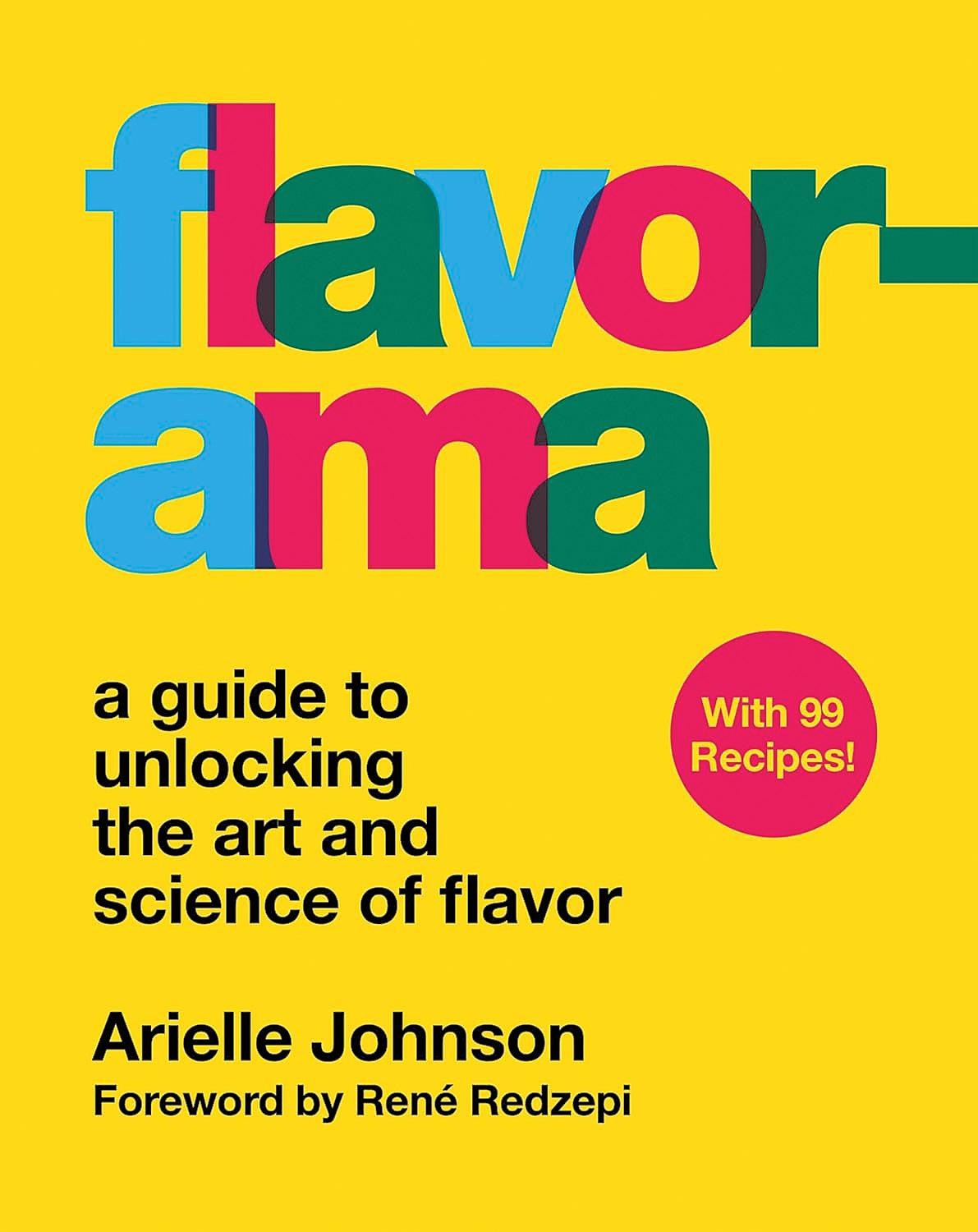
Patience and humility.
You recently spoke at the Summer Fancy Food Show, please share your words of wisdom for emerging brands. Professionally speaking there are so many things I could share, but before you get to that spot it starts with the personal things you need to work on. In order for me to be good at my job, I first had to be okay with me. As soon as I started being me and came out and living my life truly and truly being me and feeling good about it, my professional life took off.
You’ve said that with your success has come the ability to travel. I used to only travel with my stomach and I let my stomach lead the way.
If you’re an adoptee [like me] you know what it means to be chosen into a family and chosen by any family and wanting to travel [means imagining a life] that possibly could’ve been my own. My desire to travel is more a curiosity of people and cultures, the food is a natural part of that.
You’ve said that you don’t like trends since the personality and uniqueness of a dish can be lost once everyone is doing the same thing.
The opposite of trends is when you see an individual story and a stamp on somebody that is different. You just have to tap into you and that will be inherently different. Exceptional food comes with a story.
Johnson revels in details and examples, telling you to oil salad greens before salting them for more lively saltiness (salt dissolves poorly in oil). She points out that glutamate, which is responsible for our sensation of umami, is much more powerful in the presence of ribonucleotides, and helpfully provides a list of ribonucleoitide powerhouses.
Throughout Flavorama, Johnson provides simple recipes demonstrating the principles she elucidates,
some of them seeming to defy cautious common sense. But that’s why you’re paying attention to someone who knows so, so much.
Editor’s Note About Podcasts- Listen and subscribe wherever you get your podcasts, including on Apple Podcasts, iHeart, Spotify, Stitcher, Google Podcasts, Audible & more.
Join Chris Spear as he interviews food and beverage entrepreneurs who have taken a unique path in the culinary world. His guests include caterers, research chefs, personal chefs, cookbook authors, food truck operators, farmers, and more – all individuals who have paved their own way in the culinary world. With over 30 years of experience in the hospitality industry, including his own
personal chef business, Perfect Little Bites. Chris is dedicated to helping others grow and succeed in the food and beverage industry. His guests include caterers, research chefs, personal chefs, cookbook authors, food truck operators, farmers, and more – all individuals who have paved their own way in the culinary world. Tune in to hear their inspiring stories and valuable insights on the road less traveled in the food and beverage industry.
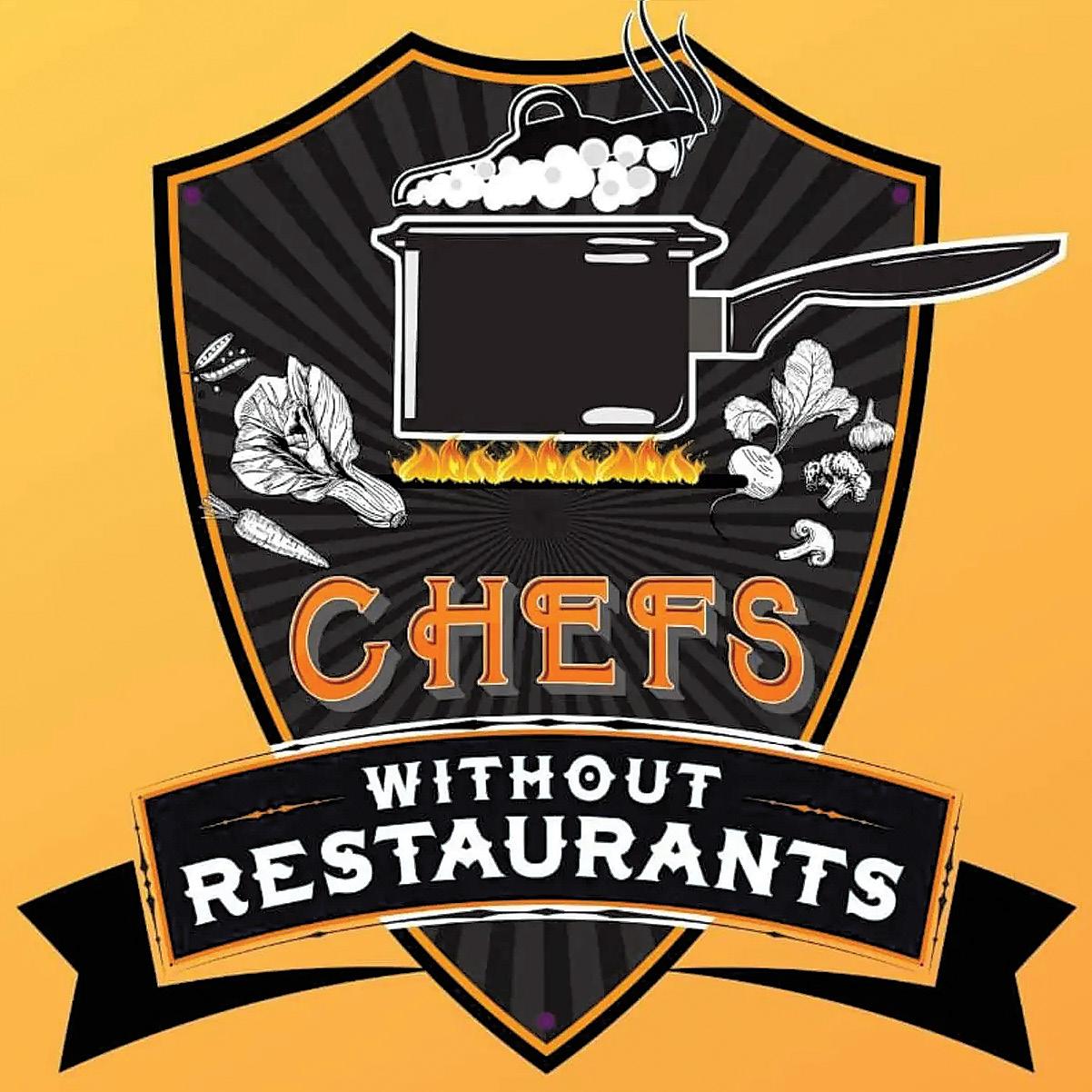


of fried foods without needing to hire professional kitchen staff.
4. Increased Revenue Opportunities
The addition of hot food offerings can significantly increase revenue for convenience stores. Hot food items tend to have higher margins than prepackaged snacks and drinks, and they often drive impulse purchases. By offering a variety of hot foods, stores can attract more customers, increase the average ticket size, and differentiate themselves from competitors. The versatility of compact equipment also allows stores to rotate their menu offerings, keeping customers interested and encouraging repeat visits.
5. Improved Food Quality and Consistency
AutoFry’s enclosed system ensures that food is cooked consistently and to the highest standards of quality. By automating the frying process, operators can ensure that every order is cooked to perfection, eliminating the risk of human error. This level of consistency is critical for maintaining customer satisfaction and building a loyal customer base.
6. Enhanced Customer Experience
The addition of foodservice offerings can significantly enhance the overall customer experience. Custom -
ers appreciate the convenience of being able to pick up a hot meal or snack while they are refueling or grabbing essentials. By offering high-quality food items that are prepared quickly, convenience stores can increase customer satisfaction and build a reputation for great food, not just convenience.
Before adding foodservice equipment like AutoFry to your convenience store, there are a few key considerations to keep in mind:
• Menu Development: Start by developing a simple, versatile menu that can be executed with the equipment you choose. Focus on items that are easy to prepare and have broad appeal.
• Customer Flow: Make sure to consider how the addition of foodservice equipment will affect customer traffic flow within the store. Place equipment in an area that is easily accessible but doesn’t disrupt the overall layout.
• Marketing: Promote your new foodservice offerings both inside and outside the store. Use signage, digital displays, and social media to let customers know that they can now grab a hot meal along with their other purchases.
from page 28
salsa, cherry tomatoes, romaine lettuce, and a guajillo-ranch dressing, finished with crispy tortilla strips – and a Reuben Sandwich with pastrami, Swiss cheese, sauerkraut, and Russian dressing. Seafood lovers can taste test the Poached Halibut with Herb Beurre Blanc, served alongside lemon risotto, English peas, and pearl onions, and the Grilled Salmon with Israeli Couscous with a fire-roasted red pepper sauce and a medley of roasted sweet potatoes, zucchini, and squash, finished with mint. Other dishes featured will include a Chicken Thai Curry Bowl and Beef Short Ribs, served with garlic mashed potatoes and bordelaise sauce.
On Day Two, the lunch menu continues to impress with the Grilled Salmon served alongside a seasonal Autumn Salad. The Beef Burnt-Ends Steam Bun – with smoky beef, pickled watermelon radish, and Asian BBQ sauce – offers a bold, modern twist. Seafood fans will enjoy the Seared Arapaima with cauliflower couscous and vierge sauce. The Seared Chicken Thigh is a rich, comforting dish with semolina vegetables and mushroom sauce, while the Lamb Pave combines tender lamb with Middle Eastern-inspired flavors. Lastly, the BBQ Short Ribs, served with smoked gouda grits and Carolina demi, add a gourmet twist to Southern BBQ.
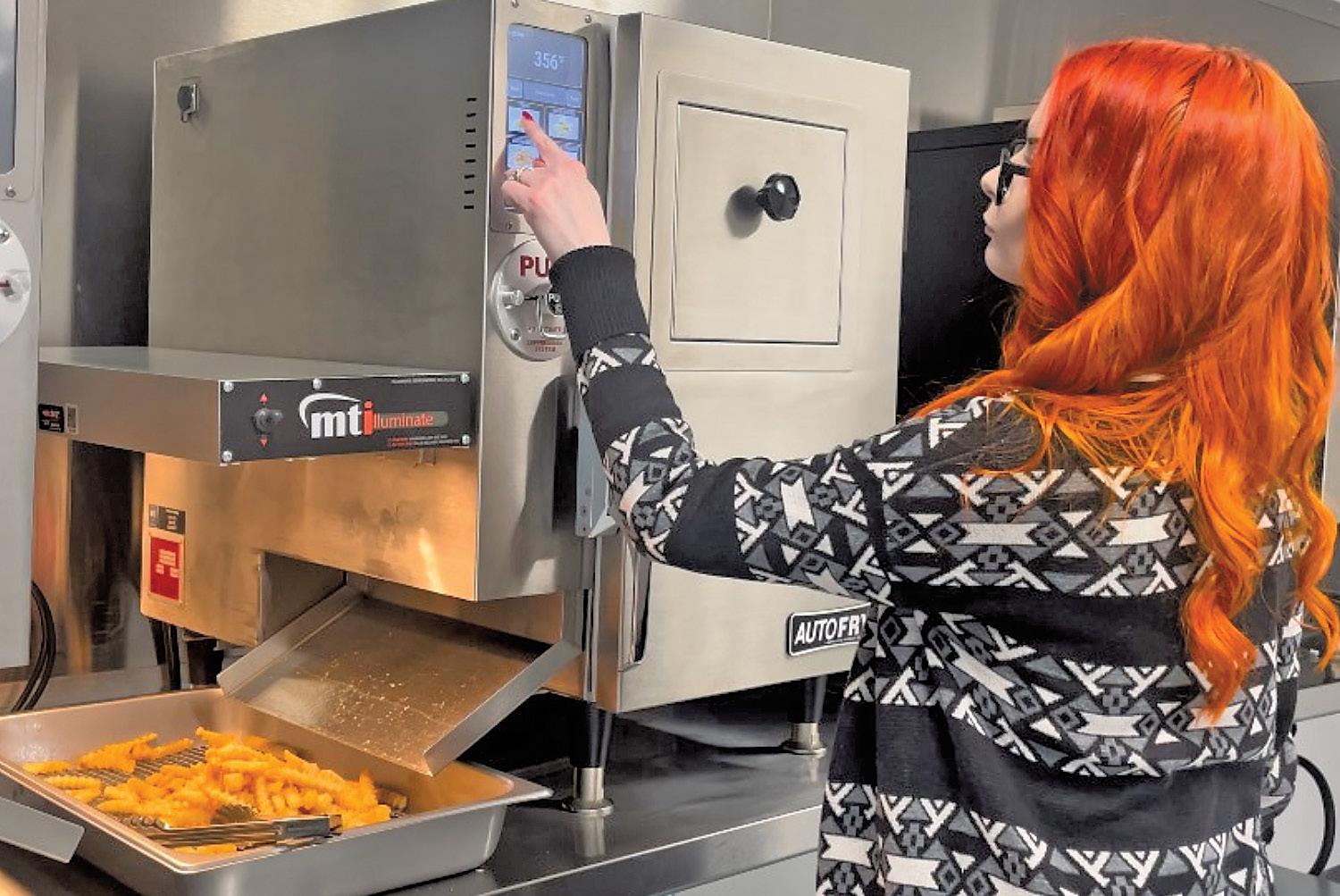
For convenience store operators looking to stay ahead of the curve, attending the 2024 NACS Show in Las Vegas this October is a must. The NACS Show is the premier event for convenience store and fuel retailers, showcasing the latest products, technologies, and trends in the industry.
One of the highlights of the show will be the Motion Technology, Inc. booth (#C4418), where attendees can get a firsthand look at the latest innovations in compact, ventless kitchen equipment, including AutoFry. This is a unique opportunity to see how this
equipment can transform your store’s foodservice offerings, reduce costs, and maximize space efficiency.
Whether you are just starting to explore foodservice options or are looking to expand your current offerings, visiting the Motion Technology booth will give you valuable insights into how to utilize space more effectively and boost revenue with cuttingedge solutions. Be sure to stop by and discover how AutoFry can elevate your convenience store’s foodservice program.
To learn more about how ventless kitchen equipment can benefit your business, visit mtiproducts.com today!
On Day Three, the Oaxacan Beef Jar Salad offers a fresh, Mexican-inspired option with roasted corn, charred tomatoes, romaine, and cilantro dressing. The Sliced Turkey Sandwich features fig jam, arugula, cheddar, and brie, balancing savory and sweet flavors. The Crab Cake – paired with charred corn and an Old Bay-red curry sauce –is a seafood highlight. Another seafood choice, the Stuffed Halibut, with fennel-tomato and lobster sauce, is rich and flavorful. The Seared Chicken Breast – served with spelt and smoky tomato sauce – offers an earthy, rustic meal. Lastly, the Braised Short Ribs – served with corn tamale cake and shallot red wine
sauce – provide a melt-in-your-mouth experience, topped with crispy onions for texture.
About Cuisine Solutions: Led by an international team of award-winning chefs, Cuisine Solutions is the world’s leading manufacturer of sous vide products — the innovative, precisecooking technique the company pioneered, perfected, and popularized decades ago. Headquartered in Sterling, Virginia, Cuisine Solutions services more than 30,000 restaurants and 6,000 retailers, as well as major airlines and hotels. For more information, visit www.cuisinesolutions.com.
maintenance needs just as easily as they can service a multi-location chain or a major hotel kitchen.
One of the key differentiators for the Scientific Group is its experience with large, complex projects. Kaufman’s team has worked on massive builds, from hotels to office towers, where coordination across multiple trades is critical. These experiences have provided them with the knowledge and resources to apply the same level of precision and coordination to much smaller, intricate kitchen projects.
“Building a hotel is no small feat,” Kaufman added. “You’re dealing with plumbing, electrical, HVAC, fire safety—all at once. The same goes for a kitchen, though on a smaller scale. We apply the lessons we’ve learned from these large-scale projects to kitchens, allowing us to approach every aspect of a kitchen’s operation with the same rigor.”
Their proprietary technology plays a major role in their operational success. Scientific Group has invested in developing their own tech platforms to manage communication, service scheduling, and predictive maintenance. This technological edge allows their technicians to anticipate issues before they become major problems, minimizing downtime and ensuring that their clients’ kitchens are always running at peak performance.
For example, Kaufman points to the use of artificial intelligence (AI) in their operations. By analyzing equipment usage data, the Scientific Group can predict when a piece of equipment might fail and schedule a preventive maintenance visit before it becomes a costly emergency repair.
While many kitchen service providers operate on a reactive basis, responding only when something breaks, the Scientific Group prefers to take a proactive approach. They offer comprehensive preventive maintenance programs, allowing them to catch problems early and reduce the likelihood of a catastrophic breakdown. “Preventive maintenance is key,” Kaufman emphasized. “It’s always cheaper to fix a small issue before it turns into a big problem. For example, something as simple as
changing a belt on an exhaust fan might seem insignificant, but that fan going down in the middle of a busy dinner service could cost the restaurant thousands in lost revenue.”
By maintaining equipment regularly, the Scientific Group not only extends the lifespan of the kitchen’s critical systems but also saves clients money in the long run. This forwardthinking approach is a key part of why so many large chains and restaurant groups have turned to Scientific as their go-to service provider.
The success of any foodservice operation is predicated on a kitchen that runs smoothly. Whether you’re operating a single location or managing multiple restaurants, Scientific Group’s turnkey service solutions can provide you with the peace of mind that your kitchen is in capable hands.
If you’re looking to protect your investment, reduce downtime, and streamline your kitchen operations, connect with Scientific Group today. Their comprehensive suite of services, combined with cutting-edge tech -
nology and a proactive maintenance approach, ensures that your kitchen will be running efficiently, allowing you to focus on what matters most— serving your customers.
To learn more or to schedule a consultation, visit scientificgroup.com or reach out to their business development team. Discover how Scientific Group can help your kitchen scale new heights while saving you time and money.

and pizzeria owners placed in Galaxy’s equipment.
But this expansion also brought challenges. “We had to customize the ovens for 40 different pizzeria owners, each with slightly different requirements,” Inan explained. “We embraced the challenge, and I’m proud to say all of them were fully satisfied, without exception.” The festival, held outdoors with temperatures reaching 85°F, put the ovens to the test. They ran non-stop from 7 AM to 10 PM, showcasing their durability and resilience in the face of demanding conditions.
Behind the scenes, Galaxy Group and its dealer partner, Beast Equipment, worked tirelessly to ensure the festival’s success. “We had six technicians on-site, ready to troubleshoot any issues and assist the chefs,” Inan shared. This handson support helped maintain the smooth operation of the ovens throughout the festival, allowing the chefs to focus on delivering high-quality pizzas.
The logistics of preparing for the event were just as meticulous. “All ovens were uncrated and tested at our headquarters in Kearny, NJ, before being delivered to the site,” said Inan. “We delivered all 40 ovens five days prior to the festival and spent the next four days setting up and thoroughly testing each one to ensure they were ready for the event.” This level of preparation speaks to Galaxy’s commitment to excellence and their attention to detail.
One of the key selling points of the
page
unique set of hurdles,” said Berentzen. “There’s a lot of potential here, especially with developments like Audi Field and The Wharf bringing in more foot traffic. Buzzard Point is emerging as a hotspot, and we wanted to be at the forefront of that growth.”
However, the COO acknowledged that the broader uncertainty caused by the elimination of tipping has caused the company to reconsider its pace of expansion within the district. “We’ve slowed down our growth plans in the city,” he explained. “It’s essential to see how these legislative changes fully play out before committing to more loca-
Pegasus oven line is its versatility. As Dave Rourke, Director of Sales at Galaxy Group, explained, “We designed Pegasus pizza ovens to cook a wide variety of pizzas. With more than 35 pizzerias attending the event, it was the perfect opportunity to demonstrate how adaptable our ovens are to different pizza styles.”
The ovens performed flawlessly under a wide range of cooking conditions. “The event featured everything from thin-crust New York-style pizzas to thick deep-dish varieties,” Rourke noted. “Pegasus ovens handled them all without missing a beat, showing just how flexible and reliable they are in a fastpaced, high-pressure environment.”
Not only were the ovens adaptable, but they also proved to be incredibly durable. “We’ve engineered an extremely heavy-duty oven that performs exceptionally well in demanding conditions,” Rourke added. “The One Bite Pizza Fest allowed us to showcase the robustness of our ovens, proving their ability to handle tough, real-world situations.”
The Pegasus ovens aren’t just known for their performance but also for their competitive pricing. As Inan emphasized, “We use the same components as the most reputable American pizza ovens. For example, we incorporate Robertshaw gas valves and thermostats, and Maxitrol regulators. Thanks to our lean manufacturing process, we’re able to offer the same high quality to the market at a lower price point.”

This combination of quality and affordability has helped Galaxy Group establish a strong foothold in the competitive pizza oven market. And the feedback from the festival has only strengthened their reputation. “Some chefs mentioned that our stone provided better cooking performance than the ovens they use in their own stores,” Inan noted. Such positive feedback demonstrates that the Pegasus line is making a significant impact on the industry.
Looking ahead, Galaxy Group is focused on continued growth and innovation. “We’re committed to building out both the Galaxy and Pegasus brands,” said Rourke. “This event was a fantastic opportunity to get our brand in front of quality pizzeria operators in the metro New York area and beyond.” By introducing their ovens to a broader audience at One Bite Pizza Fest, Galaxy Group is opening new doors for future collabora-
tions and business growth.
Rourke also shared his vision for the future: “We’re planning to expand our product line while maintaining the high standards of quality and efficiency that our customers expect. We’re exploring new technologies that can further improve energy efficiency and operational performance, and we’re excited about what’s ahead.”
Galaxy Group’s participation in the One Bite Pizza Fest this year was not just a chance to showcase their ovens, but a significant step in their journey toward becoming a leader in the pizza equipment industry. As they look toward the future, Galaxy’s Pegasus ovens will continue to play a central role in helping pizzerias around the country deliver consistently highquality pizza, no matter the style or the environment.
tions. We’re fortunate that we have the size and resources to weather this storm, but for smaller operators, it’s a much tougher landscape.”
Berentzen also mentioned plans to expand the company’s catering division. With 70 kitchens across its different brands, Thompson Restaurants is wellpositioned to leverage its infrastructure to offer full-service catering, drop-off catering, and private events. “Catering is a natural extension of our restaurant business,” Berentzen explained. “We’re in talks with several local companies for potential partnerships, and we see this as a key growth area moving forward.”
As Thompson Restaurants continues to expand with the opening of Hen Quarter Prime, the company faces the dual challenge of navigating legislative changes and keeping its growth trajectory on track. However, with a solid strategy and a focus on adaptability, the company is poised for continued success. For Berentzen and his team, the future looks bright—even in the face of challenges. “We’re excited about what’s ahead,” he concluded. “Hen Quarter Prime is just the beginning of our next phase. We’re committed to delivering exceptional dining experiences, no matter the market.”
Despite the current challenges in DC, Thompson Restaurants continues to eye opportunities for growth—both within and beyond the district. The company has plans to open several new restaurants in Virginia Beach and Norfolk in the near future, expanding its reach along the Eastern Seaboard. “We’ve been focusing on markets where we see the most potential for sustainable growth,” concluded Berentzen. “Our next few locations will likely be outside of DC, but we’re still very committed to the MidAtlantic region.”
chips to mushroom jerky, exhibitors like MyForest Foods and Popadelics demonstrated how plant-based ingredients are evolving to meet consumer demand for healthy, grab-and-go snacks. These snack options tap into the growing consumer interest in sustainability and clean eating, providing a fresh approach for foodservice operators looking to expand their snack offerings.
“By adding plant-based snacks to their menus, restaurants can offer healthier alternatives without sacrificing flavor,” Davis said. “Consumers today want more than just traditional meal items— they’re seeking a full spectrum of plantbased foods, including snacks and graband-go options.”
Another key takeaway from this year’s Expo was the emphasis on chef-driven plant-based innovations. Products from Konscious, featuring plant-based salmon topped with fishless caviar, and Imposter Foods’ dairy-free mozzarella sticks, captured the attention of culinary professionals seeking to elevate their menus with unique plant-based dishes.
Davis noted that these chef-inspired creations are particularly appealing to foodservice operators looking to enhance their appetizer and bar menus. “Tapas-style, shareable plates are a perfect opportunity for operators to experiment with plant-based ingredients,” he said. “Offering unique, chef-crafted options can set your restaurant apart and attract curious diners.”
One of the key selling points of plantbased menus is their alignment with health-conscious dining trends. Research continues to link plant-based diets with reduced risk of chronic diseases, including heart disease and diabetes. Incorporating nutrient-dense ingredients like hemp, algae, and seaweed allows operators to position their menus as health-forward.
Additionally, the lower environmental impact of plant-based foods compared to traditional meat and dairy makes these options attractive to eco-conscious consumers. Brands like Oatly and Gardein emphasized their sustainability credentials at PBW, reinforcing that plant-based
foods can play a critical role in reducing the carbon footprint of the foodservice industry.
“Offering plant-based options is not just about catering to a niche market— it’s about meeting the growing demand for healthy, sustainable choices,” Davis said. “Consumers are becoming more conscious about where their food comes from and how it impacts the planet. Restaurant owners who tap into this demand will see increased customer loyalty and repeat visits.”
As more consumers shift toward plant-based diets—whether for health, ethical, or environmental reasons—restaurants that fail to adapt risk missing out on a rapidly growing market. Flexitarians, vegetarians, and vegans are actively seeking out establishments that offer a variety of plant-based options.
By incorporating these offerings, operators can tap into a larger customer base and increase their revenue. “The number of people seeking plant-based foods continues to grow, and it’s crucial for restaurant owners to keep up with

guests you care about their health. Protection you can count on, from the brand you trust. For each case purchased, Elara
that demand,” Davis emphasized. “Offering a few key plant-based dishes on your menu will attract a diverse group of diners, from vegans to those simply looking to make healthier choices.”
As the plant-based movement continues to gain momentum, the 2024 Plant Based World Expo set the stage for future developments. “The energy and excitement at this year’s Expo were truly inspiring,” Davis concluded. “We’ve already seen a significant portion of next year’s exhibit space reserved, with global exhibitors returning to showcase the future of plant-based foods. “If you’re a restaurant operator looking to stay competitive and offer your customers the best in plant-based dining, PBW is an event you simply can’t afford to miss. For restaurant owners and foodservice professionals, attending PBW provides a unique opportunity to stay ahead of the curve in an industry that’s rapidly evolving. With the event returning to New York City on September 11-12, 2025, the Expo promises to bring even more innovative plant-based products to the forefront.”
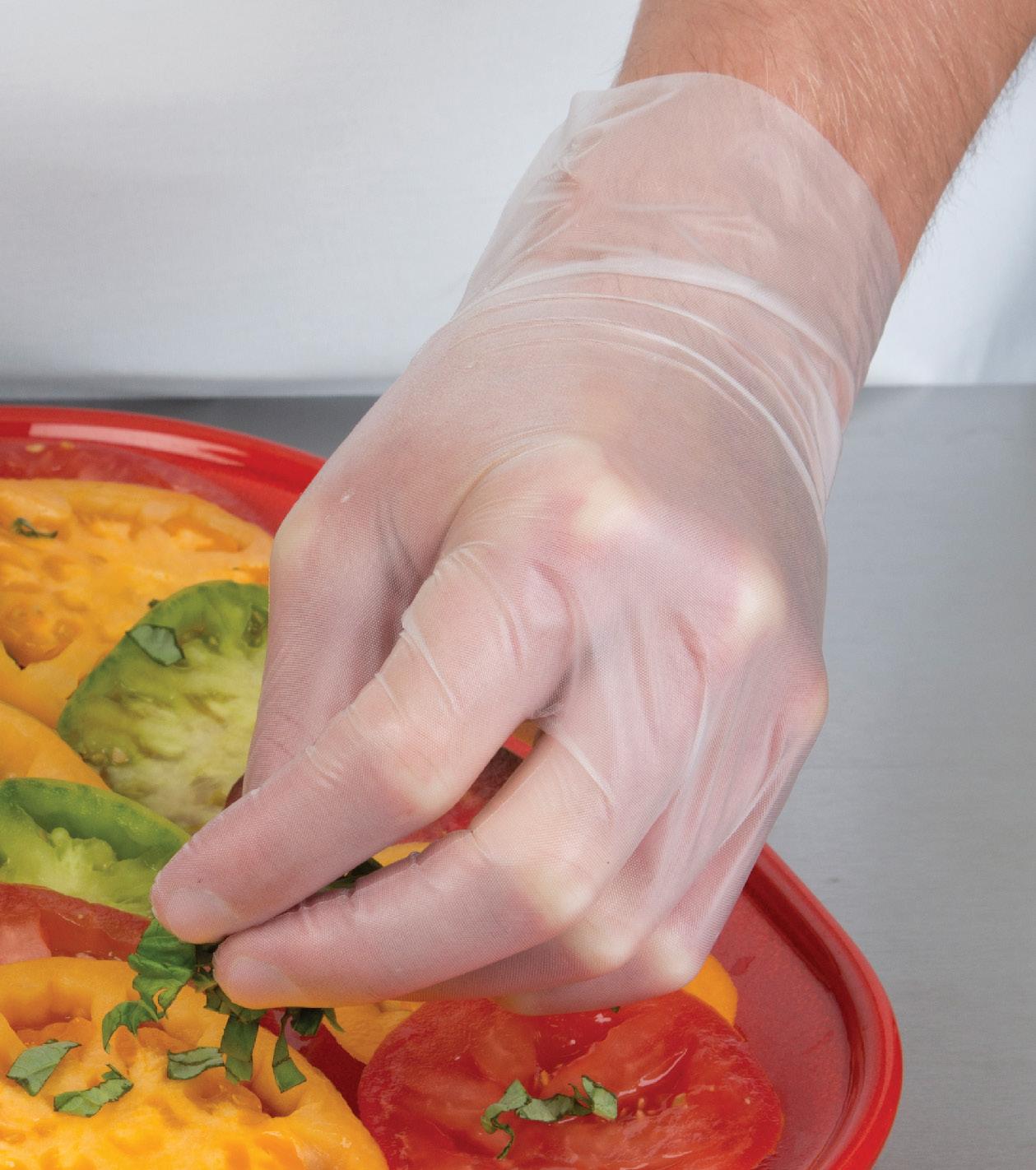
Center Live Session and Learn Practical Solutions to the “New” PAGA Environment featuring dynamic speakers.
Dozens of restaurant owners and their staff took advantage of the Restaurant Management 201 Workshop led by Darren Dennington and Alison Anne who guided management teams through the process of becoming a cohesive team with strong leadership.
The newly branded Culinary Innovation Theater featured Distinguished American Chef Rocco DiSpirito (left), James Beard Award Winning Chef Stephanie Izard, owner of Girl and the Goat and Cabra, Plant-based Chef Nina Curtis, Founder of Chefs Feeding Kids Glenn Cybulski, Chef and Author Eric Greenspan as well as two culinary demonstrations from Sysco Foods, sponsors of the theater. All the chefs showcased their
from page 54
skills and shared their culinary secrets and engaged in conversation with the theater’s emcee Deanna “Bomb Chica” Colón, Chef and Food Personality. The Culinary Innovation Theater also featured the Rapid-Fire Sizzling Skirt Steak Competition sponsored by Sysco. Judges Deanna Colón, Michael Horn, Host, What’s Cooking Today on CRN and Sysco Chef Steven Mary presented the winning trophy and $1,000 to Melissa “Chef Mel” Cottingham, Private Chef/Owner, Melnificent, for her Skirt Steak Wrapped in Prosciutto.
Pizza Tomorrow Summit Pavilion was a new feature area on the show floor featuring the California Pizza Challenge (CPC) sponsored by REAL California Milk, celebrating California’s long history of producing some of the country’s finest cheese. The CPC, hosted by the US
personal touch, they can create visually stunning, Instagram-worthy menu items that attract social media attention and draw in new customers. The possibilities are endless, and the results are sure to be a hit.”
Since their introduction, Rich’s Filled Donut Bites have quickly gained popularity among consumers, particularly Gen Z, who value both convenience and indulgence.
“Our market testing and customer feedback have been overwhelmingly positive, especially among younger consumers who appreciate the indulgence and portability of our Double Chocolate Filled Donut Bites,” Barrett shares. “They’ve become a go-to snack for many, which speaks to their wide appeal and market potential.”
Rich’s Donut Bites offer operators flexible preparation options to suit different service models. Whether choosing to thaw and serve or heat and serve, these donut bites maintain their quality and taste. Additionally, with a one-day ambient shelf life, operators can manage inventory effectively, reducing waste and ensuring that customers always receive a fresh product.
“Our donut bites are easy to prepare, which is a critical factor for operators managing busy kitchens,” noted Barrett. “This ensures that they can always have a fresh batch ready for customers, no matter the time of day.”
When it comes to pricing, Rich’s Donut Bite Portfolio is competitively positioned, offering operators a high-margin product that can drive sales and
Pizza Team featured four culinary events to showcase California cheese, as well as four Pizza Athletic categories.
Congratulations to all the competitors of the California Pizza Challenge sponsored by REAL CALIFORNIA MILK. Giovanni Labbate of Tievoli Pizza Truck in Palatine, IL took home top honors in Non-Traditional, the main culinary event of the day. 2nd place was awarded to local legend and US Pizza Team member Alex Koons of Hot Tongue in L.A. 3rd place was USPT member Jamie Culliton of The NONA slice house in Safety Harbor, FL.
The largest dough stretch and the fastest pie maker events also took place. Taking first place in the largest dough stretch was USPT member McKenna Carney of The Nona Slice House. 2nd place was awarded to Wilhem Rodriguez
profitability. Additionally, Rich’s provides comprehensive marketing support, including promotional materials, to help operators introduce these donut bites to their customers.
“We understand that introducing a new product can be challenging, so we offer robust marketing support to help our operators succeed,” says Barrett. “From in-store displays to digital assets, we provide everything needed to effectively promote and sell our donut bites.”
The Rich’s team also offers a full portfolio of marketing solutions to support the addition of the new donut bites to operator menus.
“Our goal is to help our operator partners and the distributors that serve them with inspiration to create limited-time offers (LTOs). These special editions are designed to drive repeat purchases and generate buzz during key times of the year. “This could be something as simple as a birthday cake filled donut bite to celebrate the operator’s anniversary. Seasonal LTOs are a great way to keep the product fresh and exciting for customers “
For operators interested in adding Rich’s Donut Bites to their menu, samples and additional product information can be requested through Rich’s website. Don’t miss the opportunity to elevate your snack offering and delight your customers with these irresistible, on-trend treats.
Visit richs.com to request samples and learn more about Rich’s Filled Donut Bites and other innovative products in their portfolio.
of Papa’s Pizza in Cabo Rojo, Puerto Rico. Jamie Culliton of The NONA slice house in Safety Harbor, FL. placed 3rd. David Whisker of B.C. Pizza in Boyne City, MI. won 1st place in the Fastest Pie Maker division. Grabbing 2nd and 3rd respectively were McKenna carney and Jamie Culliton.
The 2025 California Restaurant Show and Pizza Tomorrow Summit Pavilion will take place August 5-7 at the Anaheim Convention Center. The shows are owned by Restaurant Events, LLC which also produces the Florida Restaurant Show and Pizza Tomorrow Summit, to be held November 6-7, 2024, at the Orange County Convention Center in Orlando, FL, and the New York Restaurant Show taking place March 23-35, 2025 at the Javits Center in New York City.
from page 82
York City’s streets safer and cleaner but also help local businesses, including restaurants, foster stronger community ties.
These grants empower neighborhood organizations to create safe, vibrant commercial districts. For restaurants, this is essential. When diners feel comfortable walking through a neighborhood and see a bustling, lively community, they are more likely to spend time—and money— at local eateries. Initiatives like beautification projects, enhanced sanitation, and storefront improvements are critical investments that will encourage both locals and tourists to frequent neighborhood businesses, ensuring a thriving ecosystem for everyone.
New York City’s focus on small businesses and the tourism industry is more than just a lifeline; it’s an opportunity for restaurateurs to thrive. With reduced vacancy rates, targeted financial support, and nyctourism.com acting as a bridge between the city’s events and local dining, restaurants can expect a boost in traffic, exposure, and community engagement.
As we look toward the future, it’s clear that the restaurant industry will play a pivotal role in New York City’s continued recovery and growth. The potential for restaurateurs to tap into new audiences, leverage citywide events, and become an integral part of revitalized neighborhoods is immense. With the right strategies in place, this new era of collaboration between the city and small businesses will help New York City’s restaurant industry continue to be the best in the world. And as anyone who’s ever enjoyed a great meal in this city knows—when restaurants succeed, New York City thrives.

from one part of the kitchen to another or using a restroom mop in the kitchen or front of house.
At York Building Services, we take this risk seriously, which is why our teams are continuously trained to meet the latest standards of sanitation. By ensuring that proper protocols are followed consistently, we help reduce the risk of foodborne illness outbreaks. This is especially important in today’s environment of social media transparency, where one bad review or viral video can irreparably damage your business.
Your reputation as a restaurant or food service operator is more fragile than ever. Social media amplifies even the smallest mistakes, meaning that one instance of poor hygiene or a health code violation can spread quickly and discourage potential customers. In this day of instant online reviews, it’s critical to maintain impeccable hygiene standards.
Professional cleaning services help you stay ahead of any potential issues by ensuring that your kitchen meets or exceeds health and safety standards ev-
ery day. We’ve seen time and again how a clean kitchen not only protects a restaurant’s reputation but also boosts employee morale. When a chef walks into a spotless kitchen, it sets the tone for the day and creates a positive working environment, where cleanliness and attention to detail are valued.
It’s not just about cleanliness—regular professional cleaning also helps maintain your kitchen equipment. Commercial kitchens operate nearly 24/7, and the daily wear and tear on ovens, grills, and stove tops can be intense. Improper cleaning practices can lead to significant damage, reducing the lifespan of your expensive equipment and resulting in costly repairs or replacements.
I’ve seen this happen too many times—cleaning staff flooding hot kitchen equipment like stoves and grills, which can cause rust, cracking, and malfunctioning. In some cases, kitchen staff have failed to properly clean and relight gas burners, causing delays in the morning that halt food preparation. When professional cleaning is performed cor-
rectly, we not only clean surfaces but also ensure that equipment is properly maintained, helping to avoid unnecessary downtime and repair costs.
The legal consequences of poor kitchen hygiene are often underestimated. Fines from the Department of Health are only the beginning; a serious foodborne illness outbreak could result in lawsuits and permanent damage to your business. By investing in professional cleaning, you’re not just buying a service— you’re buying peace of mind.
We help you stay compliant with the regulations and avoid the reactive, lastminute scrambles that often follow a DOH inspection failure. Working with professional cleaners means staying proactive and preventing problems before they arise.
Not all cleaning services are created equal. When vetting a professional cleaning company, it’s important to look for experience and specialization in your specific type of operation. Whether you run a fast-paced restaurant or a USDAregulated commissary, the cleaning ser-
vice you choose should have experience in your industry.
Ask for client references, check certifications, and make sure the company understands the unique challenges of your operation. At York Building Services, we pride ourselves on being an extension of your management team, ensuring that all of our clients—from small restaurants to large commercial kitchens—receive the highest standards of service and support.
At the end of the day, outsourcing your kitchen cleaning allows you to focus on what you do best—running your restaurant and serving your customers. Just as you wouldn’t handle payroll in-house if you’re not an expert, you shouldn’t leave cleaning to chance.
By partnering with a professional cleaning service, you can ensure the health, safety, and reputation of your business, while reducing costs and staying compliant. Trust the experts to handle the dirty work so that you can concentrate on what matters most—delivering an exceptional dining experience to your customers.
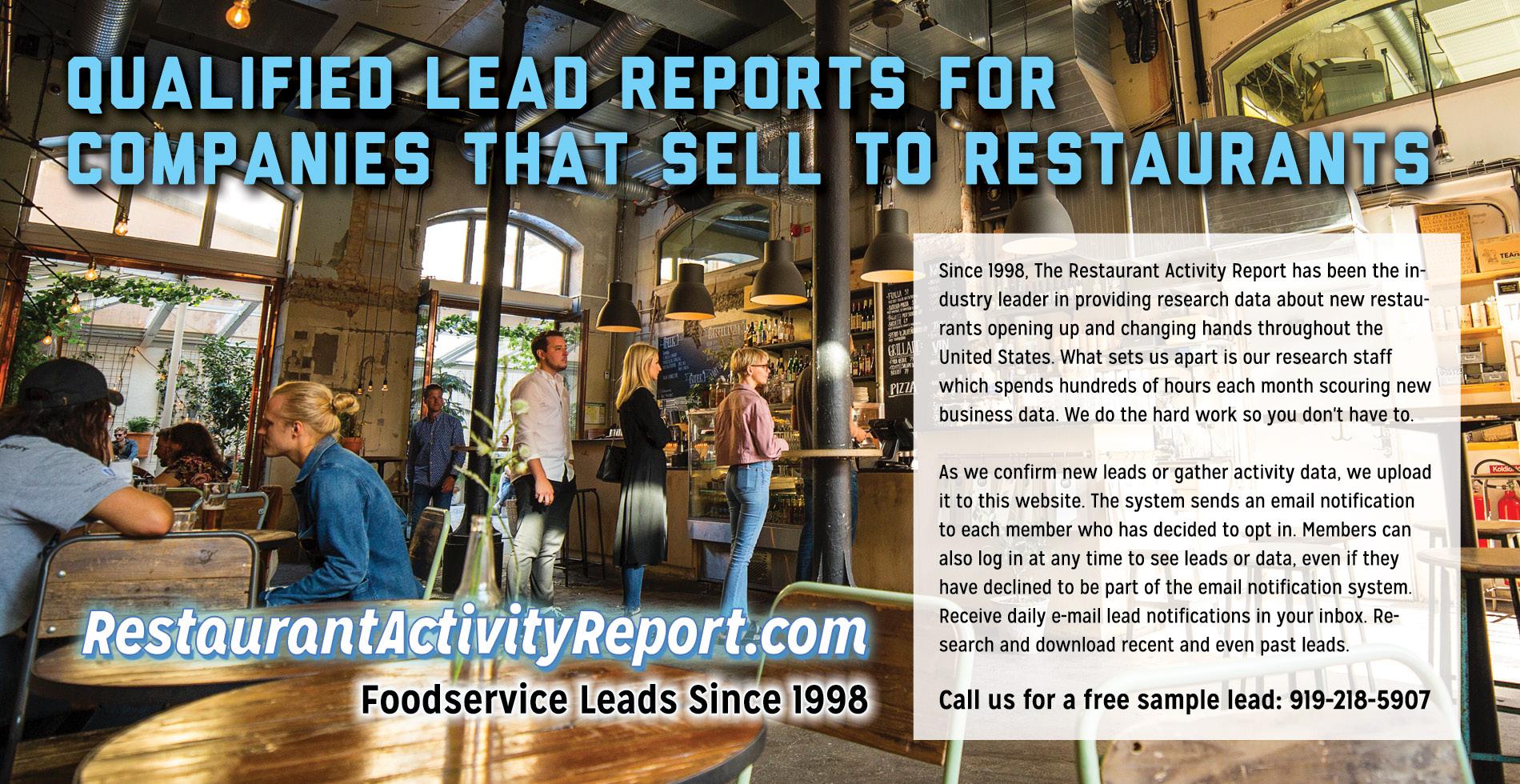

local pizzerias a platform to experiment with new ingredients, test innovative oven technology, and develop strategies for incorporating fresh pizzas into their existing menus. The star of the show was the PizzaGroup USA Dragon oven, a stone conveyor oven known for its ability to bake pizzas faster and more consistently than traditional gas ovens.
“This event wasn’t just about showcasing new equipment,” Hernandez explained. “It was about helping pizzerias grow their businesses by adding more efficiency and flexibility to their operations. We showed them how our technology, like the Dragon oven, can help increase production capacity without compromising the quality of their pizza.”
The ability to quickly and efficiently bake pizzas has become crucial for pizzerias facing rising labor costs and increased customer demand. Attendees of the NJ Pizza Jam were treated to hands-on demonstrations that allowed them to experience firsthand how ovens like the Dragon can dramatically reduce baking times while maintaining the authentic taste and texture that pizza lovers expect.
“One of the most exciting parts of this event was seeing how eager pizzeria owners were to try new things,” Hernandez added. “Many of them left the event with ideas for new pizzas to add to their menus and more confidence in their ability to meet demand during busy times.”
Another key factor in 24/7 Restaurant Equipment’s success at the NJ Pizza Jam has been the addition of Jeanette Catena to their team. With over 14 years of experience in the pizza industry, Catena brings a wealth of knowledge about both the technical aspects of baking and the critical role of high-quality ingredients. “Jeanette has been a game-changer for us,” said Hernandez. “She understands how the right combination of ovens, ingredients, and technique can elevate a pizzeria’s offerings. With her expertise, we can now provide our clients with even more tailored solutions—not just for cooking pizza, but for perfecting the dough, balancing toppings, and
ensuring every pie comes out exactly right.”
One of the biggest challenges pizza professionals face today is ensuring that their ovens and ingredients work in harmony. A poorly calibrated oven can overcook the cheese or underbake the crust, leading to a disappointing final product. With Catena on board, 24/7 Restaurant Equipment has been able to expand its services, offering expert guidance on everything from oven temperature settings to ingredient selection.
“At the NJ Pizza Jam, we saw a huge interest in how different cheeses, sauces, and even oils affect the baking process,” Catena said. “We showed participants how making slight adjustments in their ingredient choices or oven settings could make a huge difference in the final product. That’s something that really resonated with the chefs at the event.”
For 24/7 Restaurant Equipment, the NJ Pizza Jam Fall 2024 was more than just an event; it was a strategic opportunity to solidify its place as a leader in the pizza industry. As pizzerias look to innovate and expand their menus, 24/7 Restaurant Equipment has positioned itself as the go-to partner for any pizzeria looking to modernize its operations.
“The NJ Pizza Jam gave us an opportunity to connect directly with our customers and hear about their challenges,” said Hernandez. “It’s events like this that help us stay ahead of the curve. We’re not just selling equipment; we’re building relationships and helping businesses thrive.”
Hernandez also spoke about the future plans for 24/7 Restaurant Equipment, including expanding its product line to incorporate more sustainable and energy-efficient options. With electric ovens like the Dragon becoming more popular, the company is focusing on helping pizzerias reduce their carbon footprints without sacrificing quality.
“While we understand the importance of gas-powered cooking, electric ovens are the future of pizza making,” Hernandez predicted. “Not only do they reduce energy consumption, but
they also provide a more consistent bake. We’ve had some pizzeria owners who were skeptical at first, but after seeing the results at NJ Pizza Jam, they were convinced. We’re excited to help more businesses make that switch.”
Looking forward, 24/7 Restaurant Equipment plans to continue its expansion in the pizza industry by focusing on innovation, sustainability, and education. Hernandez hinted at plans for more events like NJ Pizza Jam, where pizza professionals can come together to learn, share, and grow.
“We’re planning to roll out more educational events in the future,” Hernandez revealed. “The NJ Pizza Jam is just the beginning. We want to create spaces where pizza makers can come to us with their challenges, and we can help them find solutions— not just with equipment but with the knowledge and support they need to succeed.”
As 24/7 Restaurant Equipment continues to grow, it is clear that the com -
pany is committed to not only supplying the tools of the trade but also empowering pizza makers to achieve their creative and business goals.
“Our mission has always been about more than just equipment,” Hernandez concluded. “We’re here to help our clients grow, adapt, and succeed—one pizza at a time.”
Learn more online at https:// 247restaurantequipment.com/


view of their equipment maintenance needs. “Our software gives operators real-time visibility into their repairs and maintenance spending, helping them make informed decisions about whether to repair or replace equipment,” Singh explained. This transparency allows restaurants to track costs, optimize spending, and ultimately reduce downtime.
Additionally, ResQ allows restaurant operators to bring their preferred service providers onto the platform. “If a restaurant already has established relationships with service companies, they can integrate those vendors into ResQ and continue to manage everything seamlessly through our platform,” Singh noted. For restaurants that handle their own kitchen repairs and maintenance, ResQ offers the tools to manage their operations more effectively. The platform provides detailed reporting and analytics, helping operators keep track of repair history, equipment performance, and budgeting needs. “We’ve created a system that allows operators
to make data-driven decisions,” Singh said. “By having all of this information in one place, restaurant operators can focus on running their businesses rather than worrying about equipment breakdowns.” This level of control helps restaurants avoid unexpected expenses and reduces the risk of costly equipment failures.
For commercial kitchen service companies and restaurant operators looking to streamline their operations and improve profitability, getting started with ResQ is simple. Interested parties can visit ResQ’s website and fill out a contact form to learn more about the platform’s offerings. Additionally, service providers can reach out directly to sales@getresq. com to discuss partnership opportunities. Whether you’re a restaurant operator looking to reduce downtime, or a service company seeking to grow your business and improve cash flow, ResQ offers a comprehensive solution that benefits everyone involved in the commercial kitchen ecosystem.


associated with freshness and vibrancy, which can make a drink feel more refreshing and lively. Deep reds and purples, on the other hand, suggest richness and depth, setting the stage for a more complex, indulgent experience.
The choice of garnish is another layer of this psychological dance. A sprig of mint in a tall, slender glass, like the Libbey Slim Can, can evoke thoughts of a summer garden, while a curled citrus peel in a coupe glass adds a touch of sophistication. By carefully selecting the glass and garnish, I’m not just creating a drink; I’m crafting an experience that resonates on multiple sensory levels.
When I craft cocktails, creativity and storytelling are at the heart of my approach. I understand that every detail matters. Glassware isn’t just about function; it’s about creating an emotional connection. When a guest lifts a beautifully crafted glass to their lips, they’re not just drinking—they’re participating in an experience. The weight of the glass, the feel of its contours in hand, the way it catches the light—these tactile and visual elements are all part of the cocktail’s identity.
I often think about the spaces I create and the stories I want to tell through my
craft. Glassware is a part of that storytelling. It’s a way to express identity, culture, and artistry. The glassware we choose is a reflection of our values, our history, and our vision for the future of cocktail culture.
Every glass I choose is chosen with intention, reflecting the narrative I want to share with my guests. Whether it’s a sleek, modern glass for a bold, contemporary cocktail or a vintage-inspired piece that harks back to a different era, the glassware is as much a part of the drink as the ingredients themselves.
Glassware is not just a vessel; it’s an integral ingredient in the cocktail-making process. It shapes the guest’s experience, influences the flavors, and tells a story that goes beyond the drink itself. As beverage professionals, we should never underestimate the power of the glass—it’s the final brushstroke on the masterpiece that is a well-crafted cocktail.
So, the next time you reach for a glass, remember: you’re not just holding a drink; you’re holding an experience, a story, and a piece of art. Find the right partner, connect with the glass and determine who has what you need for all your sensory experiences. Because in every glass, there’s an opportunity to create something memorable, something that connects with the guest on a deeper level. And that, to me, is the true artistry of mixology.
from page 111
lenges and rising food costs, JJS’s Duck Carnitas offer a cost-effective solution for restaurants looking to add a premium option to their menus without significantly increasing expenses. The product is available in various sizes, including 1-pound and 3-pound increments, making it accessible for both small and large establishments.
“Our goal was to create a product that offers great value without compromising on quality,” Michael Jurgielewicz noted. “We’ve priced our Duck Carnitas competitively, so restaurants can offer a high-end dish at a reasonable cost, which is especially important in today’s market.”
ly, replace batteries as needed, and never ignore an alarm. If it sounds, get outside immediately and call 911.
General Safety Measures for Businesses:
• Restaurants and other businesses should install CO detectors and ensure that alarm systems, security systems, and other safety equipment are functioning properly.
• Implement comprehensive emergency management planning, starting with a vulnerability analysis to identify risks. Develop a response plan detailing roles, responsibilities, emergency procedures, and a communication strategy.
• Train employees on the emergency plan, and regularly test and update the plan, ensuring it meets current risks.
Reputation Management:
• If a CO leak or similar crisis occurs, having a clear plan on how to manage the aftermath, including me -
from page 26
dia interaction, is crucial to minimize reputational damage.
Additional Tips:
• Clear snow from vents for fuelburning appliances to prevent CO buildup indoors.
• Avoid using charcoal indoors or in enclosed spaces, as burning charcoal can produce lethal CO levels. By following these guidelines and staying informed about the latest safety standards and practices, you can significantly reduce the risk of CO poisoning and ensure a safer environment both at home and in businesses.
Speak to your insurance advisor to learn more about implementing effective emergency and crisis management plans that include detailed carbon monoxide exposure prevention measures, as well as strategies for recovery. Learn more at https://www.hubinternational.com/industries/hospitalityinsurance/restaurant-insurance/
Joe Jurgielewicz & Son, Ltd.’s Duck Carnitas are more than just a new product—they represent a commitment to innovation, quality, and customer satisfaction. As the restaurant industry continues to evolve, JJS remains at the forefront, offering products that help chefs create memorable dining experiences. With Duck Carnitas, JJS has once again proven that they are not just in the business of selling duck—they are in the business of culinary excellence.
For more information on JJS’s Duck Carnitas or to request samples, visit their website at TastyDuck.com or contact Joey Jurgielewicz at joey@tastyduck.com.


overall brand. That’s why we offer guidance to our clients on layout, font selection, and even the use of high-quality food photography.”
While the DIY Menu Store is the latest offering, Cleveland Menu continues to provide a wide range of menu solutions to suit every type of dining establishment. From custom leather-bound wine lists to sleek, waterproof takeout menus, Cleveland Menu caters to restaurants large and small. Their flagship product, Durapoly – a proprietary synthetic paper that is waterproof and tear-resistant – has become a favorite among restaurants that need menus that stand up to heavy use.
“Our Durapoly menus have been a game-changer for many of our clients,” said Patrick Ramella. “They’re fully recyclable and last much longer than laminated paper menus, which aren’t environmentally friendly. Plus, our synthetic paper is much more durable, meaning fewer replacements and lower costs over time.”
As Cleveland Menu looks to the fu-
ture, they are focused on continuing to innovate and meet the needs of the evolving restaurant industry. The launch of DIY Menu Store is just one step in that journey.
“We’re excited to bring this new service to the market,” Gerry Ramella concluded. “It allows us to scale our business and provide our high-quality menu solutions to a broader range of restaurants. Whether you’re a mom-and-pop diner or a large restaurant chain, you can now have access to the same quality that top-tier restaurants use.”
With its emphasis on quality, speed, and customization, Cleveland Menu is poised to remain the leader in the menu printing industry for years to come.
For more information on the DIY Menu Store or any of Cleveland Menu’s other products, restaurants can visit ClevelandMenu.com, order directly at their ecommerce site at store.clevelandmenu.com, or call their sales team at 1-800-MENU-NOW.
In addition to food safety and visibility, sustainability plays a key role in the development of Inline Plastics’ packaging solutions. Safe-T-Chef® is made from FDA-approved polypropylene, a highly durable and recyclable material. The transparent design facilitates efficient sorting and recycling at Material Recovery Facilities (MRFs), advancing a sustainable food packaging ecosystem.
Cline emphasized Inline Plastics’ commitment to sustainability, stating, “We’re constantly innovating to create packaging that not only meets the functional needs of the foodservice industry but also aligns with environmental sustainability. The Safe-T-Chef® line is part of that larger vision.”
With the expansion of the Safe-T-Chef® line, Inline Plastics continues to meet the demands of a diverse range of foodservice applications. From single-serve meals to larger, family-sized portions, Safe-T-Chef® offers solutions for all types of food operators. The expanded options, tamper-evident security, and anti-fog clarity elevate Safe-T-Chef® to the
premier choice for businesses delivering premium food experiences.
“The beauty of the Safe-T-Chef® line is that it caters to every type of foodservice operation, from mom-and-pop restaurants to large supermarket chains,” Cline remarked. “We listen to the feedback from our customers and use that input to continually improve our products. It’s about delivering packaging that truly makes a difference in day-to-day operations.”
Inline Plastics is committed to supporting foodservice operators and the distributors that serve them by offering a robust portfolio of packaging solutions designed to enhance food safety, visibility, and operational efficiency.
To learn more about how Inline Plastics’ Safe-T-Chef® and other innovative packaging solutions can elevate your foodservice business, visit InlinePlastics. com or contact their sales team directly to request samples and explore customized options.



